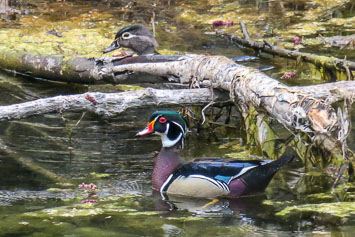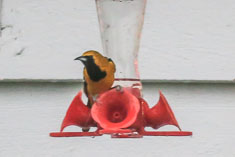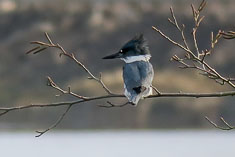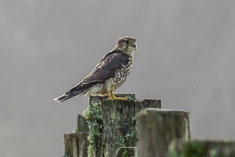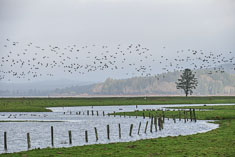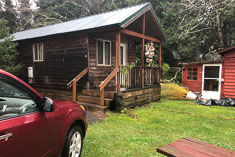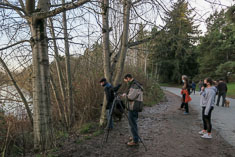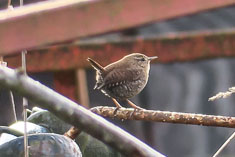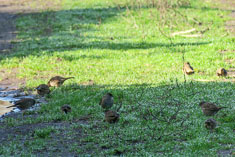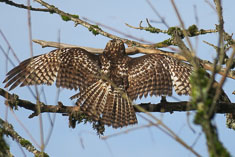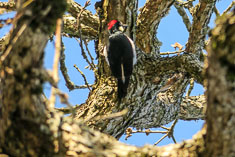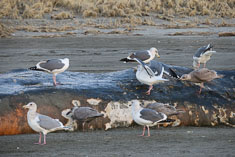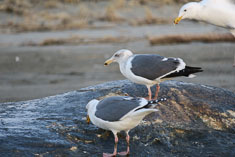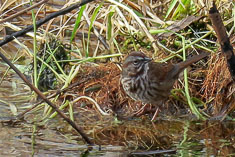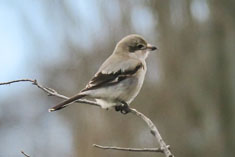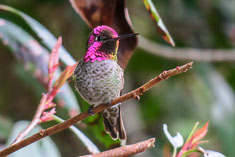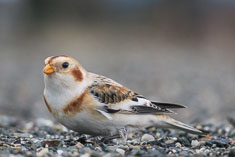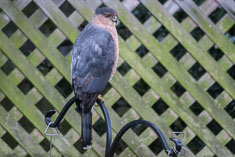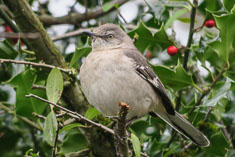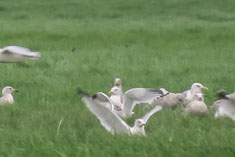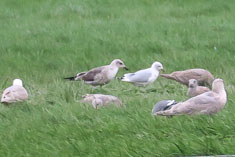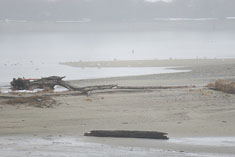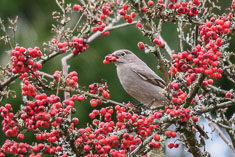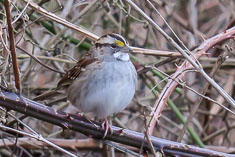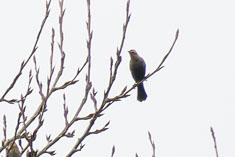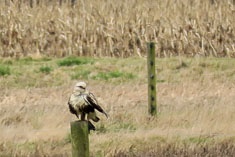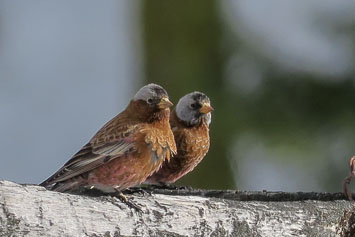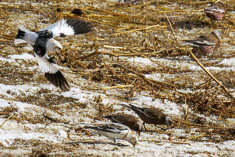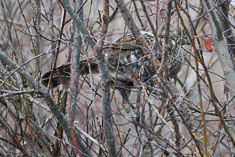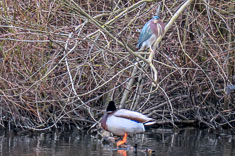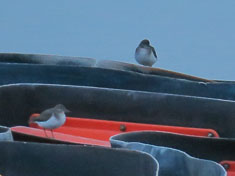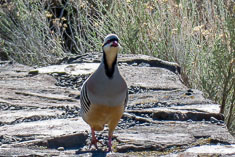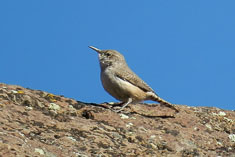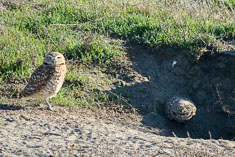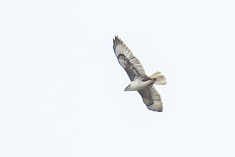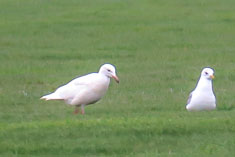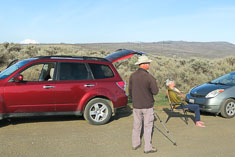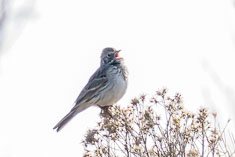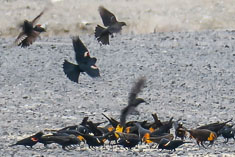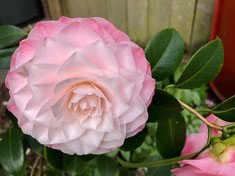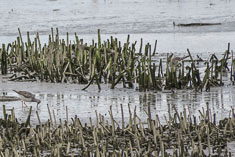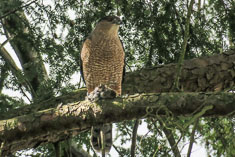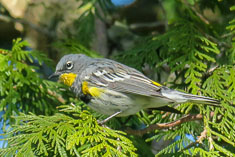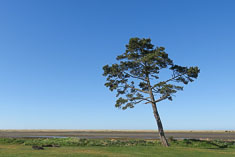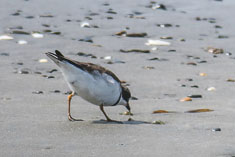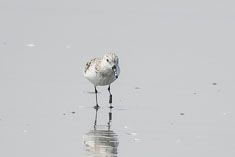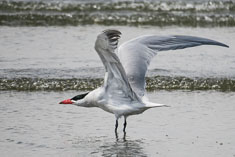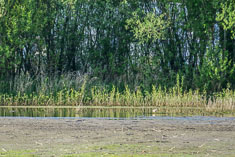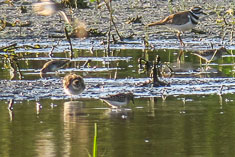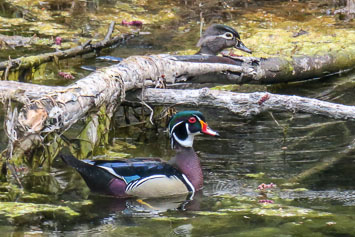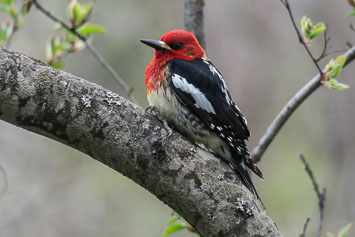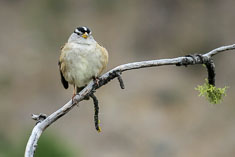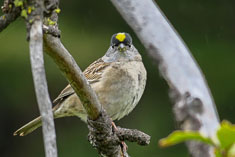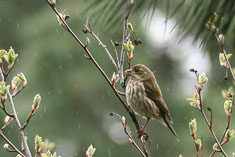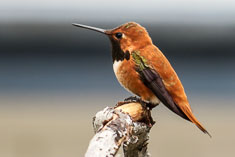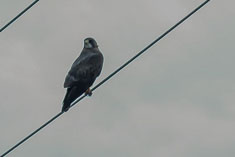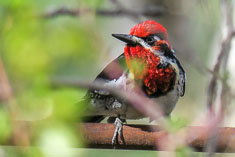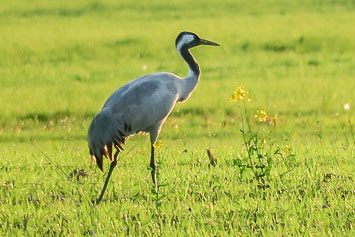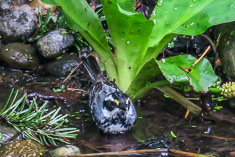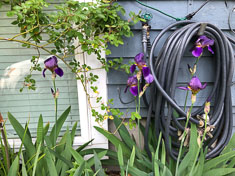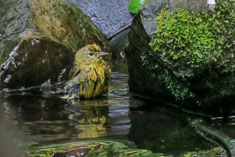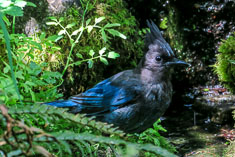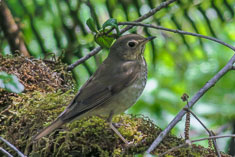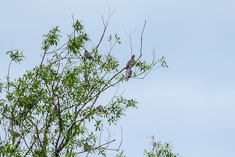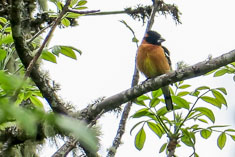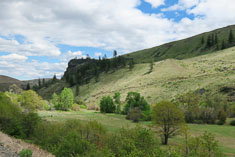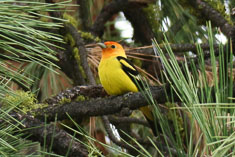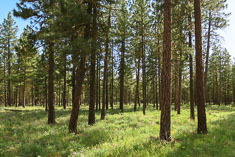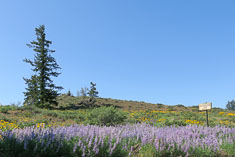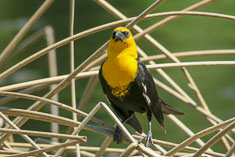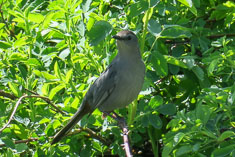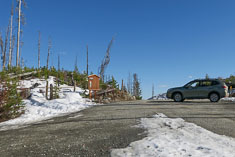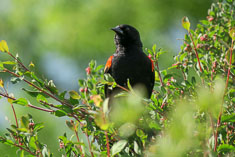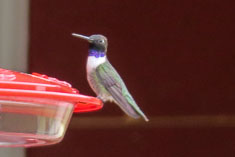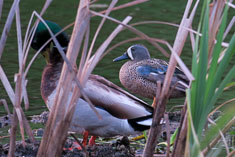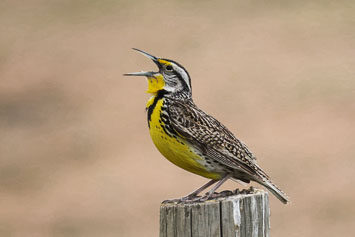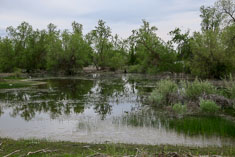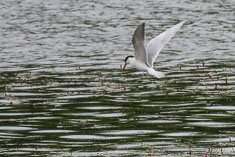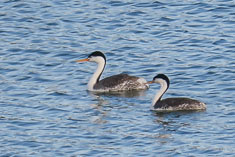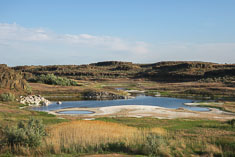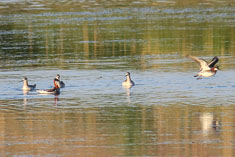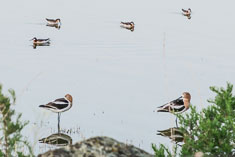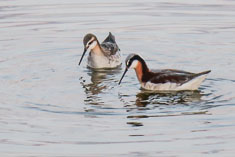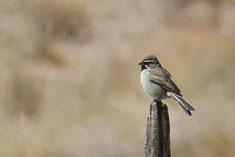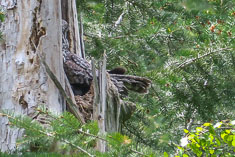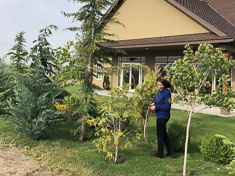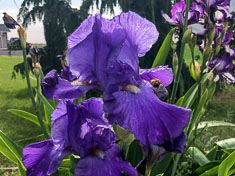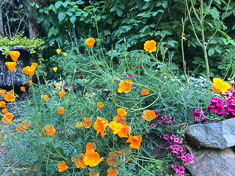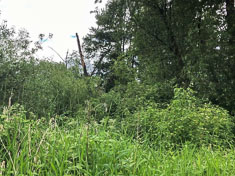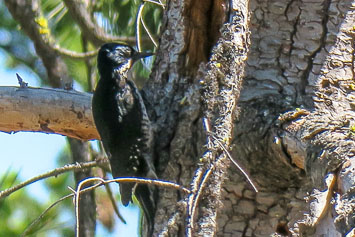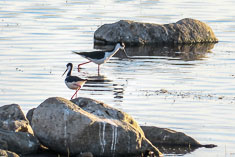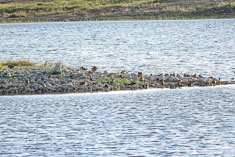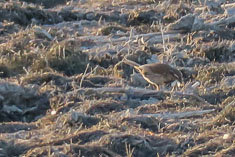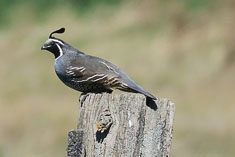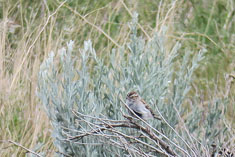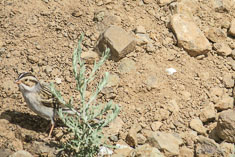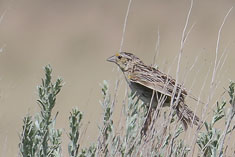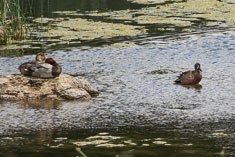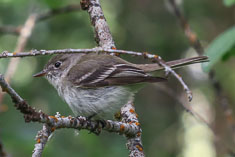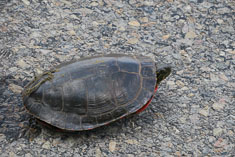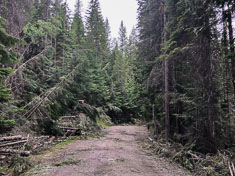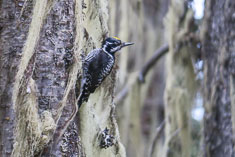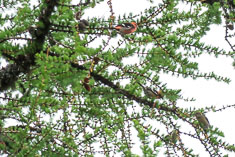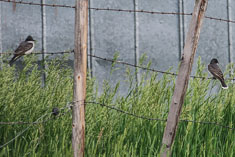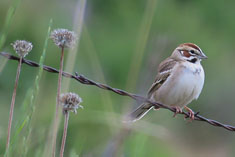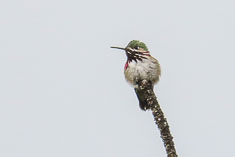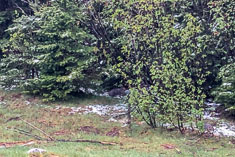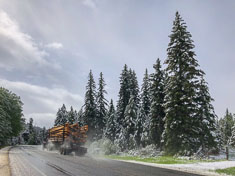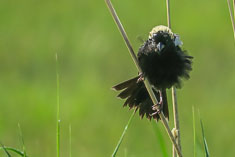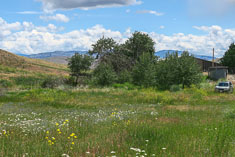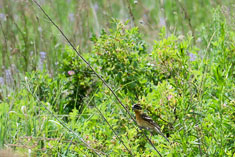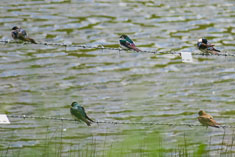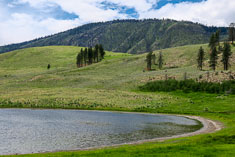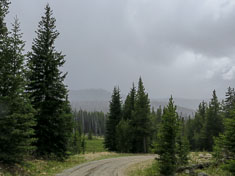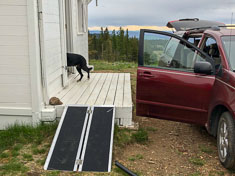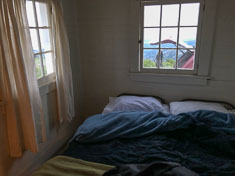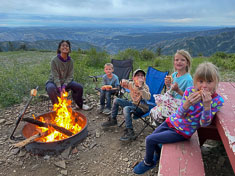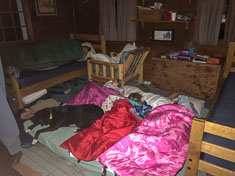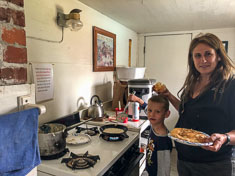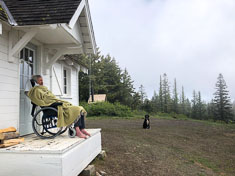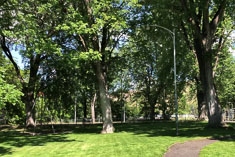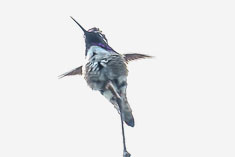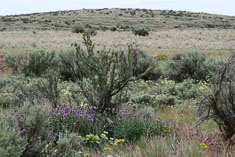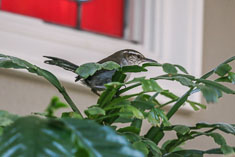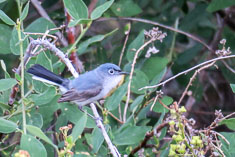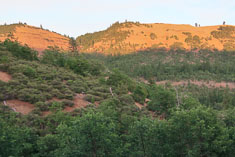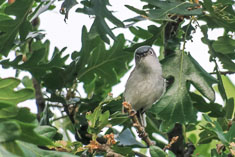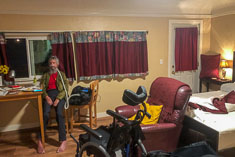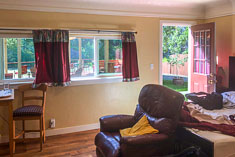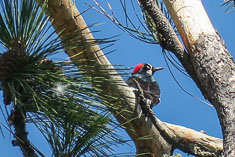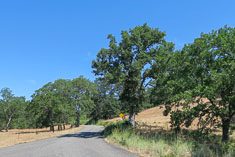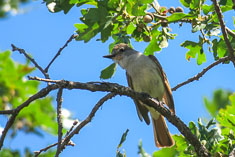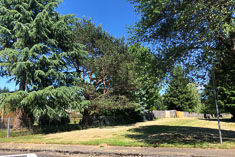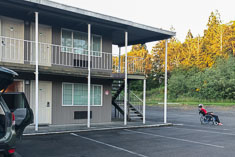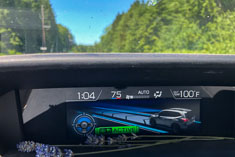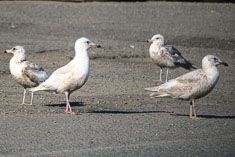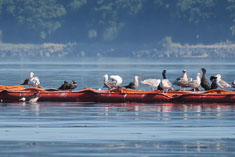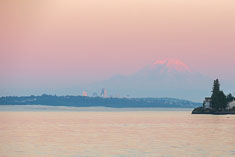03/24/2021 The year to date (link to here)
I'm not dead yet. I've come to realize that I'm not even dying yet. I'm just diminishing. My field-of-view is shrinking as my shriveling neck muscles restrict my ability to turn my head from side to side. The list of places I can go is shrinking as my leg and back muscles lose the last remnants of their strength. My interest in my own activities is shrinking as they become increasingly constrained by my disability. But I'm not dying yet. When friends and family see me they often comment on how healthy I look. I don't feel sick either; I just can't walk very well or swallow very well or breathe very well. Or birdwatch very well.
Despite my diminishing ability to watch birds we have not reduced the amount of time and effort we've been devoting to birding since the beginning of the year. At the end of last year, feeling frustrated by my inability to engage in birding the way I used to, I thought perhaps I would give it up. I can't turn my head to look at a bird overhead or out the window beside me, can't use a spotting scope to scan for distant birds, can't use a camera to capture their beauty or preserve the memory of seeing them. Missing birds that I once would have seen, even my checklists feel incomplete. But Darchelle wasn't ready to quit. As my enthusiasm has waned she has become even more eager to get out and chase birds to add to our year list, which at 207 actually exceeds my previous personal best for number of species seen in the state as of this date. It also puts us in the top 10 among other Washington state year listers in the eBird rankings.
Lots of birdwatching, not much journaling. Actually that's not entirely true because I've completed two major journal-related projects in the past three months, but I am only just now starting a journal for 2021. I created a journal for the last half of 2006 + based on an album of photos I put together some years ago. Once that was done I revisited the journal of our 2018 African trip + and added photos and some supplemental text to complete it. For a couple of weeks after immersing myself in the birds of Africa during that project I would look out the window and expect to see Sunbirds and Hornbills in the backyard instead of Hummingbirds and Flickers. No such luck, unfortunately.
Anyhow, time to go back to the beginning of 2021.
I'm not dead yet. I've come to realize that I'm not even dying yet. I'm just diminishing. My field-of-view is shrinking as my shriveling neck muscles restrict my ability to turn my head from side to side. The list of places I can go is shrinking as my leg and back muscles lose the last remnants of their strength. My interest in my own activities is shrinking as they become increasingly constrained by my disability. But I'm not dying yet. When friends and family see me they often comment on how healthy I look. I don't feel sick either; I just can't walk very well or swallow very well or breathe very well. Or birdwatch very well.
Despite my diminishing ability to watch birds we have not reduced the amount of time and effort we've been devoting to birding since the beginning of the year. At the end of last year, feeling frustrated by my inability to engage in birding the way I used to, I thought perhaps I would give it up. I can't turn my head to look at a bird overhead or out the window beside me, can't use a spotting scope to scan for distant birds, can't use a camera to capture their beauty or preserve the memory of seeing them. Missing birds that I once would have seen, even my checklists feel incomplete. But Darchelle wasn't ready to quit. As my enthusiasm has waned she has become even more eager to get out and chase birds to add to our year list, which at 207 actually exceeds my previous personal best for number of species seen in the state as of this date. It also puts us in the top 10 among other Washington state year listers in the eBird rankings.
Lots of birdwatching, not much journaling. Actually that's not entirely true because I've completed two major journal-related projects in the past three months, but I am only just now starting a journal for 2021. I created a journal for the last half of 2006 + based on an album of photos I put together some years ago. Once that was done I revisited the journal of our 2018 African trip + and added photos and some supplemental text to complete it. For a couple of weeks after immersing myself in the birds of Africa during that project I would look out the window and expect to see Sunbirds and Hornbills in the backyard instead of Hummingbirds and Flickers. No such luck, unfortunately.
Anyhow, time to go back to the beginning of 2021.
01/01/2021 Happy New Year (link to here)
Our get together with Monica and Marco on the front porch was intended to be a New Year's Eve party but we ran late and made it out just in time to hear the neighborhood erupt in cheers and fireworks. We joined in the cheers, rejoicing with our neighbors at the passing of a difficult year - and it wasn't even that difficult for us. Certainly getting together with friends became more uncomfortable as the weather grew colder this fall but we still managed. We FaceTimed with Mom and John and Zoomed with Darchelle's family including an epic festival of present-opening for Christmas. Darchelle worked from home which worked for us as well because it allowed her to check up on me periodically. We spent almost all of our time together and that worked too because we generally prefer each other's company to anyone else's. Nonetheless we celebrated the demise of 2020 in anticipation of hanging out with family and friends indoors again in 2021.
After a leisurely morning on the first day of the year, we went birding. We opted for quality instead of quantity aand found two out of three of our target species. The Snowy Owl which has been hanging out on rooftops in Queen Anne was holding court for a half dozen birders in an alley about a block from where we viewed it last month. The Blue Jay along Highway 512 near Tacoma which I did not summon up the courage to look for last month showed up within a half hour after our arrival. The Glaucous Gull at Gene Coulon Park in Renton did not, or maybe it did but we were unable to identify it in the dim late afternoon light. Disappointing, but we felt pretty good about getting two out of three.
Our get together with Monica and Marco on the front porch was intended to be a New Year's Eve party but we ran late and made it out just in time to hear the neighborhood erupt in cheers and fireworks. We joined in the cheers, rejoicing with our neighbors at the passing of a difficult year - and it wasn't even that difficult for us. Certainly getting together with friends became more uncomfortable as the weather grew colder this fall but we still managed. We FaceTimed with Mom and John and Zoomed with Darchelle's family including an epic festival of present-opening for Christmas. Darchelle worked from home which worked for us as well because it allowed her to check up on me periodically. We spent almost all of our time together and that worked too because we generally prefer each other's company to anyone else's. Nonetheless we celebrated the demise of 2020 in anticipation of hanging out with family and friends indoors again in 2021.
After a leisurely morning on the first day of the year, we went birding. We opted for quality instead of quantity aand found two out of three of our target species. The Snowy Owl which has been hanging out on rooftops in Queen Anne was holding court for a half dozen birders in an alley about a block from where we viewed it last month. The Blue Jay along Highway 512 near Tacoma which I did not summon up the courage to look for last month showed up within a half hour after our arrival. The Glaucous Gull at Gene Coulon Park in Renton did not, or maybe it did but we were unable to identify it in the dim late afternoon light. Disappointing, but we felt pretty good about getting two out of three.
01/04/2021 Long Beach (link to here)
In our first birding trip of the year we drove down to Bay Center along Willapa Bay to see a recently reported Hooded Oriole - a new state bird for both of us. We had good views but weren't able to get good photos. The rain didn't help. We had booked a motel, the Pitchwood Alehouse, in Raymond but of course with the pandemic, the alehouse itself was closed. We arrived after dark to find the parking lot flooded with about 8 inches of water. When we checked with the owner he suggested rubber boots then seemed surprised that we had not thought to bring any. At least the room was dry.
In the morning we returned to Bay Center to try for better photos of the oriole but although we waited with other birders for about a half hour, it did not reappear. We did get a nice view of a Merlin along the road into town. Meanwhile the Bar-tailed Godwit, our next target, was reported again around noon less than an hour away along the Long Beach Peninsula. Unfortunately that was the last sighting of that bird.
It had been hanging out with a flock of Marbled Godwits, which we found not on the bay side of the peninsula but rather out on the open beach. That was a bit of a magical moment. I stayed in the car while Darchelle walked down the beach a bit to try for photos. The surf was up and periodically a tongue of water trimmed with white foam would surge up the beach, flushing the roosting godwits and dunlin. Suddenly as I watched, a Peregrine Falcon strafed the beach, flying in very fast and only a foot or two above the sand. The shorebirds erupted and instantly coalesced into half a dozen tight balls of birds swirling over the surf. The Peregrine arced up into the sky above them then dove two or three times on the dense knots of birds before departing, empty-footed as far as I could tell.
Like the Peregrine, we departed without the shorebird we wanted, the Bar-tailed Godwit.
We spent the night nearby at a place Andy and Ellen recommended, Shakti Cove Cottages. Beautiful wood trim in our cabin, not too many steps to get into the front door. In the morning we returned to Nahcotta on the bay side of the peninsula and found the godwit flock but though Darchelle was able to photograph them at close range, we could not find the Bar-tailed. Among the other birds she photographed was a Semipalmated Plover which I identified from her photo but did not see for myself so since then she has been one bird ahead of me in the eBird state list rankings.
We had one more rare bird to chase on our way home, a White-tailed Kite out on an island in the Columbia River near Cathlamet. "Shouldn't be too difficult" we thought until we arrived and realized that the bird could be anywhere in several square miles of pastures and hayfields. We pulled off the road a few hundred yards beyond where the kite was last reported to consider how to search for it and while we were checking satellite-view maps on our phones, it flew over the field next to us, hovered briefly in a couple of spots then dropped to the ground and took off again with a vole in its talons. "That was easy!" we and the kite thought together as we watched it perch on a fence post and eat its prey.
Including a couple of species which I spotted in the backyard while Darchelle was working, we wrapped up the first week of the year with 72 species, almost halfway to our goal of 151 for the month.
In our first birding trip of the year we drove down to Bay Center along Willapa Bay to see a recently reported Hooded Oriole - a new state bird for both of us. We had good views but weren't able to get good photos. The rain didn't help. We had booked a motel, the Pitchwood Alehouse, in Raymond but of course with the pandemic, the alehouse itself was closed. We arrived after dark to find the parking lot flooded with about 8 inches of water. When we checked with the owner he suggested rubber boots then seemed surprised that we had not thought to bring any. At least the room was dry.
In the morning we returned to Bay Center to try for better photos of the oriole but although we waited with other birders for about a half hour, it did not reappear. We did get a nice view of a Merlin along the road into town. Meanwhile the Bar-tailed Godwit, our next target, was reported again around noon less than an hour away along the Long Beach Peninsula. Unfortunately that was the last sighting of that bird.
It had been hanging out with a flock of Marbled Godwits, which we found not on the bay side of the peninsula but rather out on the open beach. That was a bit of a magical moment. I stayed in the car while Darchelle walked down the beach a bit to try for photos. The surf was up and periodically a tongue of water trimmed with white foam would surge up the beach, flushing the roosting godwits and dunlin. Suddenly as I watched, a Peregrine Falcon strafed the beach, flying in very fast and only a foot or two above the sand. The shorebirds erupted and instantly coalesced into half a dozen tight balls of birds swirling over the surf. The Peregrine arced up into the sky above them then dove two or three times on the dense knots of birds before departing, empty-footed as far as I could tell.
Like the Peregrine, we departed without the shorebird we wanted, the Bar-tailed Godwit.
We spent the night nearby at a place Andy and Ellen recommended, Shakti Cove Cottages. Beautiful wood trim in our cabin, not too many steps to get into the front door. In the morning we returned to Nahcotta on the bay side of the peninsula and found the godwit flock but though Darchelle was able to photograph them at close range, we could not find the Bar-tailed. Among the other birds she photographed was a Semipalmated Plover which I identified from her photo but did not see for myself so since then she has been one bird ahead of me in the eBird state list rankings.
We had one more rare bird to chase on our way home, a White-tailed Kite out on an island in the Columbia River near Cathlamet. "Shouldn't be too difficult" we thought until we arrived and realized that the bird could be anywhere in several square miles of pastures and hayfields. We pulled off the road a few hundred yards beyond where the kite was last reported to consider how to search for it and while we were checking satellite-view maps on our phones, it flew over the field next to us, hovered briefly in a couple of spots then dropped to the ground and took off again with a vole in its talons. "That was easy!" we and the kite thought together as we watched it perch on a fence post and eat its prey.
Including a couple of species which I spotted in the backyard while Darchelle was working, we wrapped up the first week of the year with 72 species, almost halfway to our goal of 151 for the month.
01/10/2021 Projects (link to here)
We've got projects to work on - big projects like the bathroom remodel which should start soon, shared projects like beating my old record of 150 species by the end of January and personal projects like finally adding photos to my Journal of our 2018 Africa trip. Susan brought over another project for me last month - a 2006 photo album to annotate. She invited herself inside to review the album together and I allowed her to do so in violation of our practice to not socialize with anyone indoors. I'll be more careful next time. Darchelle photographed the album for me and I will arrange the images into an online album from which Susan can copy captions for the physical album some day. Not a project, but last week we harvested one stunning lemon from our Meyer lemon bush; Darchelle used it to make dressing for Greek salad soup, my favorite.
We've got projects to work on - big projects like the bathroom remodel which should start soon, shared projects like beating my old record of 150 species by the end of January and personal projects like finally adding photos to my Journal of our 2018 Africa trip. Susan brought over another project for me last month - a 2006 photo album to annotate. She invited herself inside to review the album together and I allowed her to do so in violation of our practice to not socialize with anyone indoors. I'll be more careful next time. Darchelle photographed the album for me and I will arrange the images into an online album from which Susan can copy captions for the physical album some day. Not a project, but last week we harvested one stunning lemon from our Meyer lemon bush; Darchelle used it to make dressing for Greek salad soup, my favorite.
01/13/2021 Green Lake (link to here)
This afternoon we drove over to Green Lake to try to see the Sora which has returned to the southwest corner of the lake for the second winter in a row. The closest parking is more than a quarter mile away so I wasn't sure I could make it but it went okay. Quite a few people were out walking around the lake and a handful of them, aware of reports of the little rail, stopped to look for it. Most of us wore masks and we tried to stay 6 feet apart. Collectively we found the Sora after several minutes of searching. Once again I was surprised at how small it is, not that much bigger than a sparrow and very cute as it paced deliberately through the cattails, apparently oblivious to the attention it was receiving.
This afternoon we drove over to Green Lake to try to see the Sora which has returned to the southwest corner of the lake for the second winter in a row. The closest parking is more than a quarter mile away so I wasn't sure I could make it but it went okay. Quite a few people were out walking around the lake and a handful of them, aware of reports of the little rail, stopped to look for it. Most of us wore masks and we tried to stay 6 feet apart. Collectively we found the Sora after several minutes of searching. Once again I was surprised at how small it is, not that much bigger than a sparrow and very cute as it paced deliberately through the cattails, apparently oblivious to the attention it was receiving.
01/14/2021 Rare birds (link to here)
We chased four rare birds south of Seattle today and saw two of them, in the process passing the 100 species mark for the month and year. That's a reasonably successful day but I found my limitations frustrating nonetheless.
The Winter Wren near Orting was the rarest of the four. It was a beautiful sunny morning down there, the pastures already very green. The bird was hanging out in a farmyard cluttered with old equipment and scrap metal. I thought I was on it when a big white pickup truck pulled up and asked what we were looking at. We told them we were birdwatching and after the customary discussion about Bald Eagles I offered to point out the bird. They were interested so I described its location under a horse trailer and the man was able to pick it out. Only after he drove off did I realize that I had showed him a Song Sparrow. The Winter Wren had been under the manure cart behind the trailer.
Missing the Common Grackle was disappointing because had I been able, I could have photographed it right when we pulled in but by the time I was able to explain to Darchelle where it was, it had flown away and we did not see it again. It would have been my 400th bird for Washington state but without a photo I wasn't positive about the identification so we did not count it. We photographed the flock of Brewer's Blackbirds with which the grackle had been associating instead.
Just down the street a Harris's Sparrow had been regularly reported in the blackberry thickets around a vegetable farm. Sparrows are difficult for me because I cannot usually get close enough to identify them without optics. Today was our second visit to the vegetable farm; our first visit was on a rainy evening recently. As I waddled after Darchelle down a grassy track along a field full of rotting beets, a sparrow popped up onto a clump of blackberries next to me and just as quickly popped down again but in the split-second that it was visible, I snapped a mental impression of an unmarked face and bold black streaking on white underparts. Darchelle did not see it. Pretty sure it was the Harris's but not quite sure enough to count it. Today I had a nice clear view but Darchelle saw it only in flight so we did not get a photo.
On the way home we scoped the gulls on the log boom at Gene Coulon Park. I can't look through the scope for very long before I run out of breath but during my brief scan I thought I spotted the juvenile Glaucous Gull. We were not able to relocate it.
We chased four rare birds south of Seattle today and saw two of them, in the process passing the 100 species mark for the month and year. That's a reasonably successful day but I found my limitations frustrating nonetheless.
The Winter Wren near Orting was the rarest of the four. It was a beautiful sunny morning down there, the pastures already very green. The bird was hanging out in a farmyard cluttered with old equipment and scrap metal. I thought I was on it when a big white pickup truck pulled up and asked what we were looking at. We told them we were birdwatching and after the customary discussion about Bald Eagles I offered to point out the bird. They were interested so I described its location under a horse trailer and the man was able to pick it out. Only after he drove off did I realize that I had showed him a Song Sparrow. The Winter Wren had been under the manure cart behind the trailer.
Missing the Common Grackle was disappointing because had I been able, I could have photographed it right when we pulled in but by the time I was able to explain to Darchelle where it was, it had flown away and we did not see it again. It would have been my 400th bird for Washington state but without a photo I wasn't positive about the identification so we did not count it. We photographed the flock of Brewer's Blackbirds with which the grackle had been associating instead.
Just down the street a Harris's Sparrow had been regularly reported in the blackberry thickets around a vegetable farm. Sparrows are difficult for me because I cannot usually get close enough to identify them without optics. Today was our second visit to the vegetable farm; our first visit was on a rainy evening recently. As I waddled after Darchelle down a grassy track along a field full of rotting beets, a sparrow popped up onto a clump of blackberries next to me and just as quickly popped down again but in the split-second that it was visible, I snapped a mental impression of an unmarked face and bold black streaking on white underparts. Darchelle did not see it. Pretty sure it was the Harris's but not quite sure enough to count it. Today I had a nice clear view but Darchelle saw it only in flight so we did not get a photo.
On the way home we scoped the gulls on the log boom at Gene Coulon Park. I can't look through the scope for very long before I run out of breath but during my brief scan I thought I spotted the juvenile Glaucous Gull. We were not able to relocate it.
01/17/2021 Vancouver trip (link to here)
Chasing rare birds again we made an overnight trip south to Vancouver and spotted most of our target species, missing only a Red-shouldered Hawk and a Swamp Sparrow. The first three birds pictured above are quite rare so it was great to pick them up so early in the season. Not much of a tuft on that Tufted Duck but the shape of the bill and the color of the sides confirm the identification despite the poor light.
That Tufted Duck cost us a night sleep though. It was a bit of a walk, for me anyhow, out to the vantage point from which we scanned the flock of Scaup with the spotting scope to pick out the Tufted Duck. To enable me to use the scope Darchelle returned to the car to get the ventilator. As it turned out, she brought the power cord and the spare battery as well and set everything on the bench in front of me. I scoped and found the duck. She took photos through the scope as well as with the camera from the beach. She escorted me and the ventilator back to the car in one trip and made a separate trip to retrieve the scope. We stopped by Fort Vancouver Park to find an Acorn Woodpecker before heading home. On the way home we detoured out to the hills around Meskill to try and pick up the Northern Pygmy Owls we heard out there last fall when we were hunting chanterelles. We got a Northern Saw-whet instead but delayed by owling, didn't get home until 10PM. The ventilator was sounding its low battery alarm by that point so after Darchelle got me inside she went to plug it in and couldn't find the cord. Or the spare battery. Without the power cord the ventilator would shut down before I could even get into bed. Without the ventilator I can't sleep.
We spent the night driving back to Vancouver to retrieve the battery and power cord from the bench where we were pretty sure we had left it. It was still there waiting for us. We actually got a few hours sleep the next morning before Darchelle had to start work.
BTW, here is a photo of the front view of the Red-tailed Hawk. It looked quite small both in flight and when perched and the plumage was not all that different from some juvenile Red-shouldered Hawks, but the fine barring on the tail indicates a Red-tail.
Chasing rare birds again we made an overnight trip south to Vancouver and spotted most of our target species, missing only a Red-shouldered Hawk and a Swamp Sparrow. The first three birds pictured above are quite rare so it was great to pick them up so early in the season. Not much of a tuft on that Tufted Duck but the shape of the bill and the color of the sides confirm the identification despite the poor light.
That Tufted Duck cost us a night sleep though. It was a bit of a walk, for me anyhow, out to the vantage point from which we scanned the flock of Scaup with the spotting scope to pick out the Tufted Duck. To enable me to use the scope Darchelle returned to the car to get the ventilator. As it turned out, she brought the power cord and the spare battery as well and set everything on the bench in front of me. I scoped and found the duck. She took photos through the scope as well as with the camera from the beach. She escorted me and the ventilator back to the car in one trip and made a separate trip to retrieve the scope. We stopped by Fort Vancouver Park to find an Acorn Woodpecker before heading home. On the way home we detoured out to the hills around Meskill to try and pick up the Northern Pygmy Owls we heard out there last fall when we were hunting chanterelles. We got a Northern Saw-whet instead but delayed by owling, didn't get home until 10PM. The ventilator was sounding its low battery alarm by that point so after Darchelle got me inside she went to plug it in and couldn't find the cord. Or the spare battery. Without the power cord the ventilator would shut down before I could even get into bed. Without the ventilator I can't sleep.
We spent the night driving back to Vancouver to retrieve the battery and power cord from the bench where we were pretty sure we had left it. It was still there waiting for us. We actually got a few hours sleep the next morning before Darchelle had to start work.
BTW, here is a photo of the front view of the Red-tailed Hawk. It looked quite small both in flight and when perched and the plumage was not all that different from some juvenile Red-shouldered Hawks, but the fine barring on the tail indicates a Red-tail.
01/22/2021 The coast (link to here)
The highlight of our first day trip to the coast was a drive on the beach at Westport. The tide was low and the driving was excellent. Although bird diversity was somewhat limited, we did manage to spot a group of Snowy Plovers hiding in tire tracks in the dry sand above the wrack line.
We also came across a group of gulls feeding on a whale carcass. They were a mix of Western and Glaucous-winged but one with a particularly dark mantle did a convincing imitation of a rare Slaty-backed Gull until it spread its wings. The absence of white spots on the tips of the primaries is a distinguishing characteristic of a third-year Western Gull.
The highlight of our first day trip to the coast was a drive on the beach at Westport. The tide was low and the driving was excellent. Although bird diversity was somewhat limited, we did manage to spot a group of Snowy Plovers hiding in tire tracks in the dry sand above the wrack line.
We also came across a group of gulls feeding on a whale carcass. They were a mix of Western and Glaucous-winged but one with a particularly dark mantle did a convincing imitation of a rare Slaty-backed Gull until it spread its wings. The absence of white spots on the tips of the primaries is a distinguishing characteristic of a third-year Western Gull.
01/25/2021 Swamp Sparrow (link to here)
The Swamp Sparrow at Stillwater out in the Snoqualmie Valley is still being reported so we went to see it. I wasn't sure I could make it out there but it turned out to be only a half mile round-trip - no problem. We might not have found it had not a couple of other birders pointed out to us. We had been looking in the area where we saw it last fall but this time it was 50 yards back towards the trailhead. Last fall we only heard it but today it offered good views (at least to those with binoculars) and Darchelle got photos. She also got photos of a pheasant which flew in while we were looking for the sparrow.
It might've been after this outing or perhaps after another one in the previous week or so that I stumbled at the top step while Darchelle was helping me up to the front porch. My knee buckled but I was able to turn and sit down on the step without falling. While Darchelle struggled to get me back on my feet again I ran out of air. After a few moments of panic I was able to gasp that I needed the ventilator. Darchelle got me onto the bench by the front door and ran to get it. I recovered quickly but the incident was frightening and left me with lingering anxiety about getting back into the house after future outings.
The Swamp Sparrow at Stillwater out in the Snoqualmie Valley is still being reported so we went to see it. I wasn't sure I could make it out there but it turned out to be only a half mile round-trip - no problem. We might not have found it had not a couple of other birders pointed out to us. We had been looking in the area where we saw it last fall but this time it was 50 yards back towards the trailhead. Last fall we only heard it but today it offered good views (at least to those with binoculars) and Darchelle got photos. She also got photos of a pheasant which flew in while we were looking for the sparrow.
It might've been after this outing or perhaps after another one in the previous week or so that I stumbled at the top step while Darchelle was helping me up to the front porch. My knee buckled but I was able to turn and sit down on the step without falling. While Darchelle struggled to get me back on my feet again I ran out of air. After a few moments of panic I was able to gasp that I needed the ventilator. Darchelle got me onto the bench by the front door and ran to get it. I recovered quickly but the incident was frightening and left me with lingering anxiety about getting back into the house after future outings.
01/28/2021 The Peninsula (link to here)
The birds we photographed were neither the ones that we particularly sought nor that we were particularly pleased to find, though both the shrike and the hawk were new for the year. A highlight of the trip for me was a clear scope view of a line of Ancient Murrelets on flat water off Marlyn Nelson County Park +. We stayed overnight in a comfortable cabin on the bluff overlooking Dungeness Bay and returned home with 155 species for the year, five more than my previous record for January.
FWIW, The eBird reviewer disagreed with my identification of the hawk as a Sharp-shinned, stating that based on the location, it was a Cooper's. I updated my description in the checklist as follows:
On another note, as David would say, we saw a Black-billed Magpie on Beacon Hill yesterday, my first in King County since the one Daniel raised and released back in 1998.
The birds we photographed were neither the ones that we particularly sought nor that we were particularly pleased to find, though both the shrike and the hawk were new for the year. A highlight of the trip for me was a clear scope view of a line of Ancient Murrelets on flat water off Marlyn Nelson County Park +. We stayed overnight in a comfortable cabin on the bluff overlooking Dungeness Bay and returned home with 155 species for the year, five more than my previous record for January.
FWIW, The eBird reviewer disagreed with my identification of the hawk as a Sharp-shinned, stating that based on the location, it was a Cooper's. I updated my description in the checklist as follows:
Adult, probably a female Sharp-shinned based on its size (smaller than a crow), its relatively square-tipped tail, its dark cap, and the coarse barring on the underparts.
and included this photo of the front vie
but left the identification as uncertain.On another note, as David would say, we saw a Black-billed Magpie on Beacon Hill yesterday, my first in King County since the one Daniel raised and released back in 1998.
01/30/2021 Snow Bunting #156, and my last walk (link to here)
We stopped by Eide Road in Stanwood in the morning but a brisk southwest breeze freighted with drizzle deterred us from making the half-mile pilgrimage out to the end of the dike to see the continuing Snow Bunting. We drove up to Rosario instead hoping to see a Surfbird but I was too tired to even get out of the car. Back at Eide Road again an hour before sunset the weather had moderated a bit so we decided to tackle the walk. I made it out there okay and we found the bird. It was very tame. The walk back was tough. Even with frequent rest stops I barely made it. At one point with about 50 yards to go both legs gave out but Darchelle was able to hold me up. My teeth were chattering uncontrollably by the time I collapsed into the car. I think Monica helped Darchelle to get me up the front steps.
Not only my legs but also my lower back and abdominal muscles were exhausted, and they did not recover overnight. The next morning I stood up suddenly and went right over backwards, or maybe my right leg gave out when I turned on it. I'm not sure which because I don't remember falling, or much of anything else from the next hour or so. Darchelle heard me cry out "Oh shit" and turned just in time to see my head bounce on the old growth fir floorboards. The impact knocked me out. For a moment Darchelle was terrified that I might be dead. She called Marco and Monica, who came up immediately, and then called 911.
When the medics arrived a few minutes later they asked me if I knew my wife's name and my address. I answered both questions correctly. I don't remember that. They put me on a stretcher, carried me down the front steps and packed me into an ambulance. I have a vague memory of being in the ambulance and then of being transported down a hospital hallway. Even my memory of our several hours in the hospital room is fuzzy. People were very nice to me. Darchelle hung out with me in the room and we talked. After a couple of tests which I don't really recall, they sent us home with a wheelchair. Marco and Monica had followed the ambulance to the hospital in case Darchelle needed a ride home. They helped Darchelle get me into the car. I had a slight headache for several days afterwards but have not since then walked more than a couple hundred steps at once, and then only with Darchelle holding onto one arm. My days of walking without assistance are over.
We stopped by Eide Road in Stanwood in the morning but a brisk southwest breeze freighted with drizzle deterred us from making the half-mile pilgrimage out to the end of the dike to see the continuing Snow Bunting. We drove up to Rosario instead hoping to see a Surfbird but I was too tired to even get out of the car. Back at Eide Road again an hour before sunset the weather had moderated a bit so we decided to tackle the walk. I made it out there okay and we found the bird. It was very tame. The walk back was tough. Even with frequent rest stops I barely made it. At one point with about 50 yards to go both legs gave out but Darchelle was able to hold me up. My teeth were chattering uncontrollably by the time I collapsed into the car. I think Monica helped Darchelle to get me up the front steps.
Not only my legs but also my lower back and abdominal muscles were exhausted, and they did not recover overnight. The next morning I stood up suddenly and went right over backwards, or maybe my right leg gave out when I turned on it. I'm not sure which because I don't remember falling, or much of anything else from the next hour or so. Darchelle heard me cry out "Oh shit" and turned just in time to see my head bounce on the old growth fir floorboards. The impact knocked me out. For a moment Darchelle was terrified that I might be dead. She called Marco and Monica, who came up immediately, and then called 911.
When the medics arrived a few minutes later they asked me if I knew my wife's name and my address. I answered both questions correctly. I don't remember that. They put me on a stretcher, carried me down the front steps and packed me into an ambulance. I have a vague memory of being in the ambulance and then of being transported down a hospital hallway. Even my memory of our several hours in the hospital room is fuzzy. People were very nice to me. Darchelle hung out with me in the room and we talked. After a couple of tests which I don't really recall, they sent us home with a wheelchair. Marco and Monica had followed the ambulance to the hospital in case Darchelle needed a ride home. They helped Darchelle get me into the car. I had a slight headache for several days afterwards but have not since then walked more than a couple hundred steps at once, and then only with Darchelle holding onto one arm. My days of walking without assistance are over.
01/31/2021 Our Cooper's Hawk (link to here)
We call her ours but we have no claim on her, though she does wear a numbered collar on one leg
so perhaps she does belong to someone.
She showed up one day in late January, perched on top of the wrought iron stand from which our bird feeders hang, and scanned the ground underneath her with fierce interest. Somehow our little welfare flock of siskins and juncos had sensed her impending arrival and discreetly vanished, at least most of them had. One Pine Siskin had remained behind, frozen on its perch on the feeder immediately below the big Accipiter. For a long moment the siskin lingered before bolting for the hole in the fence 10 feet away. The Cooper's Hawk shot after it but soon returned to its perch. Apparently the siskin had made it. They didn't all make it. The fat and listless sick ones, the ones we heartlessly call "Sammy Siskins" for the salmonella which apparently afflicts only the Pine Siskins, must fall prey to the hawk often enough that she has been returning regularly to patrol our yard.
She showed up one day in late January, perched on top of the wrought iron stand from which our bird feeders hang, and scanned the ground underneath her with fierce interest. Somehow our little welfare flock of siskins and juncos had sensed her impending arrival and discreetly vanished, at least most of them had. One Pine Siskin had remained behind, frozen on its perch on the feeder immediately below the big Accipiter. For a long moment the siskin lingered before bolting for the hole in the fence 10 feet away. The Cooper's Hawk shot after it but soon returned to its perch. Apparently the siskin had made it. They didn't all make it. The fat and listless sick ones, the ones we heartlessly call "Sammy Siskins" for the salmonella which apparently afflicts only the Pine Siskins, must fall prey to the hawk often enough that she has been returning regularly to patrol our yard.
02/04/2021 More rare birds (link to here)
The mockingbird in Olympia was easy. Ed and Delia arrived a few minutes before we did and had it
already staked out. It was our first sighting since four years ago. The Lesser Black-backed Gull
is equally rare and was much harder to spot. Ed, Delia, Darchelle and I took turns scanning the
flock of over 450 gulls in a grassy
field in Centralia +. We thought we spotted it early on but took another hour to confirm.
Darchelle got photos. The effort of standing at the scope for 10 or 15 minutes left my lower back
close to collapse. It has not fully recovered and probably never will.
FWIW, Darchelle photographed another gull which I was not able to identify. It appears to have long wings like a Ring-billed but seems too large. It has a pale eye like a Herring Gull and is about the right size - maybe that is what it is.
FWIW, Darchelle photographed another gull which I was not able to identify. It appears to have long wings like a Ring-billed but seems too large. It has a pale eye like a Herring Gull and is about the right size - maybe that is what it is.
02/10/2021 Our new bedroom (link to here)
We moved downstairs this week and began sleeping in the bed Darchelle set up in the jungle room off the kitchen a few months ago. Climbing the stairs to our second-floor bedroom just became too difficult even with Darchelle's help. Adopting the jungle room as our bedroom was bittersweet. We love sleeping under the coffee tree and waking up to blue sky above the skylights but moving downstairs is yet another sign of my decline.
We moved downstairs this week and began sleeping in the bed Darchelle set up in the jungle room off the kitchen a few months ago. Climbing the stairs to our second-floor bedroom just became too difficult even with Darchelle's help. Adopting the jungle room as our bedroom was bittersweet. We love sleeping under the coffee tree and waking up to blue sky above the skylights but moving downstairs is yet another sign of my decline.
02/13/2021 Snowstorm (link to here)
It began snowing not too long before we went to bed last night. The forecast called for about 7 inches and by Saturday morning we were approaching that but it kept on snowing. By late afternoon we had close to a foot. Darchelle built a snowman and Marc and Monica erected a fort of snow bricks. The keepers of weather statistics reported that it was the snowiest February day in 52 years.
It began snowing not too long before we went to bed last night. The forecast called for about 7 inches and by Saturday morning we were approaching that but it kept on snowing. By late afternoon we had close to a foot. Darchelle built a snowman and Marc and Monica erected a fort of snow bricks. The keepers of weather statistics reported that it was the snowiest February day in 52 years.
02/19/2021 Local pursuits (link to here)
We dedicated our birding efforts in mid-February to locating birds in the Seattle area which we had not yet seen this year. Most of them would be easy to find later in the year but tough in February. The Townsend's Solitaire frequents pine forests on the east side of the Cascades in June but is quite unusual in Seattle anytime. The individual in Discovery Park was hanging out in a specific berry bush near the South parking lot. Afraid that it might be too far for me to walk, I was reluctant to go look for it but Darchelle insisted. We brought the scope and after investigating, Darchelle determined that to see the bird through the scope would require only 170 steps in each direction. She was right. The Band-tailed Pigeons were preparing to roost in a dense cedar on a showery evening in a Matthews Beach neighborhood when we caught up to them. Not our earliest sighting over the last 10 years or so but earlier than most.
Our most challenging pursuit was not of the Ruddy Turnstone at Tulalip Bay, which we caught in a distant scope view on our second or third attempt, but rather of the Covid vaccine which we found in a parking lot in Monroe earlier that day. Several days earlier, alerted by a post on a Facebook group, we had signed up for a mass vaccination event sponsored by Snohomish County at the Evergreen State Fairgrounds. For the previous week both Darchelle and I had visited dozens of vaccine websites to no avail so when I came across the openings in Monroe I questioned whether the website was legit, but they were waiting for us and both Darchelle and I were able to get shots, no questions asked. It was a drive-through operation and we did not even have to get out of the car. The Moderna shot hurt slightly more than a flu shot but neither of us had any complaints.
We dedicated our birding efforts in mid-February to locating birds in the Seattle area which we had not yet seen this year. Most of them would be easy to find later in the year but tough in February. The Townsend's Solitaire frequents pine forests on the east side of the Cascades in June but is quite unusual in Seattle anytime. The individual in Discovery Park was hanging out in a specific berry bush near the South parking lot. Afraid that it might be too far for me to walk, I was reluctant to go look for it but Darchelle insisted. We brought the scope and after investigating, Darchelle determined that to see the bird through the scope would require only 170 steps in each direction. She was right. The Band-tailed Pigeons were preparing to roost in a dense cedar on a showery evening in a Matthews Beach neighborhood when we caught up to them. Not our earliest sighting over the last 10 years or so but earlier than most.
Our most challenging pursuit was not of the Ruddy Turnstone at Tulalip Bay, which we caught in a distant scope view on our second or third attempt, but rather of the Covid vaccine which we found in a parking lot in Monroe earlier that day. Several days earlier, alerted by a post on a Facebook group, we had signed up for a mass vaccination event sponsored by Snohomish County at the Evergreen State Fairgrounds. For the previous week both Darchelle and I had visited dozens of vaccine websites to no avail so when I came across the openings in Monroe I questioned whether the website was legit, but they were waiting for us and both Darchelle and I were able to get shots, no questions asked. It was a drive-through operation and we did not even have to get out of the car. The Moderna shot hurt slightly more than a flu shot but neither of us had any complaints.
02/21/2021 Rusty at last (link to here)
By Darchelle's estimation, we invested 17 hours over four or five visits in our quest to see the Rusty blackbird at Neal Road near Fall City in the Snoqualmie Valley. The Rusty (or Rusties, since there may have been two of them) have been wintering with a large mixed flock of blackbirds at a farm across the river from the north end of Neal Road. Periodically the flock flies up into several large trees by the farm, offering an opportunity to scan the birds with a spotting scope and attempt to pick out the Rusty, which has a slightly rustier cap and brighter stripe over the eye than the very similar female Brewer's Blackbirds. Identifying the Rusty is almost impossible when the birds are backlit, which is most of the time. To compensate for Darchelle's inexperience in distinguishing very similar-looking blackbirds in the spotting scope, we adopted a strategy of photographing the entire flock and then searching through the photos on my computer. It worked, eventually. On 21 February Darchelle caught the Rusty Blackbird in the top of one of the cottonwoods in her 573rd photo of the blackbird flock.
In addition to the Rusty Blackbird, we picked up our only White-throated Sparrow of the year so far on our first visit to Neil Road back on 10 January.
By Darchelle's estimation, we invested 17 hours over four or five visits in our quest to see the Rusty blackbird at Neal Road near Fall City in the Snoqualmie Valley. The Rusty (or Rusties, since there may have been two of them) have been wintering with a large mixed flock of blackbirds at a farm across the river from the north end of Neal Road. Periodically the flock flies up into several large trees by the farm, offering an opportunity to scan the birds with a spotting scope and attempt to pick out the Rusty, which has a slightly rustier cap and brighter stripe over the eye than the very similar female Brewer's Blackbirds. Identifying the Rusty is almost impossible when the birds are backlit, which is most of the time. To compensate for Darchelle's inexperience in distinguishing very similar-looking blackbirds in the spotting scope, we adopted a strategy of photographing the entire flock and then searching through the photos on my computer. It worked, eventually. On 21 February Darchelle caught the Rusty Blackbird in the top of one of the cottonwoods in her 573rd photo of the blackbird flock.
In addition to the Rusty Blackbird, we picked up our only White-throated Sparrow of the year so far on our first visit to Neil Road back on 10 January.
02/24/2021 Bath time (link to here)
Since moving downstairs earlier this month, I no longer have access to a bathtub or shower at home. In the short term our solution has been to book rooms with bathtubs when we go away overnight on our birding trips. If we go too long between trips then we can recruit Marco or Monica to help Darchelle support me up the stairs so I can bathe in our own tub. That's a nice treat, and this month it came just in time to get all clean for Marc's birthday celebration. Meanwhile we have found a contractor to add a wheelchair-accessible shower to our downstairs bathroom. He started work this week.
Since moving downstairs earlier this month, I no longer have access to a bathtub or shower at home. In the short term our solution has been to book rooms with bathtubs when we go away overnight on our birding trips. If we go too long between trips then we can recruit Marco or Monica to help Darchelle support me up the stairs so I can bathe in our own tub. That's a nice treat, and this month it came just in time to get all clean for Marc's birthday celebration. Meanwhile we have found a contractor to add a wheelchair-accessible shower to our downstairs bathroom. He started work this week.
02/28/2021 The Skagit (link to here)
I think this was our fourth trip to the Skagit Flats - the delta of the Skagit River west of Mount Vernon - this year. Today we spotted the bird we've been looking for, a Prairie Falcon. We've been looking for other birds too of course, but most of those we've found. This one eluded us last month and again yesterday, but not today. Darchelle even got a distant photo.
I think this was our fourth trip to the Skagit Flats - the delta of the Skagit River west of Mount Vernon - this year. Today we spotted the bird we've been looking for, a Prairie Falcon. We've been looking for other birds too of course, but most of those we've found. This one eluded us last month and again yesterday, but not today. Darchelle even got a distant photo.
03/05/2021 The Okanogan (link to here)
We put off our winter trip to Okanogan County until the first weekend of March, which turned out to be a week or two too late for a couple of the species we were looking for. I don't remember why we did not go out there in February; I think I might've been a little intimidated by the prospect since I'm a little less able than I was last year. Nonetheless we found some good birds, got some good photos and added 16 species to our year list.
Since conditions were favorable and Canada Jays had recently been reported at Stevens Pass, we took that route but reached the pass after lunch time. The jays had already feasted on barbecue scraps and couldn't be bothered to venture down to the parking lot to inspect our vegetarian fare. We did not fare much better in Leavenworth, missing the White-headed Woodpeckers that everyone else seems to see there. A man with busy birdfeeders in front of his house told us that they show up at his place every few days but otherwise hang out along the ski trails. He invited us to feel free to park in his driveway to watch the feeders, which we did, and picked up our first year bird of the trip, a Pygmy Nuthatch.
Heading up the Columbia from Wenatchee I directed Darchelle onto the wrong Highway 97 and confused by my error, missed our stop at the boat launch below Pateros where the recently-reported Yellow-billed Loon was probably awaiting us. We continued on up to Winthrop, spent a quiet and private night at the Chewuch Inn and pursued Pine Grosbeaks in Twisp in the morning. We found them, and a flock of Wild Turkeys as well, right in town along with a cute squirrel. We also found the grosbeaks up the Twisp River Road and in Winthrop but the Bohemian Waxwings which were still around last weekend had apparently headed north. We lingered in Twisp looking for waxwings too late to try for the loon again on our way over to Omak for the night. In fact we just barely made it to Omak in time to get takeout from the Breadline Café.
Saturday we did the Highlands - Siwash Creek Road, the Havillah area, Nealy Road, Mary Ann Creek
Road and Fancher Flats. We found a big flock of Common Redpolls along Siwash Creek and a big flock
of Snow Buntings and Gray-crowned Rosy-finches in a small feedlot along Nealy Road but picked up
neither Sharp-tailed Grouse at Siwash Creek nor Ruffed Grouse at the feeders. Later though, as we
were speeding up Mary Ann Creek Road I spotted a grouse-shaped lump in a willow thicket. I had
Darchelle back up and the lump turned out to be an actual Ruffed Grouse, our first for the year. At
dusk on the way back down we detoured around the cows on Fancher Flats to pick up our last two year
birds of the day - Chukar and Golden Eagle. It was a good day despite expending two of our precious
daylight hours on a search for a drumming woodpecker which I was pretty sure was a White-headed.
Not until after Darchelle had postholed around the snowy pine forest for an hour looking for it did I
realize that it was a Pileated Woodpecker. When she had asked me what other woodpecker would drum
like that, Pileated had not come to mind.
Above are pictured a House Finch, a Cedar Waxwing and a Common Loon, each one a bird Darchelle photographed while we were looking for its rarer relative (well, distant relative in the case of the House Finch). Sunday morning we ran up towards Conconully to look for Sharp-tailed Grouse. On the way we called up our first Canyon Wren of the year in the usual spot. No grouse, though we did catch a fleeting glimpse of a Gray Partridge above Hess Lake. No Yellow-billed Loon either despite hours of searching. It proved to be a difficult bird for us because I cannot stand at the scope and search and Darchelle wasn't confident she could distinguish it from a Common Loon. The bill is not that yellow and the loons were distant and kept diving, or if not, had tucked their tell-tale bill under a wing and were taking a nap.
We put off our winter trip to Okanogan County until the first weekend of March, which turned out to be a week or two too late for a couple of the species we were looking for. I don't remember why we did not go out there in February; I think I might've been a little intimidated by the prospect since I'm a little less able than I was last year. Nonetheless we found some good birds, got some good photos and added 16 species to our year list.
Since conditions were favorable and Canada Jays had recently been reported at Stevens Pass, we took that route but reached the pass after lunch time. The jays had already feasted on barbecue scraps and couldn't be bothered to venture down to the parking lot to inspect our vegetarian fare. We did not fare much better in Leavenworth, missing the White-headed Woodpeckers that everyone else seems to see there. A man with busy birdfeeders in front of his house told us that they show up at his place every few days but otherwise hang out along the ski trails. He invited us to feel free to park in his driveway to watch the feeders, which we did, and picked up our first year bird of the trip, a Pygmy Nuthatch.
Heading up the Columbia from Wenatchee I directed Darchelle onto the wrong Highway 97 and confused by my error, missed our stop at the boat launch below Pateros where the recently-reported Yellow-billed Loon was probably awaiting us. We continued on up to Winthrop, spent a quiet and private night at the Chewuch Inn and pursued Pine Grosbeaks in Twisp in the morning. We found them, and a flock of Wild Turkeys as well, right in town along with a cute squirrel. We also found the grosbeaks up the Twisp River Road and in Winthrop but the Bohemian Waxwings which were still around last weekend had apparently headed north. We lingered in Twisp looking for waxwings too late to try for the loon again on our way over to Omak for the night. In fact we just barely made it to Omak in time to get takeout from the Breadline Café.
Above are pictured a House Finch, a Cedar Waxwing and a Common Loon, each one a bird Darchelle photographed while we were looking for its rarer relative (well, distant relative in the case of the House Finch). Sunday morning we ran up towards Conconully to look for Sharp-tailed Grouse. On the way we called up our first Canyon Wren of the year in the usual spot. No grouse, though we did catch a fleeting glimpse of a Gray Partridge above Hess Lake. No Yellow-billed Loon either despite hours of searching. It proved to be a difficult bird for us because I cannot stand at the scope and search and Darchelle wasn't confident she could distinguish it from a Common Loon. The bill is not that yellow and the loons were distant and kept diving, or if not, had tucked their tell-tale bill under a wing and were taking a nap.
03/08/2021 First wheelchair outing (link to here)
Enticed by numerous reports of the Green Heron at Levee Pond, we drove down to Fife again to try for it. We brought the loaner wheelchair in the back of the car but didn't have to use it. Darchelle walked around the pond and located the heron, determined that I could see it from the little pier then moved the car as close as possible to that vantage point. She helped me walk out there and held up my head so I could look out at the bird. I was able to pick it out but as usual, saw it better in her photo. Wheelchair not needed.
Spotted Sandpipers are regular at Herring's House Park near the mouth of the Duwamish but the closest viewpoint is still too far for me to walk. It's a paved trail though, so a good opportunity to try birding by wheelchair. Unfamiliar with the device, we could only get one of the footrests to work so we made do. It was starting to get dark and there were no sandpipers in sight but we played a recording and two came in. Monica helped Darchelle get me up the steps when we got home.
Enticed by numerous reports of the Green Heron at Levee Pond, we drove down to Fife again to try for it. We brought the loaner wheelchair in the back of the car but didn't have to use it. Darchelle walked around the pond and located the heron, determined that I could see it from the little pier then moved the car as close as possible to that vantage point. She helped me walk out there and held up my head so I could look out at the bird. I was able to pick it out but as usual, saw it better in her photo. Wheelchair not needed.
Spotted Sandpipers are regular at Herring's House Park near the mouth of the Duwamish but the closest viewpoint is still too far for me to walk. It's a paved trail though, so a good opportunity to try birding by wheelchair. Unfamiliar with the device, we could only get one of the footrests to work so we made do. It was starting to get dark and there were no sandpipers in sight but we played a recording and two came in. Monica helped Darchelle get me up the steps when we got home.
03/10/2021 Old house (link to here)
Chris is making progress on the bathroom. So far that consists mostly of tearing out the old lath and plaster walls and the fir floor. He's also removing the stairs between the first floor and the basement apartment. They were not original with the house, as indicated by the wallpaper Chris found behind the sheet rock of the stairway. He also found newspaper dating to September 1911 between the floorboards and the subfloor. The news was pretty upbeat, with an article in color about driving the new road to Paradise at Mount Rainier and ads for parasols and weight loss treatments. Who knew that the coming decade would bring both a world war and a pandemic?
Chris is making progress on the bathroom. So far that consists mostly of tearing out the old lath and plaster walls and the fir floor. He's also removing the stairs between the first floor and the basement apartment. They were not original with the house, as indicated by the wallpaper Chris found behind the sheet rock of the stairway. He also found newspaper dating to September 1911 between the floorboards and the subfloor. The news was pretty upbeat, with an article in color about driving the new road to Paradise at Mount Rainier and ads for parasols and weight loss treatments. Who knew that the coming decade would bring both a world war and a pandemic?
03/13/2021 Walla Walla (link to here)
We drove over to Ellensburg on Wednesday night and picked up a Western Screech Owl at Roza in the canyon before bed. In the morning we were out shortly after sunrise, birded the Old Vantage Road down to Vantage, stopped by the dramatic canyon of Frenchman Coolee and spotted a distant and silent but probable Sage Thrasher in the flats before wasting a couple of hours following up a tip from Maxine about a Burrowing Owl at the Quincy STP. We did find them a little later at the north edge of the airport in Pasco. A single White Pelican at the Walla Walla River delta and some Horned Larks in 9 mile Canyon were our fifth and sixth new birds for the day. The Ferruginous Hawk nest platform was vacant. Darchelle had booked a room at the Walla Walla Garden Motel and we pulled in at dusk, too tired for visiting. It was a nice place, not least because our room featured a photo of a Victorian mansion which looked remarkably like the Bruce Mansion in Waitsburg, where we got married.
We spent most of Friday at Sally's sitting in the sun outside her front door while the kids went to school and returned. Richard and Donna came over in the evening and we celebrated Donna's birthday with dinner and cake on the back patio. I got cold but they bundled me up with a hot water bottle which helped a lot. We spent Sabbath morning at Richard and Donna's then drove over to Rooks Park for a long picnic with Berna and Clyde and I think two of the girls along with Daniel who is at the University now. After lunch Clyde entertained us by telling us the plot of the screenplay he is writing. Engaging at the time though I don't remember it now.
Darchelle and I got up early Sabbath morning and drove out to Waitsburg then up to Prescott to find the Long-eared Owls. She rummaged around in the thicket while I sat in the car and watched the owls fly by. There were at least three but probably more. Returning via 9 mile Canyon, we found the Ferruginous this time.
Leaving Walla Walla Sunday morning we stopped by 9 mile Canyon again and this time were able to call in the Loggerhead Shrike #200 previously reported there. That was our last new bird of the trip. We drove all the way north to Pateros and devoted a few hours to looking for the loon, stayed overnight and searched for the loon some more. When we finally left it was only because we had an appointment for our second vaccine shot in Monroe at 4:30, but we did allow enough time to search briefly and unsuccessfully for a White-headed Woodpecker in Leavenworth. When we arrived in Monroe the mass vaccination site was closing up shop. Apparently someone didn't order enough vaccine, but they promised to reschedule us promptly and two days later they did.
We drove over to Ellensburg on Wednesday night and picked up a Western Screech Owl at Roza in the canyon before bed. In the morning we were out shortly after sunrise, birded the Old Vantage Road down to Vantage, stopped by the dramatic canyon of Frenchman Coolee and spotted a distant and silent but probable Sage Thrasher in the flats before wasting a couple of hours following up a tip from Maxine about a Burrowing Owl at the Quincy STP. We did find them a little later at the north edge of the airport in Pasco. A single White Pelican at the Walla Walla River delta and some Horned Larks in 9 mile Canyon were our fifth and sixth new birds for the day. The Ferruginous Hawk nest platform was vacant. Darchelle had booked a room at the Walla Walla Garden Motel and we pulled in at dusk, too tired for visiting. It was a nice place, not least because our room featured a photo of a Victorian mansion which looked remarkably like the Bruce Mansion in Waitsburg, where we got married.
We spent most of Friday at Sally's sitting in the sun outside her front door while the kids went to school and returned. Richard and Donna came over in the evening and we celebrated Donna's birthday with dinner and cake on the back patio. I got cold but they bundled me up with a hot water bottle which helped a lot. We spent Sabbath morning at Richard and Donna's then drove over to Rooks Park for a long picnic with Berna and Clyde and I think two of the girls along with Daniel who is at the University now. After lunch Clyde entertained us by telling us the plot of the screenplay he is writing. Engaging at the time though I don't remember it now.
Darchelle and I got up early Sabbath morning and drove out to Waitsburg then up to Prescott to find the Long-eared Owls. She rummaged around in the thicket while I sat in the car and watched the owls fly by. There were at least three but probably more. Returning via 9 mile Canyon, we found the Ferruginous this time.
Leaving Walla Walla Sunday morning we stopped by 9 mile Canyon again and this time were able to call in the Loggerhead Shrike #200 previously reported there. That was our last new bird of the trip. We drove all the way north to Pateros and devoted a few hours to looking for the loon, stayed overnight and searched for the loon some more. When we finally left it was only because we had an appointment for our second vaccine shot in Monroe at 4:30, but we did allow enough time to search briefly and unsuccessfully for a White-headed Woodpecker in Leavenworth. When we arrived in Monroe the mass vaccination site was closing up shop. Apparently someone didn't order enough vaccine, but they promised to reschedule us promptly and two days later they did.
03/22/2021 Ocean Shores (link to here)
Ed and Delia joined us for a trip out to Sequim to look for the Pacific Golden Plover. We did not find
it. They went home and we continued around the peninsula to meet up with Andy and Ellen in Ocean Shores.
It was a long drive in the rain and dark. In the morning we met them at the jetty but found no rockpipers
there. Driving north on the beach we found lots of Sanderlings and a modest number of gulls including one
injured Black-legged Kittiwake.
We also saw what we thought at the time might be a Glaucous x Glaucous-winged hybrid (center photo below)
but which I now believe is a bleached two year old Glaucous-winged.
Before we all departed for home, Andy and Ellen found a Rock Sandpiper or two on the line of rocks offshore from the Game Range. I would not have thought to look there but Andy had read a report of them at that location recently.
Before we all departed for home, Andy and Ellen found a Rock Sandpiper or two on the line of rocks offshore from the Game Range. I would not have thought to look there but Andy had read a report of them at that location recently.
03/28/2021 White Gulls (link to here)
Late March is the time of year when white or nearly white Glaucous Gulls which have wintered farther south along the coast move north through Washington. It is also the time of year when juvenile Glaucous-winged Gulls, which are very common, look the most similar to their paler cousins. The pale brown juvenile plumage of some of the Glaucous-wings becomes so bleached by the sun as to be almost white. The difference is the bill - black on the Glaucous-winged and pink with a distinct black tip on the Glaucous. But I have learned recently that it is not that simple. Two year old Glaucous-winged Gulls also have a pink bill with a black tip and can also be very white, much like a one year old Glaucous Gull. Then you have to use rather subtle differences in size and shape to distinguish them.
Here is another view of the probable two year old Glaucous-winged Gull pictured in the center photo above. We photographed it in about the same area on the beach at Ocean Shores about three weeks after the above photo. In the later photo, the gull appears to be molting into the gray mantle of third-year plumage, a clear indication that it is not a first year Glaucous x Glaucous-winged Gull as I first thought.
And then there is the white gull pictured on the right above. The plumage is a very good match for a second-year Glaucous gull but the black tip on the bill is not quite as sharply delineated and the eye is not quite as pale as on a typical second-year Glaucous. Gary Bletsch discovered it in Burlington around the middle of February but declined to identify it as a Glaucous, speculating that it might instead be a leucistic Glaucous-winged hybrid of some kind. Blair immediately drove up there and listed it as a Glaucous +, presumably because he did not yet have one for the year. We + and others + followed suit though it took us two tries and we were not able to get close photos. But now, three weeks later, the bird has completely disappeared from eBird. Our entry is the only one left, so I guess I better remove it. Fortunately we picked up another and so-far legitimate second-year Glaucous in Port Angeles on 16 April, probably the same bird + that wintered there last year, so dropping the Burlington bird won't impact our stats.
Late March is the time of year when white or nearly white Glaucous Gulls which have wintered farther south along the coast move north through Washington. It is also the time of year when juvenile Glaucous-winged Gulls, which are very common, look the most similar to their paler cousins. The pale brown juvenile plumage of some of the Glaucous-wings becomes so bleached by the sun as to be almost white. The difference is the bill - black on the Glaucous-winged and pink with a distinct black tip on the Glaucous. But I have learned recently that it is not that simple. Two year old Glaucous-winged Gulls also have a pink bill with a black tip and can also be very white, much like a one year old Glaucous Gull. Then you have to use rather subtle differences in size and shape to distinguish them.
Here is another view of the probable two year old Glaucous-winged Gull pictured in the center photo above. We photographed it in about the same area on the beach at Ocean Shores about three weeks after the above photo. In the later photo, the gull appears to be molting into the gray mantle of third-year plumage, a clear indication that it is not a first year Glaucous x Glaucous-winged Gull as I first thought.
And then there is the white gull pictured on the right above. The plumage is a very good match for a second-year Glaucous gull but the black tip on the bill is not quite as sharply delineated and the eye is not quite as pale as on a typical second-year Glaucous. Gary Bletsch discovered it in Burlington around the middle of February but declined to identify it as a Glaucous, speculating that it might instead be a leucistic Glaucous-winged hybrid of some kind. Blair immediately drove up there and listed it as a Glaucous +, presumably because he did not yet have one for the year. We + and others + followed suit though it took us two tries and we were not able to get close photos. But now, three weeks later, the bird has completely disappeared from eBird. Our entry is the only one left, so I guess I better remove it. Fortunately we picked up another and so-far legitimate second-year Glaucous in Port Angeles on 16 April, probably the same bird + that wintered there last year, so dropping the Burlington bird won't impact our stats.
04/04/2021 Less social distance, more Tricolored Blackbirds (link to here)
On this, our first weekend being fully immunized against Covid, we celebrated by spending Sabbath with Darchelle's folks in Walla Walla. For the first time in 14 months, we stayed in their guestroom, watched church with them in their study and lingered late into the evening talking around the dining room table without any concern for the temperature outside. Ben and Sally and the kids joined us for Sabbath lunch and Darchelle played with the kids without any concern about staying a safe distance apart. I sat around the table after lunch talking with Ben and his dad about their experiences flying. We did not wear masks.
It was not quite the same as a year ago. We went for an afternoon walk with Sally and the kids at The Villages, a location we chose because it offered a paved path suitable for rolling stock. Richard and Darchelle kept up with the children while Sally pushed me in my new wheelchair. It was our maiden voyage and went reasonably well considering. The chair is very comfortable but on even slightly rough terrain the little front wheels tend to hang up and the headrest accentuates the bumps, tossing my head around too much for comfort. Nonetheless it was better than not getting out at all, I think.
On our way east we had kicked off April with a White-headed Woodpecker #211 in the Ponderosa Pines along Hart Road east of Cle Elum. It was late afternoon, the wrong time of day for woodpeckers, and we did not find them there last year but when we played the call one came right in. Ed and Delia were delighted, and so were we. The next morning Andy and Ellen met us at the Days Inn. Birding with them we picked up two sparrows along Durr Road +, a couple of Sooty Grouse on the way down to Wenas Creek and a couple of woodpeckers along Highway 12. Andy and Ellen had to be home by midafternoon but directed us to a Long-billed Curlew east of Sunnyside on our way out to seek Tricolored Blackbirds around Othello. We persuaded Ed and Delia to join us and together we found the curlew but missed the blackbirds, or so we thought.
We arrived at the grain elevators around mid-afternoon and found hordes of Yellow-headed Blackbirds
and a handful of what we (for the most part accurately) identified as Red-wings. I got excited
right away when I saw the bright wingbars of the former and thought they were Tricoloreds.
Darchelle's photos exposed my error. She took photos of all the birds we could see but there were
more birds coming and going from the fenced area behind the elevators which we could not see. Ed
and Delia did not want to venture inside the fenced area but Darchelle found a man not too far
inside the gate and walked over to him to ask permission to enter, which he freely granted. We
drove around the yard from one blackbird flock to another while Ed and Delia checked out Para Ponds
down the road. Darchelle took more photos and we inspected them but failed to notice the
Tricoloreds. With sunset approaching Ed and Delia booked a motel in Othello and we took off for
Walla Walla.
Returning to Othello from Walla Walla on Sunday morning, we tried again for the Tricolored and this time the very first birds we photographed, right by the entrance gate, were a female and juvenile. Tricolored Blackbirds were everywhere, usually mingled with Yellow-headed and Brewer's and a few Red-wings, presenting good opportunities for side-by-side comparison. The Tricolored males sported a bright white or creamy white bar contrasting sharply with the red shoulder. On most of the Red-wings the wingbar was more yellow and tended to bleed upward into the red shoulder. Though the difference was not always obvious, the red on Tricoloreds tends toward crimson while Red-wings tend toward vermillion. Tricolored females were overall more gray-brown then the warm brown tones of female Red-wings, and tended to show a wingbar of bright white spots, more distinct than the wingbars on the female Red-wings.
We parked near one of the piles of spilled grain favored by the blackbirds and I was rewarded with close-up views, a nice treat since usually I have to rely on Darchelle's photos to get good looks at birds. Speaking of which, she took hundreds. In some of her photos from Sunday I counted at least 60 Tricolored Blackbirds. When I reviewed her photos I realized that she had taken several clear shots of Tricolored Blackbirds on Friday afternoon (including the photo on the left above) and with the help of those photos I was able to convince Ed and Delia that they too had seen them.
On this, our first weekend being fully immunized against Covid, we celebrated by spending Sabbath with Darchelle's folks in Walla Walla. For the first time in 14 months, we stayed in their guestroom, watched church with them in their study and lingered late into the evening talking around the dining room table without any concern for the temperature outside. Ben and Sally and the kids joined us for Sabbath lunch and Darchelle played with the kids without any concern about staying a safe distance apart. I sat around the table after lunch talking with Ben and his dad about their experiences flying. We did not wear masks.
It was not quite the same as a year ago. We went for an afternoon walk with Sally and the kids at The Villages, a location we chose because it offered a paved path suitable for rolling stock. Richard and Darchelle kept up with the children while Sally pushed me in my new wheelchair. It was our maiden voyage and went reasonably well considering. The chair is very comfortable but on even slightly rough terrain the little front wheels tend to hang up and the headrest accentuates the bumps, tossing my head around too much for comfort. Nonetheless it was better than not getting out at all, I think.
On our way east we had kicked off April with a White-headed Woodpecker #211 in the Ponderosa Pines along Hart Road east of Cle Elum. It was late afternoon, the wrong time of day for woodpeckers, and we did not find them there last year but when we played the call one came right in. Ed and Delia were delighted, and so were we. The next morning Andy and Ellen met us at the Days Inn. Birding with them we picked up two sparrows along Durr Road +, a couple of Sooty Grouse on the way down to Wenas Creek and a couple of woodpeckers along Highway 12. Andy and Ellen had to be home by midafternoon but directed us to a Long-billed Curlew east of Sunnyside on our way out to seek Tricolored Blackbirds around Othello. We persuaded Ed and Delia to join us and together we found the curlew but missed the blackbirds, or so we thought.
Returning to Othello from Walla Walla on Sunday morning, we tried again for the Tricolored and this time the very first birds we photographed, right by the entrance gate, were a female and juvenile. Tricolored Blackbirds were everywhere, usually mingled with Yellow-headed and Brewer's and a few Red-wings, presenting good opportunities for side-by-side comparison. The Tricolored males sported a bright white or creamy white bar contrasting sharply with the red shoulder. On most of the Red-wings the wingbar was more yellow and tended to bleed upward into the red shoulder. Though the difference was not always obvious, the red on Tricoloreds tends toward crimson while Red-wings tend toward vermillion. Tricolored females were overall more gray-brown then the warm brown tones of female Red-wings, and tended to show a wingbar of bright white spots, more distinct than the wingbars on the female Red-wings.
We parked near one of the piles of spilled grain favored by the blackbirds and I was rewarded with close-up views, a nice treat since usually I have to rely on Darchelle's photos to get good looks at birds. Speaking of which, she took hundreds. In some of her photos from Sunday I counted at least 60 Tricolored Blackbirds. When I reviewed her photos I realized that she had taken several clear shots of Tricolored Blackbirds on Friday afternoon (including the photo on the left above) and with the help of those photos I was able to convince Ed and Delia that they too had seen them.
04/08/2021 The Garden (link to here)
I wanted to include a few photos of the garden out front. Darchelle planted lots of bulbs last fall and now we are reaping the benefits of her efforts. Two recently prominent and often noticed features of the garden are not well represented in the photos, but in the top left-hand photo the 4 foot tall purple collards are visible at the top of the image and in the top right-hand photo the pink flowering currant can be seen to the right of the front steps.
I wanted to include a few photos of the garden out front. Darchelle planted lots of bulbs last fall and now we are reaping the benefits of her efforts. Two recently prominent and often noticed features of the garden are not well represented in the photos, but in the top left-hand photo the 4 foot tall purple collards are visible at the top of the image and in the top right-hand photo the pink flowering currant can be seen to the right of the front steps.
04/09/2021 A Ruff Wheelchair Outing (link to here)
Had conditions not been so rough at Wylie Slough, we probably would have missed the Ruff which of course everyone else has been seeing there. The weather was cloudy with a steady breeze and temperature in the mid-40s. Darchelle kept somewhat warm because she was pushing me in the wheelbarrow, I mean wheelchair, but despite wearing my insulated pants and down parka I chilled quickly. We started at the restrooms by the boat launch (where I pooped - yay!) and followed the trail around the salt marsh to the concrete bridge at the east end of the East-West dike. There Ed and Delia walked west on the dike, taking our scope with them, while we continued on the main dike.
The fine gravel trail surface suitable for wheelchairs ends at the concrete bridge so Darchelle and I found a grassy track rough going beyond that point. In addition, I was getting very cold so we made the decision to turn around. We paused at the cement bridge to scan the marsh to the west and radioed Ed and Delia to let them know that we were at the bridge and would soon be heading back to the car. I was more intent on keeping my jaw clenched so that I wouldn't bite my tongue with my chattering teeth than I was on finding the Ruff, so we gave up the search.
As we were passing a birder peering through the scope out into the marsh across from the old duck blind, Darchelle asked if he was finding anything. "It's a good day", the man replied. "Have you seen the Ruff?" Darchelle persisted. "I'm looking at it!", he announced casually. He might have offered at that point to let us have a look, or perhaps we asked, but he immediately began shortening the legs of the scope when he saw that it was too tall for us. The bird kept moving so he kept having to relocate it. It took me a couple of tries before I was able to get a glimpse, no more than half a second, of the Ruff. Brown with white marks above, white below, stockier than a yellowlegs - that is about all I was able to see, but that was enough. Darchelle had better views, noting the orange legs and pale feather edges on the back giving it a scaly look. Though it kept mostly hidden, she was able to get a few identifiable photos too.
We immediately radioed Ed and Delia but in our excitement, forgot to tell them where we were. In their excitement, they forgot to ask. As a result when they reached the cement bridge they turned right and headed away from the parking lot and away from where we were watching the bird. When they did not show up we radioed them again and they were on their way finally but before they arrived a Bald Eagle flew over and flushed all the shorebirds. Despite trying for over an hour we were never able to relocate the Ruff.
It was our second attempt. Four days earlier we'd spent all afternoon with Ed and Delia looking for it in weather that was sunny and almost warm. We'd stood (I sat) on the dike near the cement bridge watching the yellowlegs squabble while we'd waited for the Ruff to show up. It hadn't.
We invited Ed and Delia back to our house for dinner and picked up takeout from The Maple + - stuffed poblano peppers, fried oysters, parsnip mash and shishito peppers. The peppers were the best version of Pimientos de Pardron we've had since we traveled in Spain and Portugal two years ago. The fried oysters were just the best, once again.
Had conditions not been so rough at Wylie Slough, we probably would have missed the Ruff which of course everyone else has been seeing there. The weather was cloudy with a steady breeze and temperature in the mid-40s. Darchelle kept somewhat warm because she was pushing me in the wheelbarrow, I mean wheelchair, but despite wearing my insulated pants and down parka I chilled quickly. We started at the restrooms by the boat launch (where I pooped - yay!) and followed the trail around the salt marsh to the concrete bridge at the east end of the East-West dike. There Ed and Delia walked west on the dike, taking our scope with them, while we continued on the main dike.
The fine gravel trail surface suitable for wheelchairs ends at the concrete bridge so Darchelle and I found a grassy track rough going beyond that point. In addition, I was getting very cold so we made the decision to turn around. We paused at the cement bridge to scan the marsh to the west and radioed Ed and Delia to let them know that we were at the bridge and would soon be heading back to the car. I was more intent on keeping my jaw clenched so that I wouldn't bite my tongue with my chattering teeth than I was on finding the Ruff, so we gave up the search.
As we were passing a birder peering through the scope out into the marsh across from the old duck blind, Darchelle asked if he was finding anything. "It's a good day", the man replied. "Have you seen the Ruff?" Darchelle persisted. "I'm looking at it!", he announced casually. He might have offered at that point to let us have a look, or perhaps we asked, but he immediately began shortening the legs of the scope when he saw that it was too tall for us. The bird kept moving so he kept having to relocate it. It took me a couple of tries before I was able to get a glimpse, no more than half a second, of the Ruff. Brown with white marks above, white below, stockier than a yellowlegs - that is about all I was able to see, but that was enough. Darchelle had better views, noting the orange legs and pale feather edges on the back giving it a scaly look. Though it kept mostly hidden, she was able to get a few identifiable photos too.
We immediately radioed Ed and Delia but in our excitement, forgot to tell them where we were. In their excitement, they forgot to ask. As a result when they reached the cement bridge they turned right and headed away from the parking lot and away from where we were watching the bird. When they did not show up we radioed them again and they were on their way finally but before they arrived a Bald Eagle flew over and flushed all the shorebirds. Despite trying for over an hour we were never able to relocate the Ruff.
It was our second attempt. Four days earlier we'd spent all afternoon with Ed and Delia looking for it in weather that was sunny and almost warm. We'd stood (I sat) on the dike near the cement bridge watching the yellowlegs squabble while we'd waited for the Ruff to show up. It hadn't.
We invited Ed and Delia back to our house for dinner and picked up takeout from The Maple + - stuffed poblano peppers, fried oysters, parsnip mash and shishito peppers. The peppers were the best version of Pimientos de Pardron we've had since we traveled in Spain and Portugal two years ago. The fried oysters were just the best, once again.
04/10/2021 Cooper's Redux (link to here)
After an absence of more than a month, the female Cooper's Hawk showed up again today. We haad been wondering how she was doing and why we haven't seen her. Could be we haven't been looking out at the backyard much. This morning around 1030 her arrival was announced by a couple of terrified Pine Siskins colliding with the window in their haste to vacate the yard. They need not have worried; the Cooper's Hawk was after easier prey. She perched on top of the birdfeeder as usual and within 30 seconds dropped to the ground and grabbed a siskin, presumably a sick one, and carried it up into the Magnolia. Downy feathers began to drift out from among the pink flowers. When Darchelle tried for photos the hawk moved to the Hemlock tree then departed with the leftovers.
In other news, the Skunk Cabbage which we transplanted into the pond three years ago and which has been abused by raccoons ever since is flowering for the first time this year.
After an absence of more than a month, the female Cooper's Hawk showed up again today. We haad been wondering how she was doing and why we haven't seen her. Could be we haven't been looking out at the backyard much. This morning around 1030 her arrival was announced by a couple of terrified Pine Siskins colliding with the window in their haste to vacate the yard. They need not have worried; the Cooper's Hawk was after easier prey. She perched on top of the birdfeeder as usual and within 30 seconds dropped to the ground and grabbed a siskin, presumably a sick one, and carried it up into the Magnolia. Downy feathers began to drift out from among the pink flowers. When Darchelle tried for photos the hawk moved to the Hemlock tree then departed with the leftovers.
In other news, the Skunk Cabbage which we transplanted into the pond three years ago and which has been abused by raccoons ever since is flowering for the first time this year.
04/12/2021 To the beach (link to here)
Our primary objective on a quick trip to Ocean Shores was to find a Surfbird. They are easiest to find at low tide and since low tide would not be until around 6PM, we did not have to get an early start. That is why I'm still in bed at 8:30AM. Unfortunately our dilatory start meant we did not did not hear the Bobwhite we sought at JBLM. With Ed and Delia joining us we did not reach the Roy gate + until around 11AM. Lots of birds were still singing including our first year Common Yellowthroat and Orange-crowned Warblers, but not the Bobwhite. Three days later we would try again, at 8:30AM, and would be successful.
On the way out to the coast we stopped by KGY Point in Olympia + to look for a Whimbrel and a Purple Martin, both recently present. We found neither but came across a small flock of Yellow-rumped Warblers in which I spotted our first Black-throated Gray Warbler of the year. It was not a great sighting - I was sitting in the car when it perched on a bare branch about 30 feet from me. Warbler by shape, white below with black in front and in streaks on the flanks, some white on the face. Not a chickadee. No yellow on sides or rump so not a Yellow-rumped. That leaves Black-throated Gray despite it being a little early for them. Identifying birds is too often a process of elimination these days. Life itself is too often a process of elimination these days.
I didn't really want to make the drive out to Ocean Shores from Aberdeen and back, figuring that the chances of seeing the Surfbird were slim. They seem to have been scarce this winter and we have tried unsuccessfully to get them several times already. Darchelle wanted to go out there anyhow. At the Ocean Shores Jetty + at 6PM the tide was good but the light was terrible. We parked on the beach and Darchelle scoped the rocks. I sat in the car watching for birds coming and going and advised her where to look and what to look for - a plump gray bird larger than a Turnstone. Gray in front I thought but wasn't sure. She found one despite my imprecise description and got me out of the car to look through the scope moments before it flew off. It was with two Black Turnstones so we were certain of the ID even though we got no photos.
Darchelle booked us a room at a new place, the Tradewinds Motel in Tokeland. By being down in Tokeland we could look for a Whimbrel first thing in the morning and if necessary come back to the motel to poop. We didn't have to do that. Our room looked out over the bay, or at least over the sand flats inshore of the beach. After Darchelle got me up I sat in the chair looking out the window and right away spotted a large shorebird which I suspected was a Whimbrel. Darchelle set up the scope. It was a Whimbrel.
We birded the Tokeland areas, drove the beach and wheeled out the boardwalk to Bottle Beach but found none of the new shorebirds we were expecting. No more Whimbrels either.
Our primary objective on a quick trip to Ocean Shores was to find a Surfbird. They are easiest to find at low tide and since low tide would not be until around 6PM, we did not have to get an early start. That is why I'm still in bed at 8:30AM. Unfortunately our dilatory start meant we did not did not hear the Bobwhite we sought at JBLM. With Ed and Delia joining us we did not reach the Roy gate + until around 11AM. Lots of birds were still singing including our first year Common Yellowthroat and Orange-crowned Warblers, but not the Bobwhite. Three days later we would try again, at 8:30AM, and would be successful.
On the way out to the coast we stopped by KGY Point in Olympia + to look for a Whimbrel and a Purple Martin, both recently present. We found neither but came across a small flock of Yellow-rumped Warblers in which I spotted our first Black-throated Gray Warbler of the year. It was not a great sighting - I was sitting in the car when it perched on a bare branch about 30 feet from me. Warbler by shape, white below with black in front and in streaks on the flanks, some white on the face. Not a chickadee. No yellow on sides or rump so not a Yellow-rumped. That leaves Black-throated Gray despite it being a little early for them. Identifying birds is too often a process of elimination these days. Life itself is too often a process of elimination these days.
I didn't really want to make the drive out to Ocean Shores from Aberdeen and back, figuring that the chances of seeing the Surfbird were slim. They seem to have been scarce this winter and we have tried unsuccessfully to get them several times already. Darchelle wanted to go out there anyhow. At the Ocean Shores Jetty + at 6PM the tide was good but the light was terrible. We parked on the beach and Darchelle scoped the rocks. I sat in the car watching for birds coming and going and advised her where to look and what to look for - a plump gray bird larger than a Turnstone. Gray in front I thought but wasn't sure. She found one despite my imprecise description and got me out of the car to look through the scope moments before it flew off. It was with two Black Turnstones so we were certain of the ID even though we got no photos.
Darchelle booked us a room at a new place, the Tradewinds Motel in Tokeland. By being down in Tokeland we could look for a Whimbrel first thing in the morning and if necessary come back to the motel to poop. We didn't have to do that. Our room looked out over the bay, or at least over the sand flats inshore of the beach. After Darchelle got me up I sat in the chair looking out the window and right away spotted a large shorebird which I suspected was a Whimbrel. Darchelle set up the scope. It was a Whimbrel.
We birded the Tokeland areas, drove the beach and wheeled out the boardwalk to Bottle Beach but found none of the new shorebirds we were expecting. No more Whimbrels either.
04/16/2021 Clallam Corvids (link to here)
It is Eric's birthday today; he would be turning 64. It is odd how I have thought of him more often since he died four years ago that I did while he was alive. Perhaps it is easier to connect in memory and imagination than in real life. Were he still living I might not have remembered his birthday, involved as we were today in pursuing Corvids (and the Pacific Golden Plover) in Clallam county.
Canada Jays are neither rare nor easy to find, living as they do up in the mountains. If you are looking for one and can't hike, Hurricane Ridge outside of Port Angeles must be one of the more reliable places to see one, and so we did. It was maybe eight miles up the road, soon after Douglas Fir yielded to Alaska Cedar and Pacific Silver Fir. When we thought we saw one fly over, we pulled up alongside a snow bank and tossed out a few pieces of whole wheat bread. Within a minute a jay flew in. So did a Raven. The Raven got first dibs on the bread.
We hadn't been confident of getting the jay but we'd been pretty sure we could find a Northwestern Crow. All we had to do was find a beach west of Port Angeles. I don't count them on checklists east of Port Angeles, not that the crows east of Port Angeles are significantly less Northwestern then their more northwestern brethren but one has to draw the line somewhere. Genetic studies have shown that thanks to generations of inbreeding with American Crows, the crows of northwestern Washington state are no more than 50% Northwestern at best, with that percentage decreasing to the south and east of the Olympic Peninsula. But since eBird still counts them (though it is rumored that that will soon change), so do we. And we did, when we spotted one on Crescent Beach about 20 miles west of town.
I almost forgot to mention the Glaucous Gull at Ediz Hook. Before we left Port Angeles we drove out there to look for it and pulled into the parking area just in time to see it fly around the car twice then head directly north over the strait and disappear into the haze. Like the gull we saw in Burlington in February, this bird is all white with a black tip on its pink bill, but unlike the Burlington bird, this one is legit.
Picking the Pacific Golden Plover out of a flock of Black-bellied Plovers at a distance of a half mile is always harder than I remember, and with the birds half molted into breeding plumage it was pretty much impossible. We searched for pipits at Schmuck Road as well since Darchelle had missed the one I heard fly over at Port Gambel, but did not find one of those either.
It is Eric's birthday today; he would be turning 64. It is odd how I have thought of him more often since he died four years ago that I did while he was alive. Perhaps it is easier to connect in memory and imagination than in real life. Were he still living I might not have remembered his birthday, involved as we were today in pursuing Corvids (and the Pacific Golden Plover) in Clallam county.
Canada Jays are neither rare nor easy to find, living as they do up in the mountains. If you are looking for one and can't hike, Hurricane Ridge outside of Port Angeles must be one of the more reliable places to see one, and so we did. It was maybe eight miles up the road, soon after Douglas Fir yielded to Alaska Cedar and Pacific Silver Fir. When we thought we saw one fly over, we pulled up alongside a snow bank and tossed out a few pieces of whole wheat bread. Within a minute a jay flew in. So did a Raven. The Raven got first dibs on the bread.
We hadn't been confident of getting the jay but we'd been pretty sure we could find a Northwestern Crow. All we had to do was find a beach west of Port Angeles. I don't count them on checklists east of Port Angeles, not that the crows east of Port Angeles are significantly less Northwestern then their more northwestern brethren but one has to draw the line somewhere. Genetic studies have shown that thanks to generations of inbreeding with American Crows, the crows of northwestern Washington state are no more than 50% Northwestern at best, with that percentage decreasing to the south and east of the Olympic Peninsula. But since eBird still counts them (though it is rumored that that will soon change), so do we. And we did, when we spotted one on Crescent Beach about 20 miles west of town.
I almost forgot to mention the Glaucous Gull at Ediz Hook. Before we left Port Angeles we drove out there to look for it and pulled into the parking area just in time to see it fly around the car twice then head directly north over the strait and disappear into the haze. Like the gull we saw in Burlington in February, this bird is all white with a black tip on its pink bill, but unlike the Burlington bird, this one is legit.
Picking the Pacific Golden Plover out of a flock of Black-bellied Plovers at a distance of a half mile is always harder than I remember, and with the birds half molted into breeding plumage it was pretty much impossible. We searched for pipits at Schmuck Road as well since Darchelle had missed the one I heard fly over at Port Gambel, but did not find one of those either.
04/19/2021 Back on the beach (link to here)
We returned to Westport today hoping to see the four shorebirds recently reported at Bottle Beach which would be new for the year for us. When we arrived the tide was low and the birds at Bottle Beach were more than a mile out on the mudflats. While we waited for the tide to come in we drove the outer beach from Bonge Road down to about Midway. It was interesting to see the changes in the beach from the winter storms. At Midway the broad expanse of dry sand between the waterline and the dunes has apparently been relocated a mile or two north to the Grayland Beach access road. I could not tell what has happened to the string of marshy freshwater ponds at Midway. It has been dry and warm recently so we found none of the usual freshwater streams running out across the beach to the saltwater.
This time we did find two of the birds we were looking for immediately after we drove onto the beach +. Four Semipalmated Plovers were foraging in the damp sand. We watched one engaging in its typical behavior, walking a bit then standing upright and still for a bit, but every now and then it would plunge its short beak right up to the hilt in the sand and as often as not, pull out a thin little worm. It reminded me of a Robin working a lawn. Darchelle noticed that one of the plovers was smaller and paler, actually not a plover at all but our first Semipalmated or Western Sandpiper of the year. All silvery gray, it was still in winter plumage and therefore difficult to distinguish. I called it a Western Sandpiper initially in part because a Semipalmated Sandpiper would be quite rare, but I would expect a Western Sandpiper to have a more tapered bill and to be showing some orange on the crown or shoulders by now. Off Midway out in the wet sand we ran across a few Snowy Plovers, difficult to find in most years but this year not even our first sighting.
Returning to Bottle Beach we found the tide still too low but decided to wait it out. I sat in the wheelchair in the blind while Darchelle ventured out with the camera to meet the advancing water in hopes of finding a Red Knot among the many dowitchers. Even in the shelter of the blind the wind was chilling. I got cold and I had to pee. Darchelle returned before I got desperate. Back at the car we met Bruce and Susan, birders from Olympia, who reported Red Knots after a brief trip out to the beach. Maybe, but all I found in Darchelle's photos were Short-billed Dowitchers. Nonetheless we enjoyed Susan's enthusiasm and Bruce's kind demeanor and are hoping to get together with them for an outing sometime soon.
We returned to Westport today hoping to see the four shorebirds recently reported at Bottle Beach which would be new for the year for us. When we arrived the tide was low and the birds at Bottle Beach were more than a mile out on the mudflats. While we waited for the tide to come in we drove the outer beach from Bonge Road down to about Midway. It was interesting to see the changes in the beach from the winter storms. At Midway the broad expanse of dry sand between the waterline and the dunes has apparently been relocated a mile or two north to the Grayland Beach access road. I could not tell what has happened to the string of marshy freshwater ponds at Midway. It has been dry and warm recently so we found none of the usual freshwater streams running out across the beach to the saltwater.
This time we did find two of the birds we were looking for immediately after we drove onto the beach +. Four Semipalmated Plovers were foraging in the damp sand. We watched one engaging in its typical behavior, walking a bit then standing upright and still for a bit, but every now and then it would plunge its short beak right up to the hilt in the sand and as often as not, pull out a thin little worm. It reminded me of a Robin working a lawn. Darchelle noticed that one of the plovers was smaller and paler, actually not a plover at all but our first Semipalmated or Western Sandpiper of the year. All silvery gray, it was still in winter plumage and therefore difficult to distinguish. I called it a Western Sandpiper initially in part because a Semipalmated Sandpiper would be quite rare, but I would expect a Western Sandpiper to have a more tapered bill and to be showing some orange on the crown or shoulders by now. Off Midway out in the wet sand we ran across a few Snowy Plovers, difficult to find in most years but this year not even our first sighting.
Returning to Bottle Beach we found the tide still too low but decided to wait it out. I sat in the wheelchair in the blind while Darchelle ventured out with the camera to meet the advancing water in hopes of finding a Red Knot among the many dowitchers. Even in the shelter of the blind the wind was chilling. I got cold and I had to pee. Darchelle returned before I got desperate. Back at the car we met Bruce and Susan, birders from Olympia, who reported Red Knots after a brief trip out to the beach. Maybe, but all I found in Darchelle's photos were Short-billed Dowitchers. Nonetheless we enjoyed Susan's enthusiasm and Bruce's kind demeanor and are hoping to get together with them for an outing sometime soon.
04/22/2021 Accessible birds (link to here)
When you rely on a wheelchair, some birds are accessible and some are not. The Black-headed Gull currently attracting year listers to the immaculately-conceived Tacoma suburb of DuPont turns out to be one of the former. The trail to the bluff overlooking the Nisqually Delta was too narrow and steep for us. The two uncommon sandpipers at the Frank Alpert farm fields + in Fife turned out to be among the latter. I was apprehensive because last year we had to walk through a cattail marsh to reach a spot from which we could see the Solitary Sandpiper we sought, and I knew we could not do that in the wheelchair. I need not have worried. We simply drove out into the as yet unplowed field to where we could see the Solitary, possibly the same bird as last year +, in a pasture pond at the edge of the woods. No photo this year.
We had to venture further into the field to find the Baird's Sandpiper and might not have done so had not another birder walked over there and reported back to us upon his return. I sat in my folding chair next to the car in the middle of the field feeling conspicuous while Darchelle walked over to the farther pond to try for photos after we identified the bird through the scope. The light was not in her favor but the Baird's can be distinguished by its long wings.
When you rely on a wheelchair, some birds are accessible and some are not. The Black-headed Gull currently attracting year listers to the immaculately-conceived Tacoma suburb of DuPont turns out to be one of the former. The trail to the bluff overlooking the Nisqually Delta was too narrow and steep for us. The two uncommon sandpipers at the Frank Alpert farm fields + in Fife turned out to be among the latter. I was apprehensive because last year we had to walk through a cattail marsh to reach a spot from which we could see the Solitary Sandpiper we sought, and I knew we could not do that in the wheelchair. I need not have worried. We simply drove out into the as yet unplowed field to where we could see the Solitary, possibly the same bird as last year +, in a pasture pond at the edge of the woods. No photo this year.
We had to venture further into the field to find the Baird's Sandpiper and might not have done so had not another birder walked over there and reported back to us upon his return. I sat in my folding chair next to the car in the middle of the field feeling conspicuous while Darchelle walked over to the farther pond to try for photos after we identified the bird through the scope. The light was not in her favor but the Baird's can be distinguished by its long wings.
04/26/2021 Year birds (link to here)
Although the title for this journal entry could probably apply to half of the entries thus far this year and neither of the above two birds were new for the year, we did add six year birds on our drive to Walla Walla Saturday and a seventh over Sally's front yard on Sunday. Then on Sunday night Darchelle noticed a new Notable sighting in the Dashboard +, a very uncommon Common Crane, but more about that below.
Rain pursued us over the pass Saturday morning but dwindled to sprinkles by the time we pulled into
Cle Elum. We expected, or at least hoped, to pick up a House Wren, a Nashville Warbler and a
Red-naped Sapsucker at Railroad Ponds. We went one for three, hearing several of the warblers but
calling in a good-looking Red-breasted Sapsucker instead of a Red-naped. Red-breasted Sapsuckers
seem to be expanding their range east of the mountains into what was formerly Red-naped territory,
the two hybridizing as they meet. We tried several other locations around Cle Elum where Red-naped
Sapsuckers had recently been reported, but without success. Darchelle got some good photos of other
birds though, including our first Calliope Hummingbirds of the year at the house with feeders on
Denny Avenue where we found them last year too.
On the way out of Cle Elum we stopped at Darchelle's insistence at one more spot to try for the sapsucker, a fisherman access parking area surrounded by riparian cottonwood forest. It was very pretty with new leaves emerging on the trees and the understory, both of which were alive with Yellow-rumped Warblers. After we played sapsucker calls I heard a different song, the very familiar "sweechichichichichiew" of a Yellow Warbler. It took us a few minutes to find it but when we did, Darchelle got a few photos. The song was familiar in part because I heard it two days ago at Frank Alpert Farms but didn't count it on the checklist because it was the first report of the year in that area. Someone else reported that one the next morning.
We drove through the canyon so we can look for swifts at a couple of spots where they nest, and where I would sometimes see them back when I used to run the Yakima River Canyon Marathon. We did not find any in the usual spots today but instead spotted one with the swallows flying overhead when we stopped at the Paved Nature Trail so Darchelle could take a nap. Our next year bird, #250 for the year, was a Western Kingbird on a fence along Hwy 12 across from McNary NWR. With it we achieved our goal of reaching 250 species by the end of April. The Swainson's Hawk at dusk outside of Touchet was a bonus.
We spent much of Sunday sitting in the sun in Sally's front yard, talking with Sally and the kids. Darchelle took several of them to pick up burritos. I did a checklist +. We visited with Richard and Donna both evenings, a quiet and relaxing time in their home. We made plans to visit McNary with them on Monday morning but on Sunday night Darchelle saw the reports of the Common Crane so we decided to skip McNary and head up to the Skagit Flats on our way home.
But the Red-naped Sapsucker which eluded us two days earlier had been reported in several places along Wenas Creek, which was almost on our way home, so we decided to try for it again. When we stopped by to say hi to Andy and Ellen on our way through Yakima, Andy advised against our plan, pointing out that when they had seen the Common Crane in Arizona back in February, it had taken flight while they were watching and had circled up higher and higher until it disappeared. As far as they knew it had not been seen again. "You can find a Red-naped Sapsucker at Wenas Creek anytime this summer, but you don't know how long the Crane will stick around", he warned. We went to Wenas Creek anyway where two sapsuckers responded to our calls by drumming. One of them came in and turned out to be another hybrid. In part because we needed it for our year list, we assumed that the other drumming sapsucker must be the pure-bred Red-naped that others in the area had reported.
In other news of significance, the odometer on our 2010 Subaru rolled over to 200,000 miles near Cle Elum on our way to the crane.
With the hour and a half or so that we had spent at Wenas Creek, Android Annie was telling us that we would now reach the Crane at 5:57PM. As we headed north from Bellevue we checked and the bird had been reported as recently as 4:20. Half an hour from our destination however, when we checked again, we read that at 4:25 the bird had taken flight, circled up very high and headed off to the northwest. Birders had been arriving even as it left; some of them had been able to pick it out in the sky and others had not. No one had reported it since. We had arranged with Ed and Delia to meet us at the crane's reported location. They were there. The crane was not.
I had reasoned that since the crane was feeding, it would continue to do so for the remainder of the day and if it was going to resume its northward migration, it would do so at night. My reasoning was apparently wrong. It now appeared that the crane had waited until late afternoon when the thermals generated by the warmth of the sun had reached maximum strength, then had used one of those thermals to catapult it onto its northward course. Without much hope, we decided to head west across the flats to see if by some chance it had dropped down to feed some more. Along the way over to the West 90 we found quite a few disappointed birders but no crane. Among the birders was Wayne S with whom both Ed and I had birded a few years ago in North Dakota. He and other birders were watching whimbrels in a plowed field across the street. When Ed and Delia decided to go search for the Ruff at Wylie Slough, we decided to drive home.
I directed Darchelle onto back roads heading back east across the flats hoping to end up on Sunset Road where the crane had earlier been seen, but we were too far south so we when we hit the freeway we headed home. Darchelle was trying to work out why we had spent our time chasing the sapsucker; I was trying to accept that we had been aware of the possible consequences and taken our chances but I was embarrassed that many other birders had seen it and we had not. I wasn't worried about Andy; he would be gracious about it. It's just a bird, ultimately it is just a number on my list, a memory missed, no big deal. Whatever. We were not happy.
We were just south of Mount Vernon when Wayne called. The bird had been found again! It was back on Sunset Road where it had been earlier and Wayne was there watching it! Twenty minutes later we were too, and five minutes after that so were Ed and Delia. Wayne would have called them but didn't have their number; fortunately they answered our call. We all got photos. Driving home, we were happy. I was particularly grateful for Darchelle's photos, which redefined the experience for me, because with my naked eye the bird was just a lump in the field.
Although the title for this journal entry could probably apply to half of the entries thus far this year and neither of the above two birds were new for the year, we did add six year birds on our drive to Walla Walla Saturday and a seventh over Sally's front yard on Sunday. Then on Sunday night Darchelle noticed a new Notable sighting in the Dashboard +, a very uncommon Common Crane, but more about that below.
On the way out of Cle Elum we stopped at Darchelle's insistence at one more spot to try for the sapsucker, a fisherman access parking area surrounded by riparian cottonwood forest. It was very pretty with new leaves emerging on the trees and the understory, both of which were alive with Yellow-rumped Warblers. After we played sapsucker calls I heard a different song, the very familiar "sweechichichichichiew" of a Yellow Warbler. It took us a few minutes to find it but when we did, Darchelle got a few photos. The song was familiar in part because I heard it two days ago at Frank Alpert Farms but didn't count it on the checklist because it was the first report of the year in that area. Someone else reported that one the next morning.
We drove through the canyon so we can look for swifts at a couple of spots where they nest, and where I would sometimes see them back when I used to run the Yakima River Canyon Marathon. We did not find any in the usual spots today but instead spotted one with the swallows flying overhead when we stopped at the Paved Nature Trail so Darchelle could take a nap. Our next year bird, #250 for the year, was a Western Kingbird on a fence along Hwy 12 across from McNary NWR. With it we achieved our goal of reaching 250 species by the end of April. The Swainson's Hawk at dusk outside of Touchet was a bonus.
We spent much of Sunday sitting in the sun in Sally's front yard, talking with Sally and the kids. Darchelle took several of them to pick up burritos. I did a checklist +. We visited with Richard and Donna both evenings, a quiet and relaxing time in their home. We made plans to visit McNary with them on Monday morning but on Sunday night Darchelle saw the reports of the Common Crane so we decided to skip McNary and head up to the Skagit Flats on our way home.
But the Red-naped Sapsucker which eluded us two days earlier had been reported in several places along Wenas Creek, which was almost on our way home, so we decided to try for it again. When we stopped by to say hi to Andy and Ellen on our way through Yakima, Andy advised against our plan, pointing out that when they had seen the Common Crane in Arizona back in February, it had taken flight while they were watching and had circled up higher and higher until it disappeared. As far as they knew it had not been seen again. "You can find a Red-naped Sapsucker at Wenas Creek anytime this summer, but you don't know how long the Crane will stick around", he warned. We went to Wenas Creek anyway where two sapsuckers responded to our calls by drumming. One of them came in and turned out to be another hybrid. In part because we needed it for our year list, we assumed that the other drumming sapsucker must be the pure-bred Red-naped that others in the area had reported.
In other news of significance, the odometer on our 2010 Subaru rolled over to 200,000 miles near Cle Elum on our way to the crane.
With the hour and a half or so that we had spent at Wenas Creek, Android Annie was telling us that we would now reach the Crane at 5:57PM. As we headed north from Bellevue we checked and the bird had been reported as recently as 4:20. Half an hour from our destination however, when we checked again, we read that at 4:25 the bird had taken flight, circled up very high and headed off to the northwest. Birders had been arriving even as it left; some of them had been able to pick it out in the sky and others had not. No one had reported it since. We had arranged with Ed and Delia to meet us at the crane's reported location. They were there. The crane was not.
I had reasoned that since the crane was feeding, it would continue to do so for the remainder of the day and if it was going to resume its northward migration, it would do so at night. My reasoning was apparently wrong. It now appeared that the crane had waited until late afternoon when the thermals generated by the warmth of the sun had reached maximum strength, then had used one of those thermals to catapult it onto its northward course. Without much hope, we decided to head west across the flats to see if by some chance it had dropped down to feed some more. Along the way over to the West 90 we found quite a few disappointed birders but no crane. Among the birders was Wayne S with whom both Ed and I had birded a few years ago in North Dakota. He and other birders were watching whimbrels in a plowed field across the street. When Ed and Delia decided to go search for the Ruff at Wylie Slough, we decided to drive home.
I directed Darchelle onto back roads heading back east across the flats hoping to end up on Sunset Road where the crane had earlier been seen, but we were too far south so we when we hit the freeway we headed home. Darchelle was trying to work out why we had spent our time chasing the sapsucker; I was trying to accept that we had been aware of the possible consequences and taken our chances but I was embarrassed that many other birders had seen it and we had not. I wasn't worried about Andy; he would be gracious about it. It's just a bird, ultimately it is just a number on my list, a memory missed, no big deal. Whatever. We were not happy.
We were just south of Mount Vernon when Wayne called. The bird had been found again! It was back on Sunset Road where it had been earlier and Wayne was there watching it! Twenty minutes later we were too, and five minutes after that so were Ed and Delia. Wayne would have called them but didn't have their number; fortunately they answered our call. We all got photos. Driving home, we were happy. I was particularly grateful for Darchelle's photos, which redefined the experience for me, because with my naked eye the bird was just a lump in the field.
04/27/2021 Yard birds (link to here)
When the Cooper's Hawk showed this week we were finally able to read the "85" on the purple band on her left leg. Checking online I learned that makes her a male; females receive an orange band on the right leg. So much for my ability to sex Cooper's Hawks.
The Black-throated Gray Warbler which flew down to the edge of the pond and took a bath this afternoon was our 75th species for the yard in the past four years.
When the Cooper's Hawk showed this week we were finally able to read the "85" on the purple band on her left leg. Checking online I learned that makes her a male; females receive an orange band on the right leg. So much for my ability to sex Cooper's Hawks.
The Black-throated Gray Warbler which flew down to the edge of the pond and took a bath this afternoon was our 75th species for the yard in the past four years.
04/28/2021 New car (link to here)
We bought a new Subaru today, though technically all we did was take possession of it because we agreed to buy it about a week ago and we still haven't paid a penny for it. Gotta love 0 down 0% financing. The old car still has some life in it but the head gasket leaks and the transmission throws an error every time it downshifts from high gear when we start up a hill. It became a question of trust. With me in a wheelchair and dependent on a ventilator, we needed a car we could trust not to break down out in the sticks somewhere with no cell signal. With our birding, we find ourselves in those kinds of places fairly often. The new car has blind spot detection and is much quieter than the old one, and makes it really easy to call and text without even looking at the phone, or at least it will be once we figure out how to use that feature. The manual for the electronics is 252 pages long, and that's in addition to the 140 page Getting Started Guide. But of course there are worse problems to have besides trying to figure out how to use a new car. Dying, for example.
BTW, the new car is green, sort of. It's the first non-red car I've owned in about 23 years, and 18 years for Darchelle. Should make it really easy to sneak up on birds.
Darchelle cleaned everything out of the car and laid it out on the front steps so we could go through it together. Some of the items were souvenirs of our trips over the past few years, like the little tubular life trap in which we caught Forest +. Others, more discouraging, were mementos of the life I used to have - the black running shoes in which I ran more than 25 marathons, the red emergency kit I received as a gift from work somewhere and have carried in the car for more than a decade, the whisk broom I used to sweep out the back of the car after rock hunting expeditions, the spare first aid kit I left in the car between day hikes, the extra blankets for car camping, spare socks from back when I could wear socks - reminders of a life that is irretrievably lost. Yet in reality much remains - love, friendships, the joy of doing life with Darchelle, the pleasures of birding even when only in the back yard, the satisfaction of crafting words and images into memories, and of course, owning a new car.
We bought a new Subaru today, though technically all we did was take possession of it because we agreed to buy it about a week ago and we still haven't paid a penny for it. Gotta love 0 down 0% financing. The old car still has some life in it but the head gasket leaks and the transmission throws an error every time it downshifts from high gear when we start up a hill. It became a question of trust. With me in a wheelchair and dependent on a ventilator, we needed a car we could trust not to break down out in the sticks somewhere with no cell signal. With our birding, we find ourselves in those kinds of places fairly often. The new car has blind spot detection and is much quieter than the old one, and makes it really easy to call and text without even looking at the phone, or at least it will be once we figure out how to use that feature. The manual for the electronics is 252 pages long, and that's in addition to the 140 page Getting Started Guide. But of course there are worse problems to have besides trying to figure out how to use a new car. Dying, for example.
BTW, the new car is green, sort of. It's the first non-red car I've owned in about 23 years, and 18 years for Darchelle. Should make it really easy to sneak up on birds.
Darchelle cleaned everything out of the car and laid it out on the front steps so we could go through it together. Some of the items were souvenirs of our trips over the past few years, like the little tubular life trap in which we caught Forest +. Others, more discouraging, were mementos of the life I used to have - the black running shoes in which I ran more than 25 marathons, the red emergency kit I received as a gift from work somewhere and have carried in the car for more than a decade, the whisk broom I used to sweep out the back of the car after rock hunting expeditions, the spare first aid kit I left in the car between day hikes, the extra blankets for car camping, spare socks from back when I could wear socks - reminders of a life that is irretrievably lost. Yet in reality much remains - love, friendships, the joy of doing life with Darchelle, the pleasures of birding even when only in the back yard, the satisfaction of crafting words and images into memories, and of course, owning a new car.
04/29/2021 Scenes from the garden (link to here)
Although Darchelle complains from time to time that the garden is a salad and nothing is flowering, I tend to disagree with her on that point. Money plants, weedy but colorful, are thriving behind the deck where she distributed seed (seed money, you might call it) last summer. The patch of ferns, Trillium and other shade-tolerant plants under the Dogwood which we call the shade garden is really coming into its own this year. Meanwhile the Iris flowering along the driveway are making even the hose coil look good.
Although Darchelle complains from time to time that the garden is a salad and nothing is flowering, I tend to disagree with her on that point. Money plants, weedy but colorful, are thriving behind the deck where she distributed seed (seed money, you might call it) last summer. The patch of ferns, Trillium and other shade-tolerant plants under the Dogwood which we call the shade garden is really coming into its own this year. Meanwhile the Iris flowering along the driveway are making even the hose coil look good.
05/02/2021 Bath time (link to here)
Ed and Delia invited us over this Sunday afternoon to watch warblers bathing in the recirculating stream, dubbed Butyl Creek +, which they set up in their backyard years ago. Moss has grown on the rocks providing a very natural looking backdrop and over time generations of both migrating and resident birds have discovered and remembered the little stream. It is really surprising how much the birds seem to enjoy getting wet. At times they were practically lined up waiting their turn, and often after getting really soggy and hopping out to shake themselves off, they would jump right back in again.
We picked up our first couple of year birds for May, Wilson's Warbler and Warbling Vireo, then as beer o'clock approached, split a couple of IPAs over crackers and cheese. When the bird bathing activity finally began to slow down, I hopped (well actually, more like gingerly slid with a great deal of help from Darchelle) into Ed and Delia's bathtub myself. With our bathroom in the throes of remodeling, it's been close to three weeks since I had a real bath. It felt great.
BTW, Ed put together this great little movie + of birds bathing yesterday in Butyl Creek.
Ed and Delia invited us over this Sunday afternoon to watch warblers bathing in the recirculating stream, dubbed Butyl Creek +, which they set up in their backyard years ago. Moss has grown on the rocks providing a very natural looking backdrop and over time generations of both migrating and resident birds have discovered and remembered the little stream. It is really surprising how much the birds seem to enjoy getting wet. At times they were practically lined up waiting their turn, and often after getting really soggy and hopping out to shake themselves off, they would jump right back in again.
We picked up our first couple of year birds for May, Wilson's Warbler and Warbling Vireo, then as beer o'clock approached, split a couple of IPAs over crackers and cheese. When the bird bathing activity finally began to slow down, I hopped (well actually, more like gingerly slid with a great deal of help from Darchelle) into Ed and Delia's bathtub myself. With our bathroom in the throes of remodeling, it's been close to three weeks since I had a real bath. It felt great.
BTW, Ed put together this great little movie + of birds bathing yesterday in Butyl Creek.
05/07/2021 Birds West and East (link to here)
Seeking three species in particular, we planned a trip to the coast and invited Ed and Delia to join us. We would stop at Capitol Forest outside of Olympia to look for a Hermit Warbler then try to get out to Bottle Beach soon after high tide to pick up a Red Knot before continuing on out to the Westport Marina breakwater during low tide to find a Wandering Tattler. With luck we would get all three species by about 2PM giving us time to drive east to Packwood to spend the night, positioning us to get up on Bethel Ridge early enough to call in a Black-backed Woodpecker. We'd spend the rest of the day on the east side where another half dozen prospective year birds awaited us. Of course things did not go according to plan but thanks to quite a bit of help from Ed and Delia we came home having seen almost all of the birds we were looking for.
It was two years ago that we last visited Capitol Forest for the Hermit Warbler, which in Washington
favors mature second-growth Douglas fir forest. When we arrived this time I discovered that my
favorite Hermit spots had since been clear-cut and the remaining fragments of forest along the road
appeared to house only Wilson's Warblers. Moreover without trees, everything looked different and I
missed the road junction where I had arranged to meet Ed and Delia. We stopped instead a mile or
two up the Capitol Peak Road, at the C-7000 road junction I think, and waited. A guy in a pickup
truck towing an ORV on a trailer pulled over nearby, offloaded the ORV and left the motor running
while he smoked a cigarette. Listening for bird songs from inside the car is hard enough without
the extra ambient noise. When Ed and Delia arrived a few minutes later we caravaned another
half-mile up the road stopping in a couple of places to listen to the Wilson's Warblers. At our
next stop I told Darchelle I'd had enough and we should give up on the warbler. It was just about
then that we heard a Hermit Warbler singing overhead. We played a recording and it immediately
showed itself, along with two or three of its friends. Even I got a good look.
Ed and Delia had heard Pacific Slope Flycatchers and a Swainson's Thrush, both potential year birds for us, at the McLane Creek Nature Trail parking lot shortly before they met us. Both were still present when we stopped by a few minutes later, though we only heard the flycatcher.
Bottle Beach was a bust; the tide was too low and the birds too far away to identify. We did not find Knots at Tokeland either, though they had been reported at both places within a day or two. On the way back up to Westport we tested the Pre-Collision Braking feature of our new car. It worked perfectly but it took our relationship a couple of days to recover.
Ed and Delia preceded us to the overlook at the Westport breakwater just north of the marina but it took them three attempts to successfully show us the Wandering Tattlers which they spotted there. Ed found the first two on the east breakwater but when that proved a little rough for me to navigate, Darchelle wheeled me up to the overlook before resuming her search for Ed's birds. Delia, watching with me from the observation deck, spotted the two birds that Darchelle ended up photographing. It was fun watching the Tattlers dodging the surf as they foraged on barnacle-covered boulders right at the waterline. Once in a while they did get doused but were completely unfazed by the experience. The Tattlers made three out of our four year birds today that Ed and Delia found for us. They bought us takeout dinner at Bennett's fish shack too.
We shared the Hilltop Cabin at Glenacres Inn overnight, spacious, dark and quiet although a little
bit chilly. In the morning Ed and Delia drove over to Bottle Beach ahead of us while we lingered to
visit with Steve. By the time we wheeled out to the bird blind they had located a handful of Red
Knots but getting me out to the beach to see them was not easy. With Ed on one arm and Darchelle on
the other I made it down the little drop off onto the beach but then something went wrong and my
legs collapsed. Another birder saw what was happening and ran over to help. With his assistance Ed and
Darchelle hoisted me onto my feet again and navigated me to my waiting wheelchair. Setting our
scope up next to the chair, Darchelle and Delia relocated a Red Knot and stood me up to peer through
the scope. It took three attempts but I finally caught a glimpse of a Red Knot. FWIW, they are more
difficult to distinguish from Short-billed Dowitchers than the above photos would imply.
One day later than planned, we headed east on Highway 12 to Packwood. Ed and Delia decided to join us for the afternoon and helped us to identify warblers when we stopped at the upper end of Riffe Lake + to look for a McGillivray's. We found lots of warblers but not that one, though we did pick up our first Black-headed Grosbeak of the year. We also found a Ruffed Grouse, which Delia had not yet seen this year, but it was dead in the road so it did not count.
When we arrived in Packwood we looked for a motel but the first four we tried were closed. Must be the off season, but fortunately the Crest Trail Lodge + was open. Clean and classy but not particularly cheap. In the middle of the night the fire alarm went off. Darchelle got out of bed and stood on a chair to try to turn off the alarm while I suggested that she just use the control panel by the door, not realizing that we were not in our jungle-room/bedroom at home. About the time I started asking Alexa what time it was, the alarm growled "Carbon monoxide detected. Get out of the room!". Darchelle hastily dressed herself and bundled me into my wheelchair but by the time we finally got out, we probably would have been comatose had it not been a false alarm.
A double espresso from The Mountain Goat + compensated for our short night, deliciously.
Though it was cloudy in Packwood and drizzling a bit west of the pass, Bethel Ridge was sunny. Maybe Black-backed Woodpeckers don't like sunshine. We had more success at Oak Creek Canyon +, picking up three year birds including the Lazuli Bunting. The Red-naped Sapsucker was the purest we've seen yet this year but still shows a little red in the cheek, indicating some degree of hybridization with a Red-breasted.
Trying again for a Cassin's Vireo, we drove up the Wenas Road to Barbecue Flats + and spent a pleasant hour among the pines after a much-needed stop at the top-notch restrooms there. No vireo but we did call in our first Western Tanager of the year. The next morning our second Western Tanager of the year showed up in the backyard.
Seeking three species in particular, we planned a trip to the coast and invited Ed and Delia to join us. We would stop at Capitol Forest outside of Olympia to look for a Hermit Warbler then try to get out to Bottle Beach soon after high tide to pick up a Red Knot before continuing on out to the Westport Marina breakwater during low tide to find a Wandering Tattler. With luck we would get all three species by about 2PM giving us time to drive east to Packwood to spend the night, positioning us to get up on Bethel Ridge early enough to call in a Black-backed Woodpecker. We'd spend the rest of the day on the east side where another half dozen prospective year birds awaited us. Of course things did not go according to plan but thanks to quite a bit of help from Ed and Delia we came home having seen almost all of the birds we were looking for.
Ed and Delia had heard Pacific Slope Flycatchers and a Swainson's Thrush, both potential year birds for us, at the McLane Creek Nature Trail parking lot shortly before they met us. Both were still present when we stopped by a few minutes later, though we only heard the flycatcher.
Bottle Beach was a bust; the tide was too low and the birds too far away to identify. We did not find Knots at Tokeland either, though they had been reported at both places within a day or two. On the way back up to Westport we tested the Pre-Collision Braking feature of our new car. It worked perfectly but it took our relationship a couple of days to recover.
Ed and Delia preceded us to the overlook at the Westport breakwater just north of the marina but it took them three attempts to successfully show us the Wandering Tattlers which they spotted there. Ed found the first two on the east breakwater but when that proved a little rough for me to navigate, Darchelle wheeled me up to the overlook before resuming her search for Ed's birds. Delia, watching with me from the observation deck, spotted the two birds that Darchelle ended up photographing. It was fun watching the Tattlers dodging the surf as they foraged on barnacle-covered boulders right at the waterline. Once in a while they did get doused but were completely unfazed by the experience. The Tattlers made three out of our four year birds today that Ed and Delia found for us. They bought us takeout dinner at Bennett's fish shack too.
One day later than planned, we headed east on Highway 12 to Packwood. Ed and Delia decided to join us for the afternoon and helped us to identify warblers when we stopped at the upper end of Riffe Lake + to look for a McGillivray's. We found lots of warblers but not that one, though we did pick up our first Black-headed Grosbeak of the year. We also found a Ruffed Grouse, which Delia had not yet seen this year, but it was dead in the road so it did not count.
When we arrived in Packwood we looked for a motel but the first four we tried were closed. Must be the off season, but fortunately the Crest Trail Lodge + was open. Clean and classy but not particularly cheap. In the middle of the night the fire alarm went off. Darchelle got out of bed and stood on a chair to try to turn off the alarm while I suggested that she just use the control panel by the door, not realizing that we were not in our jungle-room/bedroom at home. About the time I started asking Alexa what time it was, the alarm growled "Carbon monoxide detected. Get out of the room!". Darchelle hastily dressed herself and bundled me into my wheelchair but by the time we finally got out, we probably would have been comatose had it not been a false alarm.
A double espresso from The Mountain Goat + compensated for our short night, deliciously.
Though it was cloudy in Packwood and drizzling a bit west of the pass, Bethel Ridge was sunny. Maybe Black-backed Woodpeckers don't like sunshine. We had more success at Oak Creek Canyon +, picking up three year birds including the Lazuli Bunting. The Red-naped Sapsucker was the purest we've seen yet this year but still shows a little red in the cheek, indicating some degree of hybridization with a Red-breasted.
Trying again for a Cassin's Vireo, we drove up the Wenas Road to Barbecue Flats + and spent a pleasant hour among the pines after a much-needed stop at the top-notch restrooms there. No vireo but we did call in our first Western Tanager of the year. The next morning our second Western Tanager of the year showed up in the backyard.
05/15/2021 Winthrop (link to here)
Winthrop is a Western-themed town in the Methow Valley on the east side of the North Cascades, popular in winter for cross-country skiing and in summer for mountain biking, hiking, rafting and other outdoor pursuits. Among birdwatchers in late spring it is popular for one particular bird, the Dusky Grouse, which is easier to find in Winthrop than anywhere else in the state. Sun Mountain Lodge, perched above town on hills which in late May are fragrant with blooming bitterbrush, balsamroot and lupine, is in our experience the easiest place in Winthrop to find a Dusky Grouse so to Sun Mountain Lodge we made our annual pilgrimage this past weekend, though at $300 a night we did not lodge there. We stayed at the Chewuch Inn + in their ADA cabin, which works well for us despite being a bit light on furniture.
Having missed a House Wren at the Cle Elum Railroad Ponds + on our last visit + we stopped by on our way to Winthrop (via Wenatchee). This time we missed Cassin's Vireo; when birding in May, there seems to be a missed bird at almost every stop. We looked for Bank Swallow there too but found only a big flock of Rough-wings checking out the drainage holes under the freeway bridge. A man walking by wondered what we were doing under the bridge and when we told him, he knew what Bank Swallows were and suggested we look for them in the river canyon along the old road to Ellensburg. We did so, after a brief visit to Pioneer Coffee +, but on the way we stopped at the Teanaway River bridge to try for a Gray Catbird. Probably too early for the catbird but after hearing an odd call, we played a different recording and induced an early Veery to sing. We continued down the canyon but did not find any Bank Swallows.
On the way up to Blewett Pass we detoured up the Iron Creek Road where we saw a Black-backed Woodpecker last summer. We did not see one this time but on our way out we explored up the left fork and heard at least two Cassin's Vireos. We followed a rough and narrow road up from the valley to a ridge where the pine trunks were charred by a recent controlled burn. We played for the woodpeckers there too but also without success.
Arriving in Winthrop with 45 minutes to spare before we needed to show up at the Chewuch Inn, we drove up to Sun Mountain Lodge to scout for a grouse. While I waited in the car, Darchelle located one almost immediately in the thickets by the tennis courts, within a few feet of where we found them two years ago. She attempted to herd it into a spot where I could see it from the parking lot but it flushed and flew down the hillside away from us. I tried to console myself with the thought that it would probably be back there tomorrow morning but couldn't shake the disappointment at having missed it because of my disability, though Darchelle giving me a bath helped some.
In the morning it took Darchelle only a minute or two to relocate a Dusky Grouse above the tennis
courts, though apparently not the same bird as yesterday evening. Anticipating where it was headed
as it foraged up the slope, she ran back to me in the parking lot and pointed it out. Suddenly, and for
the rest of the day, the sun seemed to shine more brightly.
Still grateful for the grouse, I scarcely minded missing the Blue-winged Teal
at Sullivan Lake + which Maxine had
reported there the previous evening. Darchelle got a nice close-up photo of a Yellow-headed
Blackbird and I enjoyed watching the male Ruddy Ducks do their head-bobbing display for apparently
indifferent females nearby. Before we left we thought we heard our first of year Lark Sparrow but
were unable to call it in to confirm it. Back down at Pearrygin Lake State Park + to look for a Yellow-breasted Chat, we thought we
heard one over the din of the motorized watercraft but as best I was able to tell, it was an oriole,
not a chat. Getting to the best chat habitat would have required walking so we gave up that chase but
on the way out we decided to quickly check the thickets at the east end of the campground. No chat but
both the Gray Catbird and the Eastern Kingbird we found there were new for the year.
Our birding spirits revived, we decided to tackle the drive up to Tiffany Mountain in hopes of finding a Three-toed Woodpecker and/or a Boreal Chickadee or even a Spruce Grouse in the remnants of Lodgepole Pine and Engelman Spruce forest around Roger Lake and Tiffany Springs. After more than an hour of potholes, rocks and washboard, we reached Freezeout Pass only to be stopped by snow on the other side. Although the grouse and chickadee were reported at Roger Lake last year and the year before respectively, it looks to me as though the remaining unburned forest is too limited to support either species on a regular basis. The woodpecker was also reported last summer but neither today nor in multiple previous attempts have I have seen one there.
Back in town by 7PM, we ordered take-out from the Arrowleaf Bistro + and ate in our room. I didn't feel like springing for the $40 scallops so ordered asparagus and a Caesar salad instead, both quite good. Darchelle's Nettle Risotto was even better. After supper, I also didn't feel like going out after a Flammulated Owl, even with the prospect of a Poorwill to sweeten the deal. Darchelle prevailed so we drove up to Patterson Lake where we found both of them last year. Not this year though. We tried three spots in just over a mile up the Thompson Road from the Sun Mountain Lodge turnoff but no Flammies answered our calls. Later we found out that Maxine called for them within a mile or so (as best I can figure) of our final stop at the same time that we were there and she did hear a response. Or maybe she heard us playing...but probably not. Anyhow on the way back down we stopped one last time along Patterson Lake and heard a Common Poorwill calling in the darkness above the road.
Yellow-breasted Chat, Lark Sparrow and Black Swift remained open on our revised original "Bird Bingo" card, though technically the chat would be a wildcard entry, one which we fill in after we see it. We use those to rig the game in our favor. At the start of our trip we write in the birds we're looking for then we circle them as we find them. If we circle three in a row (or four or even five, depending on how big we make the card), we win. If at the end of the trip the birds still have three or four or five in a row, they win. In this case, we got four in a row with the catbird so we could win but unless we got a Lark Sparrow, the birds were still in a position to tie, unless we found a chat which we could write into the lower right corner box giving us two completed columns to the birds' one. All that to explain why, with only two or three hours left to bird in Winthrop before we had to head home, we chose to drive down the valley to Frost Road and Shaw Lake outside of Twisp. Someone saw a Lark Sparrow there two days ago.
Frost Road turns off the Twisp River Road and runs about a mile up a tight little canyon to Shaw Lake. The whole area burned since I was last there during the Sunflower Marathon back in 2014, but the aspen and riparian shrubs are growing back quickly and we found lots of birds. One of the first was a Yellow-breasted Chat chatting on top of a dead aspen tree. We were not expecting that. In a couple of hours we accumulated a list of 41 species + of which one of the last was the aforementioned Lark Sparrow. That was satisfying because I identified it from a distant song before it flew into a still distant bush where Darchelle was able to photograph it. We also saw lots of Black-headed Grosbeaks and Western Kingbirds, neither particularly noteworthy but I mention them because Darchelle got decent photos.
With the Lark Sparrow and the Yellow-breasted Chat we already had the birds beat this trip but we
made a few more stops before returning home sometime after 9PM where Monica once again graciously
helped Darchelle get me up our front steps.
Our first stop was in Mazama where Maxine had reported a Black-chinned Hummingbird yesterday, at a feeder on the corner of the porch at Mazama Cycling. We got to thank Maxine in person when she showed up while we were waiting for the hummingbird to appear at the feeder. We told her we had been stalking her all weekend but I neglected to ask her exactly where it was that she saw the Three-toed Woodpecker near Rainy Pass. As a result, we stopped a mile away at Swamp Creek instead. No woodpeckers but while Darchelle was up in the woods searching for them I spotted two distant Black Swifts over the highway. She unfortunately did not see them.
There being light (and quite a few raindrops) still in the sky when we reached Seattle, and Monica being in class until 9PM, we drove over to Mountlake Fill in pursuit of the Blue-winged Teal seen there earlier in the afternoon. Darchelle stuffed me into the wheelchair and we charged off into the sunset. The sun slipped under the receding rain clouds and lit the trees on fire all around us for just a few minutes. By the time we reached the teal's reported location at the Carp Pond the show was over and it looked like all the ducks had gone to bed but Darchelle poked around in the cattails until she found our target, a handsome if diminutive Blue-winged Teal. With a little off-road wheeling Darchelle was able to maneuver me into a position from which I could see the bird as well. It was a satisfying conclusion to our trip.
Winthrop is a Western-themed town in the Methow Valley on the east side of the North Cascades, popular in winter for cross-country skiing and in summer for mountain biking, hiking, rafting and other outdoor pursuits. Among birdwatchers in late spring it is popular for one particular bird, the Dusky Grouse, which is easier to find in Winthrop than anywhere else in the state. Sun Mountain Lodge, perched above town on hills which in late May are fragrant with blooming bitterbrush, balsamroot and lupine, is in our experience the easiest place in Winthrop to find a Dusky Grouse so to Sun Mountain Lodge we made our annual pilgrimage this past weekend, though at $300 a night we did not lodge there. We stayed at the Chewuch Inn + in their ADA cabin, which works well for us despite being a bit light on furniture.
Having missed a House Wren at the Cle Elum Railroad Ponds + on our last visit + we stopped by on our way to Winthrop (via Wenatchee). This time we missed Cassin's Vireo; when birding in May, there seems to be a missed bird at almost every stop. We looked for Bank Swallow there too but found only a big flock of Rough-wings checking out the drainage holes under the freeway bridge. A man walking by wondered what we were doing under the bridge and when we told him, he knew what Bank Swallows were and suggested we look for them in the river canyon along the old road to Ellensburg. We did so, after a brief visit to Pioneer Coffee +, but on the way we stopped at the Teanaway River bridge to try for a Gray Catbird. Probably too early for the catbird but after hearing an odd call, we played a different recording and induced an early Veery to sing. We continued down the canyon but did not find any Bank Swallows.
On the way up to Blewett Pass we detoured up the Iron Creek Road where we saw a Black-backed Woodpecker last summer. We did not see one this time but on our way out we explored up the left fork and heard at least two Cassin's Vireos. We followed a rough and narrow road up from the valley to a ridge where the pine trunks were charred by a recent controlled burn. We played for the woodpeckers there too but also without success.
Arriving in Winthrop with 45 minutes to spare before we needed to show up at the Chewuch Inn, we drove up to Sun Mountain Lodge to scout for a grouse. While I waited in the car, Darchelle located one almost immediately in the thickets by the tennis courts, within a few feet of where we found them two years ago. She attempted to herd it into a spot where I could see it from the parking lot but it flushed and flew down the hillside away from us. I tried to console myself with the thought that it would probably be back there tomorrow morning but couldn't shake the disappointment at having missed it because of my disability, though Darchelle giving me a bath helped some.
Our birding spirits revived, we decided to tackle the drive up to Tiffany Mountain in hopes of finding a Three-toed Woodpecker and/or a Boreal Chickadee or even a Spruce Grouse in the remnants of Lodgepole Pine and Engelman Spruce forest around Roger Lake and Tiffany Springs. After more than an hour of potholes, rocks and washboard, we reached Freezeout Pass only to be stopped by snow on the other side. Although the grouse and chickadee were reported at Roger Lake last year and the year before respectively, it looks to me as though the remaining unburned forest is too limited to support either species on a regular basis. The woodpecker was also reported last summer but neither today nor in multiple previous attempts have I have seen one there.
Back in town by 7PM, we ordered take-out from the Arrowleaf Bistro + and ate in our room. I didn't feel like springing for the $40 scallops so ordered asparagus and a Caesar salad instead, both quite good. Darchelle's Nettle Risotto was even better. After supper, I also didn't feel like going out after a Flammulated Owl, even with the prospect of a Poorwill to sweeten the deal. Darchelle prevailed so we drove up to Patterson Lake where we found both of them last year. Not this year though. We tried three spots in just over a mile up the Thompson Road from the Sun Mountain Lodge turnoff but no Flammies answered our calls. Later we found out that Maxine called for them within a mile or so (as best I can figure) of our final stop at the same time that we were there and she did hear a response. Or maybe she heard us playing...but probably not. Anyhow on the way back down we stopped one last time along Patterson Lake and heard a Common Poorwill calling in the darkness above the road.
Yellow-breasted Chat, Lark Sparrow and Black Swift remained open on our revised original "Bird Bingo" card, though technically the chat would be a wildcard entry, one which we fill in after we see it. We use those to rig the game in our favor. At the start of our trip we write in the birds we're looking for then we circle them as we find them. If we circle three in a row (or four or even five, depending on how big we make the card), we win. If at the end of the trip the birds still have three or four or five in a row, they win. In this case, we got four in a row with the catbird so we could win but unless we got a Lark Sparrow, the birds were still in a position to tie, unless we found a chat which we could write into the lower right corner box giving us two completed columns to the birds' one. All that to explain why, with only two or three hours left to bird in Winthrop before we had to head home, we chose to drive down the valley to Frost Road and Shaw Lake outside of Twisp. Someone saw a Lark Sparrow there two days ago.
Frost Road turns off the Twisp River Road and runs about a mile up a tight little canyon to Shaw Lake. The whole area burned since I was last there during the Sunflower Marathon back in 2014, but the aspen and riparian shrubs are growing back quickly and we found lots of birds. One of the first was a Yellow-breasted Chat chatting on top of a dead aspen tree. We were not expecting that. In a couple of hours we accumulated a list of 41 species + of which one of the last was the aforementioned Lark Sparrow. That was satisfying because I identified it from a distant song before it flew into a still distant bush where Darchelle was able to photograph it. We also saw lots of Black-headed Grosbeaks and Western Kingbirds, neither particularly noteworthy but I mention them because Darchelle got decent photos.
Our first stop was in Mazama where Maxine had reported a Black-chinned Hummingbird yesterday, at a feeder on the corner of the porch at Mazama Cycling. We got to thank Maxine in person when she showed up while we were waiting for the hummingbird to appear at the feeder. We told her we had been stalking her all weekend but I neglected to ask her exactly where it was that she saw the Three-toed Woodpecker near Rainy Pass. As a result, we stopped a mile away at Swamp Creek instead. No woodpeckers but while Darchelle was up in the woods searching for them I spotted two distant Black Swifts over the highway. She unfortunately did not see them.
There being light (and quite a few raindrops) still in the sky when we reached Seattle, and Monica being in class until 9PM, we drove over to Mountlake Fill in pursuit of the Blue-winged Teal seen there earlier in the afternoon. Darchelle stuffed me into the wheelchair and we charged off into the sunset. The sun slipped under the receding rain clouds and lit the trees on fire all around us for just a few minutes. By the time we reached the teal's reported location at the Carp Pond the show was over and it looked like all the ducks had gone to bed but Darchelle poked around in the cattails until she found our target, a handsome if diminutive Blue-winged Teal. With a little off-road wheeling Darchelle was able to maneuver me into a position from which I could see the bird as well. It was a satisfying conclusion to our trip.
05/21/2021 Rat Campaign (link to here)
Three weeks ago on 1 May we launched our campaign to rid our yard of rats. We have bird feeders and we live in Seattle, so we have rats. On the last day of April when we noticed three rats at once foraging under the feeders in broad daylight, we decided we had to take action. We could tolerate one or two as long as they stayed outside and did not bother the birds. It was entertaining to watch them paddle across our little pond rather than take the time to walk around it. They are speedy little swimmers, and with their little white feet they were even kind of cute. Not like those ugly hairy squirrels.
We set out four of those black plastic rat traps with toothy jaws, the same traps with which we attempted in vain to catch our indoor rats a few years ago. As before, we baited them with peanut butter but this time since they were outside, we hid the traps under cardboard boxes with little openings cut in one end. I figured, correctly as it has turned out, that the birds would not venture into the dark boxes after the peanut butter.
I also figured, incorrectly as it has turned out, that we only had a half dozen or so rats in our yard. We blasted past a half-dozen in the first week and as of today, we are up to 14 verified kills. It has been a macabre bit of business. For the first week all of the rats were properly dead and intact in the traps when Darchelle went out to check her trapline. Then one day she found just ratless heads in the traps, two on the same day. About that time we noticed one of the local crows seemed unusually interested in our backyard. As we expected, when we left the next dead rat out in the open, the crow quickly ate it though his tendency to leave remains scattered around the yard has discouraged us from feeding him many more. But the crow-eats-rats theory has begun to lose favor among those who think about such things. Darchelle has begun finding ratless heads in traps which she placed out of sight deep in one of the rat tunnels. Then there was the complete rat skin she found in one of the traps last week. Apart from the hide and the head, the rest of the rat was inexplicably missing.
Did we really have 14 rats in our backyard, we wonder. Maybe we are draining the neighborhood of rats. Another point of interest: the rats seem to come in three sizes, small, medium and large. We have only caught one large one. Most of them have been small, though recently the average size seems to be increasing. We also know that we still have one living large one which Darchelle fears is a pregnant female about to replenish our population. Maybe she is just fat from eating all those dead rats! We'll keep you posted.
Three weeks ago on 1 May we launched our campaign to rid our yard of rats. We have bird feeders and we live in Seattle, so we have rats. On the last day of April when we noticed three rats at once foraging under the feeders in broad daylight, we decided we had to take action. We could tolerate one or two as long as they stayed outside and did not bother the birds. It was entertaining to watch them paddle across our little pond rather than take the time to walk around it. They are speedy little swimmers, and with their little white feet they were even kind of cute. Not like those ugly hairy squirrels.
We set out four of those black plastic rat traps with toothy jaws, the same traps with which we attempted in vain to catch our indoor rats a few years ago. As before, we baited them with peanut butter but this time since they were outside, we hid the traps under cardboard boxes with little openings cut in one end. I figured, correctly as it has turned out, that the birds would not venture into the dark boxes after the peanut butter.
I also figured, incorrectly as it has turned out, that we only had a half dozen or so rats in our yard. We blasted past a half-dozen in the first week and as of today, we are up to 14 verified kills. It has been a macabre bit of business. For the first week all of the rats were properly dead and intact in the traps when Darchelle went out to check her trapline. Then one day she found just ratless heads in the traps, two on the same day. About that time we noticed one of the local crows seemed unusually interested in our backyard. As we expected, when we left the next dead rat out in the open, the crow quickly ate it though his tendency to leave remains scattered around the yard has discouraged us from feeding him many more. But the crow-eats-rats theory has begun to lose favor among those who think about such things. Darchelle has begun finding ratless heads in traps which she placed out of sight deep in one of the rat tunnels. Then there was the complete rat skin she found in one of the traps last week. Apart from the hide and the head, the rest of the rat was inexplicably missing.
Did we really have 14 rats in our backyard, we wonder. Maybe we are draining the neighborhood of rats. Another point of interest: the rats seem to come in three sizes, small, medium and large. We have only caught one large one. Most of them have been small, though recently the average size seems to be increasing. We also know that we still have one living large one which Darchelle fears is a pregnant female about to replenish our population. Maybe she is just fat from eating all those dead rats! We'll keep you posted.
05/22/2021 Chasin' in the Basin (link to here)
The Columbia Basin, that is. The Columbia Basin, a.k.a. the Columbia Plateau +, spans most of central Washington east of the Cascades and south of the Columbia River, extending from Ellensburg to Spokane and south to Walla Walla. Basalt lava flows fractured into columns and rubble, carved by glacial floods into mesas, canyons and potholes or blanketed by windblown sediment form a generally flat landscape with lots of local relief. Trees are scarce; it is an arid region dominated by sagebrush and other cool-desert shrubs and grassland (a vegetation mix called shrub-steppe), but water from surrounding mountains as well as irrigation runoff collects in low areas supporting numerous small marshes and a few larger ponds and lakes. That is why half of the birds we were hoping to find - Forster's Tern, Clark's Grebe, Black-crowned Night-Heron and Wilson's Phalarope - were water birds.
Having seen the first three of our target species near Moses Lake last summer +, we headed out there first but not before trying unsuccessfully to find
an Olive-sided Flycatcher at several spots in the Cascades along I-90. We made our customary stop at
Pioneer coffee in Cle Elum +
before continuing out to Moses Lake where one of our first birds was a Franklin's Gull flying over the powerline.
It was a brief sighting and a tandem identification - I recognized it as a small gull with a medium-gray
mantle and white spots in the wingtips while Darchelle saw black on the head and assumed it was a tern. No
other local small gull has black on the head. With greater certainty we identified Forster's Terns at
the Crab Creek Public Access + and at
the North Potholes Reserve + but
could not find a Clark's Grebe at either location (we found a pair at Lind Coulee instead). No
Night-Heron either but one flew over the freeway as we were driving through Moses Lake. Completely
unexpected! Also unexpected were the Red-necked Phalaropes at Para Ponds + outside of Othello. We thought all of the phalaropes there were Red-necked
so we drove over to County Line Ponds +
to find a Wilson's. It turned out that we'd had some Wilson's at Para Ponds but Darchelle's photos from
County Line Ponds definitely made that extra side trip worthwhile.
We did not leave County Line Ponds until after sunset so were pretty late arriving at Darchelle's
folks'in Walla Walla. They waited up for us and we visited until nearly midnight. After we went to
bed Darchelle checked her phone for the latest bird reports and discover that the Denny's had just
discovered a rare Black-throated Sparrow north of Prescott. That is a bird that we tried to
see both last year and the year before but were a day late both times. So much for a leisurely
visit tomorrow morning.
Donnelly Road heads north from Hwy 124 a few miles west of Prescott and winds up and down and all
around steep loess hills planted mostly to wheat. We passed areas of CRP but all the bunchgrass
appeared to be dead; apparently those plots are being converted back to wheat. The sparrow was
about 4 miles in hanging around a thin strip of sagebrush. We played its song and it flew right
over to a fencepost by the road where Darchelle got a photo or two before it flew off again.
Having an extra 45 minutes, we drove up to see the Great Gray Owl on Jasper Mountain + but I forgot which road to take. For future reference, it's McGowan Road to Jasper Mountain Road, not Lewis Peak Road. Someone had previously reported a young one in the nest along with the adult but we could not verify the presence of the youngster.
On our way back to town we stopped by Coppei Creek where I heard a song which I thought might be a Green-tailed Towhee. We did not have time to investigate but determined to return in the morning.
Daniel called just as we arrived back at Darchelle's folks' house. While I sat in the car and talked with him, Darchelle and Donna toured Donna's gardens. In the front she has a nice variety of shrubs with different colors of foliage and in the back a patch of small evergreen and deciduous trees to serve as a privacy screen. In between she has fruit trees and flowers. I like the flowers.
Over the next hour or so a dry front blew through with lots of wind, buffeting the car as Daniel shared an update about his new job. He is still training as a server but has learned most of the menu so is now allowed to talk about the food. He is impressed with the caliber of the other staff but on the other hand questions whether the restaurant will be able to maintain its Michelin 2-star status as it transitions from a shared-table dinner party model of dining to a more conventional fine dining model where guests sit at separate tables. Under Covid restrictions people sat at separate tables but outdoors. The restaurant found that with separate tables, wine sales were dramatically higher and now, accustomed to the higher revenue, they cannot afford to return to the former service model. On the other hand due to personnel changes, they may not have the skills to provide 2-star service with the new model. In any case he does not regret the move even though it may cost him a passing score on the Advanced exam in July.
Part of our reason for the trip to Walla Walla this weekend was to meet up with Bruce and Susan for some birding. They would be camping in the area and we wanted to show them some of our favorite birding spots. We also wanted to find a Green-tailed Towhee and perhaps a Grasshopper Sparrow. For their part, they wanted to see some new birds, maybe get some photos and if possible, find a Borrowing Owl, though a Great Gray Owl would be an acceptable substitute.
We were not very successful in achieving our objectives. We met them at the grain elevator just north of Dixie and drove the short distance over the hill on Walker Road to Coppei Creek +. We immediately heard the possible towhee, but after 20 minutes of poking around in the thick chaparral with the camera, Darchelle found the bird and photographed it. It was a Fox Sparrow. I should have known, but it has been a year since I last heard the towhee sing and the bird in the brush did sound just like one of the Sibley recordings of a Green-tailed Towhee. We did not actually see very many birds at Coppei Creek but I think Bruce got a few photos and Susan enjoyed trying to decipher the various songs. Still seeking the towhee, we took Bruce and Susan up Biscuit Ridge but confused by previous reports, we spent too much time in the wrong areas. Nice views though. Hoping to make it up to them for our relatively meager findings, we suggested the Great Gray Owl and they were enthusiastic about that prospect. Unfortunately the owl was gone. Later Marylynn told me that they had searched for it at length that morning without success so they believed that the nest had failed.
We did not fare much better at
Palouse Falls State Park + where we played recordings of Grasshopper Sparrow songs all along the
access road to no avail. At the falls overlook I did not even get out of the car though I enjoyed
watching the White-throated Swifts zipping around in front of us. One even passed between Darchelle
and Susan as they were talking next to the car.
We said goodbye to Bruce and Susan there and drove west on Hwy 261 to Hwy 260 past several more roadside Gray Partridge, then on through Kahlotus to Connell, at which point I realized that was where we found a Grasshopper Sparrow with Ed and Delia last summer. We were less successful this visit. Although both Darchelle and I separately thought we heard one singing, we could not get it to respond to playback so we did not count it. Dramatic skies though, and one youngster in the Red-tailed Hawk nest in the old windmill.
We pulled into Liberty at about 10PM and about 10 minutes later finally, after about 13 hours of birdwatching, picked up a new bird for the year, a Flammulated Owl. We did not try to get home; there would be no one to help Darchelle get me up the front steps. Darchelle booked a room at the Travelers Inn in Cle Elum where we tallied up our final score and climbed into bed around midnight. The 10 species we picked up over the weekend gave us a total of 293 for the year so far, putting us in third or fourth place in the eBbird rankings for the state, and putting us within reach of my previous record of 300 species by the end of the May. That was back in 2013 and included 11 species from a pelagic trip, which I was unable to do this year
The Columbia Basin, that is. The Columbia Basin, a.k.a. the Columbia Plateau +, spans most of central Washington east of the Cascades and south of the Columbia River, extending from Ellensburg to Spokane and south to Walla Walla. Basalt lava flows fractured into columns and rubble, carved by glacial floods into mesas, canyons and potholes or blanketed by windblown sediment form a generally flat landscape with lots of local relief. Trees are scarce; it is an arid region dominated by sagebrush and other cool-desert shrubs and grassland (a vegetation mix called shrub-steppe), but water from surrounding mountains as well as irrigation runoff collects in low areas supporting numerous small marshes and a few larger ponds and lakes. That is why half of the birds we were hoping to find - Forster's Tern, Clark's Grebe, Black-crowned Night-Heron and Wilson's Phalarope - were water birds.
Having an extra 45 minutes, we drove up to see the Great Gray Owl on Jasper Mountain + but I forgot which road to take. For future reference, it's McGowan Road to Jasper Mountain Road, not Lewis Peak Road. Someone had previously reported a young one in the nest along with the adult but we could not verify the presence of the youngster.
On our way back to town we stopped by Coppei Creek where I heard a song which I thought might be a Green-tailed Towhee. We did not have time to investigate but determined to return in the morning.
Daniel called just as we arrived back at Darchelle's folks' house. While I sat in the car and talked with him, Darchelle and Donna toured Donna's gardens. In the front she has a nice variety of shrubs with different colors of foliage and in the back a patch of small evergreen and deciduous trees to serve as a privacy screen. In between she has fruit trees and flowers. I like the flowers.
Over the next hour or so a dry front blew through with lots of wind, buffeting the car as Daniel shared an update about his new job. He is still training as a server but has learned most of the menu so is now allowed to talk about the food. He is impressed with the caliber of the other staff but on the other hand questions whether the restaurant will be able to maintain its Michelin 2-star status as it transitions from a shared-table dinner party model of dining to a more conventional fine dining model where guests sit at separate tables. Under Covid restrictions people sat at separate tables but outdoors. The restaurant found that with separate tables, wine sales were dramatically higher and now, accustomed to the higher revenue, they cannot afford to return to the former service model. On the other hand due to personnel changes, they may not have the skills to provide 2-star service with the new model. In any case he does not regret the move even though it may cost him a passing score on the Advanced exam in July.
Part of our reason for the trip to Walla Walla this weekend was to meet up with Bruce and Susan for some birding. They would be camping in the area and we wanted to show them some of our favorite birding spots. We also wanted to find a Green-tailed Towhee and perhaps a Grasshopper Sparrow. For their part, they wanted to see some new birds, maybe get some photos and if possible, find a Borrowing Owl, though a Great Gray Owl would be an acceptable substitute.
We were not very successful in achieving our objectives. We met them at the grain elevator just north of Dixie and drove the short distance over the hill on Walker Road to Coppei Creek +. We immediately heard the possible towhee, but after 20 minutes of poking around in the thick chaparral with the camera, Darchelle found the bird and photographed it. It was a Fox Sparrow. I should have known, but it has been a year since I last heard the towhee sing and the bird in the brush did sound just like one of the Sibley recordings of a Green-tailed Towhee. We did not actually see very many birds at Coppei Creek but I think Bruce got a few photos and Susan enjoyed trying to decipher the various songs. Still seeking the towhee, we took Bruce and Susan up Biscuit Ridge but confused by previous reports, we spent too much time in the wrong areas. Nice views though. Hoping to make it up to them for our relatively meager findings, we suggested the Great Gray Owl and they were enthusiastic about that prospect. Unfortunately the owl was gone. Later Marylynn told me that they had searched for it at length that morning without success so they believed that the nest had failed.
We said goodbye to Bruce and Susan there and drove west on Hwy 261 to Hwy 260 past several more roadside Gray Partridge, then on through Kahlotus to Connell, at which point I realized that was where we found a Grasshopper Sparrow with Ed and Delia last summer. We were less successful this visit. Although both Darchelle and I separately thought we heard one singing, we could not get it to respond to playback so we did not count it. Dramatic skies though, and one youngster in the Red-tailed Hawk nest in the old windmill.
We pulled into Liberty at about 10PM and about 10 minutes later finally, after about 13 hours of birdwatching, picked up a new bird for the year, a Flammulated Owl. We did not try to get home; there would be no one to help Darchelle get me up the front steps. Darchelle booked a room at the Travelers Inn in Cle Elum where we tallied up our final score and climbed into bed around midnight. The 10 species we picked up over the weekend gave us a total of 293 for the year so far, putting us in third or fourth place in the eBbird rankings for the state, and putting us within reach of my previous record of 300 species by the end of the May. That was back in 2013 and included 11 species from a pelagic trip, which I was unable to do this year
05/25/2021 Little Stint (link to here)
It may have only been a Little Stint but it was a big deal when it was discovered at Eide Road two days ago. As of the end of day today, nearly 70 eBirders have made the pilgrimage out to the end of the dike to view the bird. We were among the very last to see it. It was only this morning that we arrived home from Cle Elum. After unpacking the car Darchelle worked from noon until 6:30 then we hopped back into the car and drove the hour north to Stanwood. With our encouragement, Ed and Delia went up ahead of us, "to be our advance team", they explained. And that they were, spotting the bird while other birders were still around to help and keeping track of it + until we arrived an hour and a half later.
I was able to get only a very brief view through the scope but that was enough. In the late afternoon light the bird's overall color was a striking golden brown. I had previously seen it in both South Africa in November 2018 and Portugal in May 2019 but in both cases in gray winter plumage. It is much more colorful in the summer, presumably in order to be less easily spotted on its breeding grounds, to which it apparently departed shortly after we viewed it.
It may have only been a Little Stint but it was a big deal when it was discovered at Eide Road two days ago. As of the end of day today, nearly 70 eBirders have made the pilgrimage out to the end of the dike to view the bird. We were among the very last to see it. It was only this morning that we arrived home from Cle Elum. After unpacking the car Darchelle worked from noon until 6:30 then we hopped back into the car and drove the hour north to Stanwood. With our encouragement, Ed and Delia went up ahead of us, "to be our advance team", they explained. And that they were, spotting the bird while other birders were still around to help and keeping track of it + until we arrived an hour and a half later.
I was able to get only a very brief view through the scope but that was enough. In the late afternoon light the bird's overall color was a striking golden brown. I had previously seen it in both South Africa in November 2018 and Portugal in May 2019 but in both cases in gray winter plumage. It is much more colorful in the summer, presumably in order to be less easily spotted on its breeding grounds, to which it apparently departed shortly after we viewed it.
05/31/2021 As of today (link to here)
We have chased a lot of birds this past month, putting 2800 miles on the new Subaru and recording 187 species on 65 checklists. 45 of those species were new for the year. Since the Stint we have picked up four more in two trips, to San Juan Island on Thursday where we just missed a rare White Wagtail and to Arlington and beyond on Sunday where we did not see an American Redstart but I was pretty confident that we heard one singing. Unfortunately we did not get a recording. Back home again I found a recording of an American Redstart on xeno-canto + which was made at the same location by Anthony Gliozzo two years ago. It features a "sisisisisiew" song that is virtually identical to the song that we identified as the Redstart on Sunday, and may in fact be the same individual bird as the one we heard. That settled the identification in my mind until I noticed that on the recording, the Redstart song is always preceded by a short phrase which sounds very much like a Bewick's Wren and very little like a Redstart. In the field we did not hear the Bewick's Wren preamble and the song which we did hear sounded very much like a Redstart and very little like a Bewick's Wren. Given the uncertainty around the identification though, that makes a third bird on our list which is somewhat questionable. The other two are the Franklin's Gull last week + and the White-winged Crossbill back in early February +.
After listening to the recording a little more carefully, I am taking the Redstart off the questionable list. There actually is a Bewick's Wren singing on the recording along with the American Redstart but the wren is singing at slightly shorter intervals then the Redstart. The wren's first song overlaps with and is drowned out by the Redstart's first song but the wren's third song completes just before the Redstart's third song begins.
We considered driving over east of the mountains today to try to pick up two more birds but it was not certain that we would succeed and we were feeling too tired to tackle the trip. We end May with 298 species for the year. It keeps me entertained.
We conclude the month, but not our rat campaign, with a total tally of 16 rats eliminated. We assume there are one or two more out there but we have not seen any recently, nor have we caught one in the past several days.
We have chased a lot of birds this past month, putting 2800 miles on the new Subaru and recording 187 species on 65 checklists. 45 of those species were new for the year. Since the Stint we have picked up four more in two trips, to San Juan Island on Thursday where we just missed a rare White Wagtail and to Arlington and beyond on Sunday where we did not see an American Redstart but I was pretty confident that we heard one singing. Unfortunately we did not get a recording. Back home again I found a recording of an American Redstart on xeno-canto + which was made at the same location by Anthony Gliozzo two years ago. It features a "sisisisisiew" song that is virtually identical to the song that we identified as the Redstart on Sunday, and may in fact be the same individual bird as the one we heard. That settled the identification in my mind until I noticed that on the recording, the Redstart song is always preceded by a short phrase which sounds very much like a Bewick's Wren and very little like a Redstart. In the field we did not hear the Bewick's Wren preamble and the song which we did hear sounded very much like a Redstart and very little like a Bewick's Wren. Given the uncertainty around the identification though, that makes a third bird on our list which is somewhat questionable. The other two are the Franklin's Gull last week + and the White-winged Crossbill back in early February +.
After listening to the recording a little more carefully, I am taking the Redstart off the questionable list. There actually is a Bewick's Wren singing on the recording along with the American Redstart but the wren is singing at slightly shorter intervals then the Redstart. The wren's first song overlaps with and is drowned out by the Redstart's first song but the wren's third song completes just before the Redstart's third song begins.
We considered driving over east of the mountains today to try to pick up two more birds but it was not certain that we would succeed and we were feeling too tired to tackle the trip. We end May with 298 species for the year. It keeps me entertained.
We conclude the month, but not our rat campaign, with a total tally of 16 rats eliminated. We assume there are one or two more out there but we have not seen any recently, nor have we caught one in the past several days.
06/01/2021 White-rumped Sandpiper (link to here)
It showed up on Tuesday of course, at the marsh near the Edmonds waterfront. Very rare in Washington, it would have been a state bird for me had we gone to see it. I did not notice it in the Notable Sightings until around 6:30PM, by which time Darchelle had finished work and was out in the garden. Had we left promptly we could have seen it, but I wasn't really up for an outing so we didn't. Darchelle was quite disappointed, which I did not anticipate. It then felt like a failure on my part, but we are moving on.
It showed up on Tuesday of course, at the marsh near the Edmonds waterfront. Very rare in Washington, it would have been a state bird for me had we gone to see it. I did not notice it in the Notable Sightings until around 6:30PM, by which time Darchelle had finished work and was out in the garden. Had we left promptly we could have seen it, but I wasn't really up for an outing so we didn't. Darchelle was quite disappointed, which I did not anticipate. It then felt like a failure on my part, but we are moving on.
06/02/2021 Trauma (link to here)
The day being warm, we had the window open in the jungle room when a fledgling Anna's hummingbird
perched briefly on the windowsill then flew across the room and collided with the glass door.
Stunned, it collapsed on the bedside table and made pitiful little peeping sounds. While it was
still somewhat immobilized, Darchelle slipped it onto a leaf from the coffee plant and transported
it outside to the porch railing where it sat for a minute or two before taking off and flying over to
the Douglas Fir.
Meanwhile, Chris is making progress tiling the shower. I had two 12 inch square tiles printed from
my two large Boulder Drop paintings, for about $65 each from tileprinting.com +. Chris is fitting them into the subway tile on two of the
shower walls. The photo shows a preliminary design; we will subsequently decide to lower the
painting tile by one half of the width of the subway tile row and frame it with a white Schlueter
strip on all sides. Photo to follow later.
06/3-7/2021 Eastside Sweep (link to here)
The plan with which we left Seattle on Thursday afternoon was to drive to Yakima or thereabouts via Snoqualmie Pass and the Yakima River Canyon, with a stop in the canyon to look for a Common Nighthawk. Friday morning we would drive up Highway 12 to try for Ash-throated Flycatcher at Oak Creek and maybe a Black-backed Woodpecker or Goshawk at Bethel Ridge before returning home. We figured the Nighthawk and Flycatcher were pretty safe bets so we would at least get to 300 for the year and maybe pick up another bird or two if we were lucky. Our plans changed. We returned home five days and 800 miles later with 11 new species for the year. Given how few birds remain for us to find in the state, I think we did pretty well.
The plan with which we left Seattle on Thursday afternoon was to drive to Yakima or thereabouts via Snoqualmie Pass and the Yakima River Canyon, with a stop in the canyon to look for a Common Nighthawk. Friday morning we would drive up Highway 12 to try for Ash-throated Flycatcher at Oak Creek and maybe a Black-backed Woodpecker or Goshawk at Bethel Ridge before returning home. We figured the Nighthawk and Flycatcher were pretty safe bets so we would at least get to 300 for the year and maybe pick up another bird or two if we were lucky. Our plans changed. We returned home five days and 800 miles later with 11 new species for the year. Given how few birds remain for us to find in the state, I think we did pretty well.
June 3 Umtanum Road to Yakima (link to here)
Our first deviation from our plan was a sidetrip up the Umtanum Road in Ellensburg to try a second time to find the Grasshopper Sparrows which have now been reported at least twice there. Conditions were not much better than the first time - late afternoon with lots of wind. We were in approximately the right area if not the exact spot and the habitat, fairly tall bunchgrass with scattered sagebrush shrubs, looks reasonably suitable. We played recordings of their songs but heard no response so did not do a checklist.
On the way over we had called Andy and Ellen for advice and ended up accepting an invitation to spend the night with them. Allowing for a half-hour detour to look for the Grasshopper Sparrows I told Andy we'd be there by 8:30PM. That was a mistake. Not only did we take too much time looking for the sparrows but we also decided to continue across the Umtanum road to the Wenas Valley. It was not a shortcut. Fortunately when we finally did reach Roza Recreation Area in the Yakima Canyon right at dusk we immediately found the Nighthawks we were looking for. We made it to Andy and Ellen's only a half hour after I told them we'd be there.
Our first deviation from our plan was a sidetrip up the Umtanum Road in Ellensburg to try a second time to find the Grasshopper Sparrows which have now been reported at least twice there. Conditions were not much better than the first time - late afternoon with lots of wind. We were in approximately the right area if not the exact spot and the habitat, fairly tall bunchgrass with scattered sagebrush shrubs, looks reasonably suitable. We played recordings of their songs but heard no response so did not do a checklist.
On the way over we had called Andy and Ellen for advice and ended up accepting an invitation to spend the night with them. Allowing for a half-hour detour to look for the Grasshopper Sparrows I told Andy we'd be there by 8:30PM. That was a mistake. Not only did we take too much time looking for the sparrows but we also decided to continue across the Umtanum road to the Wenas Valley. It was not a shortcut. Fortunately when we finally did reach Roza Recreation Area in the Yakima Canyon right at dusk we immediately found the Nighthawks we were looking for. We made it to Andy and Ellen's only a half hour after I told them we'd be there.
June 4 Oak Creek to Spokane (link to here)
We stayed up a bit late talking with Andy and Ellen, should have let them go to bed earlier but it was such fun to sit around talking birding after not seeing them since before we all got vaccinated. Ellen was busy in the morning but Andy joined us for a trip up Highway 12 to look for our difficult targets - Black-backed Woodpecker and Northern Goshawk. We cleared a back seat of our car for Darchelle and invited Andy to drive. We think we sold him on a new Forester, though that was not our intention. They are Toyota people.
On our way up towards the pass we stopped at Oak Creek and picked up our second year bird of the trip, an Ash-throated Flycatcher. We did not see it; Andy and Darchelle got out of the car and heard the distinctive "pit-chirrrrr" and "pit-treat" calls but sitting in the front seat with the windows open, I could only discern the "pit". Disappointing, but it sufficed.
I did not see the Black-backed Woodpecker on Bethel Ridge + either. After Darchelle and I devoted
hours to the search on two previous occasions, she and Andy were able to call one in quite quickly
this time. I was sitting in the car facing the wrong direction and could not turn my head to look
but I heard it drum twice on a snag right by the road before disappearing. Darchelle got photos. I
had figured that getting the Black-backed would be a long shot so felt grateful just to have heard
it, and of course grateful for Darchelle's photos.
Shep T, whose checklist + we had used to find the Black-backed, had also reported hearing a Northern Goshawk along FR 1500 above Nile so that was our next stop. About 10 miles up into the hills we pulled off in a sunny patch of Pine-Larch-Fir forest opened up by partial cutting followed by a controlled burn. We played Northern Goshawk calls a few times then sat around and waited. Darchelle and Andy both explored down the hill a bit while I sat in my folding chair and watched. At one point I thought I heard Goshawk calls from up the hill but they were faint and I wasn't sure. At another point I caught a brief glimpse of a fairly large gray bird gliding very swiftly down the slope less than 100 feet from us. Actually it was that glimpse that inspired Andy and Darchelle to go look downslope for a nest, but I was not even sure it had been a Goshawk. They found no nest so giving up on the Goshawk we drove up to where the road was blocked by a washout. Just shy of the washout we stopped at an overlook to admire the view and to look for a possible Goshawk riding a thermal but we found only redtails.
Looking up the valley I realized that was where I had hunted elk back in October 1982 with the doctor whose name I can never remember but who relocated to Alaska soon after I became an Adventist. I had postholed up to the top of Timberwolf Mountain (on the horizon at the left side of the photo) in a foot of old snow and had spotted a Northern Pygmy-Owl, my first sighting in the state. On the way down I had stumbled across a dressed-out cow elk carcass hidden under the snow. Figuring that whoever shot it would never find it again (that being before GPS) and that moreover they probably did not have a cow tag which was why they had left it there in the first place, I'd cut out the tenderloin and several chunks of sirloin and had astonished my two fellow hunters when I showed up in camp an hour after dark (after a somewhat harrowing descent between several sets of cliffs) and fried up some delicious elk steak for our dinner.
No elk steaks this trip but we stopped at the edge of more dense forest not far below where we had earlier parked and played one more time for the Goshawk. It responded in kind. Neither the Goshawk nor the Black-backed Woodpecker are birds I see every year so we felt incredibly fortunate to get both in the same day.
Pushing our luck, we decided to head east instead of heading home. If we could get Black Tern and Grasshopper Sparrow on the way to Spokane, we could spend the night at Chewelah, pick up the Clay colored Sparrow at Hafer Road in the morning, Bobolink and Least Flycatcher at Calispell Lake before noon and Boreal Chickadee, and maybe even Spruce Grouse, at Bunchgrass Meadows in the afternoon. We could be back in Spokane by nightfall with an easy drive home via Chinook Pass on Sunday to try for the Three-toed Woodpecker up there.
Of course it did not work out that way, beginning with the drive to Spokane, on which we found neither of the birds we were hoping for. We tried Sheep Lake south of Sprague and did not take time to do a checklist + at the time but should have since we had some interesting birds including two groups of White-faced Ibis and a mystery sparrow. I did not see it at the time but from Darchelle's photos I think the possibilities are Black-throated, Sagebrush or Song. No Black Terns at Sheep Lake or at Ames Lake either though we tried there twice. Quitting before dark, quite disciplined for us I thought, we spent the night at a Super 8 Motel in Medicine Lake. Easy check-in and nice bathtub!
We stayed up a bit late talking with Andy and Ellen, should have let them go to bed earlier but it was such fun to sit around talking birding after not seeing them since before we all got vaccinated. Ellen was busy in the morning but Andy joined us for a trip up Highway 12 to look for our difficult targets - Black-backed Woodpecker and Northern Goshawk. We cleared a back seat of our car for Darchelle and invited Andy to drive. We think we sold him on a new Forester, though that was not our intention. They are Toyota people.
On our way up towards the pass we stopped at Oak Creek and picked up our second year bird of the trip, an Ash-throated Flycatcher. We did not see it; Andy and Darchelle got out of the car and heard the distinctive "pit-chirrrrr" and "pit-treat" calls but sitting in the front seat with the windows open, I could only discern the "pit". Disappointing, but it sufficed.
Shep T, whose checklist + we had used to find the Black-backed, had also reported hearing a Northern Goshawk along FR 1500 above Nile so that was our next stop. About 10 miles up into the hills we pulled off in a sunny patch of Pine-Larch-Fir forest opened up by partial cutting followed by a controlled burn. We played Northern Goshawk calls a few times then sat around and waited. Darchelle and Andy both explored down the hill a bit while I sat in my folding chair and watched. At one point I thought I heard Goshawk calls from up the hill but they were faint and I wasn't sure. At another point I caught a brief glimpse of a fairly large gray bird gliding very swiftly down the slope less than 100 feet from us. Actually it was that glimpse that inspired Andy and Darchelle to go look downslope for a nest, but I was not even sure it had been a Goshawk. They found no nest so giving up on the Goshawk we drove up to where the road was blocked by a washout. Just shy of the washout we stopped at an overlook to admire the view and to look for a possible Goshawk riding a thermal but we found only redtails.
Looking up the valley I realized that was where I had hunted elk back in October 1982 with the doctor whose name I can never remember but who relocated to Alaska soon after I became an Adventist. I had postholed up to the top of Timberwolf Mountain (on the horizon at the left side of the photo) in a foot of old snow and had spotted a Northern Pygmy-Owl, my first sighting in the state. On the way down I had stumbled across a dressed-out cow elk carcass hidden under the snow. Figuring that whoever shot it would never find it again (that being before GPS) and that moreover they probably did not have a cow tag which was why they had left it there in the first place, I'd cut out the tenderloin and several chunks of sirloin and had astonished my two fellow hunters when I showed up in camp an hour after dark (after a somewhat harrowing descent between several sets of cliffs) and fried up some delicious elk steak for our dinner.
No elk steaks this trip but we stopped at the edge of more dense forest not far below where we had earlier parked and played one more time for the Goshawk. It responded in kind. Neither the Goshawk nor the Black-backed Woodpecker are birds I see every year so we felt incredibly fortunate to get both in the same day.
Pushing our luck, we decided to head east instead of heading home. If we could get Black Tern and Grasshopper Sparrow on the way to Spokane, we could spend the night at Chewelah, pick up the Clay colored Sparrow at Hafer Road in the morning, Bobolink and Least Flycatcher at Calispell Lake before noon and Boreal Chickadee, and maybe even Spruce Grouse, at Bunchgrass Meadows in the afternoon. We could be back in Spokane by nightfall with an easy drive home via Chinook Pass on Sunday to try for the Three-toed Woodpecker up there.
Of course it did not work out that way, beginning with the drive to Spokane, on which we found neither of the birds we were hoping for. We tried Sheep Lake south of Sprague and did not take time to do a checklist + at the time but should have since we had some interesting birds including two groups of White-faced Ibis and a mystery sparrow. I did not see it at the time but from Darchelle's photos I think the possibilities are Black-throated, Sagebrush or Song. No Black Terns at Sheep Lake or at Ames Lake either though we tried there twice. Quitting before dark, quite disciplined for us I thought, we spent the night at a Super 8 Motel in Medicine Lake. Easy check-in and nice bathtub!
June 5 West McFarlane Road to Ione (link to here)
We felt rested in the morning and got an uncharacteristically early start. Before 8AM we were looking for a Rose-breasted Grosbeak reported yesterday at a semi-rural residence west of town. The owner was outside with a handful of birdwatchers when we arrived. As everyone dispersed across the property Darchelle wheeled me out onto the lawn where I sat and mostly visited with the owner while the other birdwatchers prowled around the backyard with the cameras at the ready. The grosbeak did not appear.
Out at West McFarlane Road + a
half-hour later the wind had picked up making it considerably more difficult to either see or hear
sparrows. Nonetheless both Clay-colored and Grasshopper had been reported within a few days so we
persisted (thanks to Darchelle) until we found them. Once again Shep probably saved the day by his
precise report of the location of the Clay-colored Sparrow. After trying several other spots we
went to his location, played the song and immediately heard the sparrow respond with an unmistakably
Clay-colored song. At first we couldn't spot the bird until I realized that it was on the ground
right below my window. It was a colorful one too, not like the drab bird we saw in the same area
last year +, which I suspected
might have been adulterated with Brewer's sparrow genes. The Grasshopper was tougher. Darchelle
was pretty sure she had heard it repeatedly but I could not pick it out. All I could hear was a
Savannah sparrow singing in the same vicinity. Eventually though it did come in, along with its mate,
for an apparent dispute over territory with a pair of the Savannah Sparrows.
The time was approaching noon. We could either proceed to Calispell Lake as planned without the Black Tern or we could try again for it. Blair had reported one yesterday not far away at Heron Pond so we decided it was worth pursuing, since if we got the Black Tern we could head home via Highway 20 with convenient detours to look for Spruce Grouse instead of returning to Spokane to chase the tern again. We got the Black Tern, and Darchelle even got a photo. Heron Pond + is a scenic spot, a small lake surrounded by tall marsh grass with a backdrop of Ponderosa Pines, and we would like to have lingered longer but we had birds to chase. Nonetheless we lingered long enough to write up a scorecard for our "Eastside Sweep".
Calispell Lake is a scenic spot too but somehow I had a hard time recognizing the particular areas
at which to look for our target birds, the Bobolink and the Least Flycatcher. After searching
on our own for a few minutes we turned again to one of Blair's checklists from the previous day.
The grove of tall cottonwoods and cedars to which it led us was
a birdy spot + with
lots of singing. BTW, in that
audio clip I think I can pick out Red-eyed Vireo, Warbling Vireo,
American Redstart, American Robin, Yellow Warbler and Western Wood Peewee. What I do not hear
is the Least Flycatcher, the bird we sought at that spot. When we played its song a small Empid
flycatcher with short primaries came in but did not repeat its usual refrain. Instead it gave a
low, sharp and short "shwit" call; unfortunately we did not get a recording but that call note in
combination with the short primaries ruled out a Hammond's Flycatcher, the only other possibility.
Regarding the Redstart, it was a first year male (a "Lemonstart") just beginning to molt into the
black-hooded adult plumage. I found its song remarkably similar to the bird we heard along the Oso
Loop Road back at the end of May.
Bobolinks we found a few miles down the road along with a Wild Turkey. We also found a Painted Turtle in the road and stopped to investigate. Darchelle thought it might be roadkill but it demonstrated its viability by peeing on the pavement when she attempted to shoot it out of harm's way.
We were about to head up to Bunchgrass Meadows when a vigorous rain squall blew in from the west so we stopped in Ione to book a motel instead. It was late enough that whether or not we made it up to Bunchgrass Meadows that afternoon, we would not be making it very far out of town. The Riverfront, our first choice, had no ground floor rooms available so that left the Porter's Plaza Motel in the heart of downtown Ione next to Porter's Plaza Pizza and Laundromat and kitty-corner from Porter's Plaza Gas Station and Convenience Store. Apparently Porter no longer runs his Plaza because when Darchelle stopped by the gas station to book the motel room, she found out that the guy in charge was new on the job, having moved to Ione from Houston or Los Angeles or someplace like that to be with a local girl he'd met somehow. Online, maybe, though Darchelle recalls that it might have been at a casino in Las Vegas. Anyhow the room was ground-floor although the bathroom was not quite. We managed, as you can see in the photo if you look closely.
By the time we had checked in and checked out the room, the rain was receding beyond the mountains around Bunchgrass Meadows so we drove on up there +, as much to verify that the road was open as to actually find any birds. The road was open, though barely in places, and the Spruce Grouse and Boreal Chickadees which we sought kept out of sight but the sun came out making for dramatic lighting conditions and we did flush a Golden Eagle from the road on the way up.
We felt rested in the morning and got an uncharacteristically early start. Before 8AM we were looking for a Rose-breasted Grosbeak reported yesterday at a semi-rural residence west of town. The owner was outside with a handful of birdwatchers when we arrived. As everyone dispersed across the property Darchelle wheeled me out onto the lawn where I sat and mostly visited with the owner while the other birdwatchers prowled around the backyard with the cameras at the ready. The grosbeak did not appear.
The time was approaching noon. We could either proceed to Calispell Lake as planned without the Black Tern or we could try again for it. Blair had reported one yesterday not far away at Heron Pond so we decided it was worth pursuing, since if we got the Black Tern we could head home via Highway 20 with convenient detours to look for Spruce Grouse instead of returning to Spokane to chase the tern again. We got the Black Tern, and Darchelle even got a photo. Heron Pond + is a scenic spot, a small lake surrounded by tall marsh grass with a backdrop of Ponderosa Pines, and we would like to have lingered longer but we had birds to chase. Nonetheless we lingered long enough to write up a scorecard for our "Eastside Sweep".
Bobolinks we found a few miles down the road along with a Wild Turkey. We also found a Painted Turtle in the road and stopped to investigate. Darchelle thought it might be roadkill but it demonstrated its viability by peeing on the pavement when she attempted to shoot it out of harm's way.
We were about to head up to Bunchgrass Meadows when a vigorous rain squall blew in from the west so we stopped in Ione to book a motel instead. It was late enough that whether or not we made it up to Bunchgrass Meadows that afternoon, we would not be making it very far out of town. The Riverfront, our first choice, had no ground floor rooms available so that left the Porter's Plaza Motel in the heart of downtown Ione next to Porter's Plaza Pizza and Laundromat and kitty-corner from Porter's Plaza Gas Station and Convenience Store. Apparently Porter no longer runs his Plaza because when Darchelle stopped by the gas station to book the motel room, she found out that the guy in charge was new on the job, having moved to Ione from Houston or Los Angeles or someplace like that to be with a local girl he'd met somehow. Online, maybe, though Darchelle recalls that it might have been at a casino in Las Vegas. Anyhow the room was ground-floor although the bathroom was not quite. We managed, as you can see in the photo if you look closely.
By the time we had checked in and checked out the room, the rain was receding beyond the mountains around Bunchgrass Meadows so we drove on up there +, as much to verify that the road was open as to actually find any birds. The road was open, though barely in places, and the Spruce Grouse and Boreal Chickadees which we sought kept out of sight but the sun came out making for dramatic lighting conditions and we did flush a Golden Eagle from the road on the way up.
June 6 Bunchgrass Meadows to Republic (link to here)
We did not clear out of Porter's Plaza particularly early; it was about 10 o'clock when we started
our checklist + in the higher
elevation Spruce-Fir-Lodgepole forest about 7 miles up Harvey Road where at our first stop we
heard a Northern Waterthrush along with several other species singing over the sound of the
nearby creek. I think I can hear a Golden-crowned Kinglet, a Western Tanager and maybe a
Yellow-rumped Warbler in addition to the Waterthrush. Continuing up the road and over the height of
land west of Bunchgrass Meadows at about mile 10, I noticed a heavily-scaled dead Engleman Spruce
right beside the road so I suggested we try playing the drumming call of a Three-toed Woodpecker.
One immediately responded and perched low on the trunk so I got a good view of my 308th species for
the year in Washington.
I did not get a good view of the White-winged Crossbills in the (mostly) clear-cut woods above
Bunchgrass Meadows but I saw them fly over in a flock and I heard them calling and singing. We had
been looking for them because we saw them in the same area last fall, and also because our sighting
back in February was sketchy, being based on voice alone and there being some uncertainty about my
ability to definitively distinguish their calls from some (type 3?) Red Crossbills. These birds
certainly sounded to me like White-wings so Darchelle ventured out for about half an hour and came
back with some decent photos to confirm that our Bunchgrass Meadows crossbills were indeed all or
nearly all White-winged.
On the way out we finally heard, and then called in, a solitary Boreal Chickadee near the height of land on the road west of Bunchgrass Meadows. The light was not very good due to an approaching snow shower but Darchelle was able to get a few identifiable photos. Altogether it was a very successful day up at Bunchgrass Meadows. We picked up two year birds and a half of another, and only really expected to get the Boreal Chickadee. A Spruce Grouse would have been nice but is always unlikely, and moreover we would have at least a couple more chances to try for it tomorrow.
Andy had suggested we check out Kelly Hill about 20 miles north of Kettle Falls because it was the sort of place where one might be able to find an Indigo Bunting, and it was also a good spot for Clay-colored Sparrows. I knew that because I saw Clay-coloreds there with an ABC field trip back in 2013 but I had not been back since. It is another beautiful spot - meadows with bands of shrubs and patches of Douglas Fir running up a broad hillside overlooking the Kettle River. We saw lots of birds +, though no Indigo Buntings or Clay-colored Sparrows, and determined that we want to return soon.
Despite the late hour, sometime around 7:30PM, when we reached Albian Hill Road on the east side of Sherman Pass, we drove up there anyhow and cruised very slowly through the Lodgepole Pine forest hoping that a Spruce Grouse might deign to show itself. It didn't. We were a little surprised to see snow on the hills above us. By the time we turned around at the Old Stagecoach Trailhead we were at the snow line ourselves, and about 20 minutes past our predetermined turnaround time. We pulled into Republic at dusk and booked a room at the Klondike despite the recent COVID outbreak in Ferry County. It had been a long day and we were tired.
On the way out we finally heard, and then called in, a solitary Boreal Chickadee near the height of land on the road west of Bunchgrass Meadows. The light was not very good due to an approaching snow shower but Darchelle was able to get a few identifiable photos. Altogether it was a very successful day up at Bunchgrass Meadows. We picked up two year birds and a half of another, and only really expected to get the Boreal Chickadee. A Spruce Grouse would have been nice but is always unlikely, and moreover we would have at least a couple more chances to try for it tomorrow.
Andy had suggested we check out Kelly Hill about 20 miles north of Kettle Falls because it was the sort of place where one might be able to find an Indigo Bunting, and it was also a good spot for Clay-colored Sparrows. I knew that because I saw Clay-coloreds there with an ABC field trip back in 2013 but I had not been back since. It is another beautiful spot - meadows with bands of shrubs and patches of Douglas Fir running up a broad hillside overlooking the Kettle River. We saw lots of birds +, though no Indigo Buntings or Clay-colored Sparrows, and determined that we want to return soon.
Despite the late hour, sometime around 7:30PM, when we reached Albian Hill Road on the east side of Sherman Pass, we drove up there anyhow and cruised very slowly through the Lodgepole Pine forest hoping that a Spruce Grouse might deign to show itself. It didn't. We were a little surprised to see snow on the hills above us. By the time we turned around at the Old Stagecoach Trailhead we were at the snow line ourselves, and about 20 minutes past our predetermined turnaround time. We pulled into Republic at dusk and booked a room at the Klondike despite the recent COVID outbreak in Ferry County. It had been a long day and we were tired.
June 7 Aenas Valley to Seattle (link to here)
We had considered pushing on to Tonasket or even Omak last night but were glad in the morning that we had not. We would have missed the spectacle of summer snow over Wauconda Summit as well as the rich birdlife along the Aenas Valley Road +. We would also have missed watching a moose cross the road. We would not have missed any year birds; at this point the only possible year bird in the region would be the Spruce Grouse. Darchelle got some good photos at the Aenas Valley meadows and I enjoyed the birding despite a little too much traffic for my taste at times. Not as bad as I remembered though.
In Tonasket we stopped at the natural food store but they didn't do Espresso and we were too early
for lunch. Darchelle picked up a couple of pre-made sandwiches and a drip coffee instead and we
continued on up towards Conconully.
Spruce Grouse was actually not the only new bird in the area for us; Sharp-tailed Grouse nest in the Scotch Creek Wildlife Area below Conconully. They are only rarely seen during the summer but as a eBird report several days later demonstrated, they are seen. Not by us though.
We stopped in the parking area + by the old corral across from the base of the Happy Hill Road. Maxine had seen the grouse by the corral last winter. Darchelle oriented the car so I looked out over the nearby tallgrass fields while she tromped around out there in search of a grouse but they had apparently moved on. We then drove slowly up Happy Hill Road and again found no grouse but did see quite a few other birds +. Darchelle got photos of some of them but sadly no shots of the colorful Bullock's Orioles in the Serviceberry bushes above the road. We tried not to be too disappointed about the grouse; they were quite unlikely to begin with.
You can drive from Conconully to Winthrop via Highway 20 from Okanogan or you can take the scenic
route - forest roads around the north side of Tiffany Mountain. The distance via the forest roads
is about 60 miles of which about 30 are unpaved and generally pretty rough. About a third of those
30 miles run through Spruce Grouse habitat. Suitable habitat begins about a mile above Salmon
Meadows, which is 15 miles northwest of Conconully, so we thought we would head up there and do a
little grouse hunting since we had a some spare time on our trip home. We did not intend to go all
the way around Tiffany Mountain. We did that last year and it was so rough that we thought perhaps
we might never do it again. Rough roads are tough on my neck.
Of course we did the whole thing, worrying throughout the first half that we might not have enough gas to get all the way because the gas gauge was telling us we were only getting about 7 miles per gallon. And of course we found no grouse though other parties spotted them along the road at Roger Lake a few days before and after our visit. We did see lots of snags burned by the Tripod Complex fire + back in 2006 and we ran into a cute little snowstorm around Tiffany Springs, by which point we were feeling relaxed again because we were confident that we could make it the remaining 27 miles into Winthrop. We did, in four hours and 15 minutes from Conconully which was just about the same amount of time it took us the drive from Winthrop to Seattle.
We had considered pushing on to Tonasket or even Omak last night but were glad in the morning that we had not. We would have missed the spectacle of summer snow over Wauconda Summit as well as the rich birdlife along the Aenas Valley Road +. We would also have missed watching a moose cross the road. We would not have missed any year birds; at this point the only possible year bird in the region would be the Spruce Grouse. Darchelle got some good photos at the Aenas Valley meadows and I enjoyed the birding despite a little too much traffic for my taste at times. Not as bad as I remembered though.
Spruce Grouse was actually not the only new bird in the area for us; Sharp-tailed Grouse nest in the Scotch Creek Wildlife Area below Conconully. They are only rarely seen during the summer but as a eBird report several days later demonstrated, they are seen. Not by us though.
We stopped in the parking area + by the old corral across from the base of the Happy Hill Road. Maxine had seen the grouse by the corral last winter. Darchelle oriented the car so I looked out over the nearby tallgrass fields while she tromped around out there in search of a grouse but they had apparently moved on. We then drove slowly up Happy Hill Road and again found no grouse but did see quite a few other birds +. Darchelle got photos of some of them but sadly no shots of the colorful Bullock's Orioles in the Serviceberry bushes above the road. We tried not to be too disappointed about the grouse; they were quite unlikely to begin with.
Of course we did the whole thing, worrying throughout the first half that we might not have enough gas to get all the way because the gas gauge was telling us we were only getting about 7 miles per gallon. And of course we found no grouse though other parties spotted them along the road at Roger Lake a few days before and after our visit. We did see lots of snags burned by the Tripod Complex fire + back in 2006 and we ran into a cute little snowstorm around Tiffany Springs, by which point we were feeling relaxed again because we were confident that we could make it the remaining 27 miles into Winthrop. We did, in four hours and 15 minutes from Conconully which was just about the same amount of time it took us the drive from Winthrop to Seattle.
06/09/2021 Not the best of days (link to here)
Constipated and quite uncomfortable much of the day, I actually went back to bed for a while this morning. ALS has taken out my abdominal muscles and I seem to have compensated for my daily regimen of one Senna tablet a day, chewed with chocolate milk since I can't swallow pills. My physician assured me that Senna does not induce dependence but she seems to have been wrong about that. A better solution for long-term use appears to be an emollient laxative such as docusate, reported on my favorite Internet ALS site + to be "often ideal for ALS patients". Stimulant laxatives such as Senna on the other hand "are not for continuous or long-term use!" and can eventually render the colon "unresponsive to laxatives". Not good!
Not only are my bowels fucked up today but so is the country, according to this informative article in the Atlantic +. The gist of it is that there are four worldviews prevalent in America today, which the author terms Free America, Real America, Smart America and Just America. Each has its own set of moral values and narrative of what is true, and and each rests on a shaky sense of its own superiority to the others. All are flawed, and all are unable to communicate effectively with the others. Together they divide the country into two camps, roughly corresponding to the two major political parties, and it is not clear that the two camps can be reconciled.
Constipated and quite uncomfortable much of the day, I actually went back to bed for a while this morning. ALS has taken out my abdominal muscles and I seem to have compensated for my daily regimen of one Senna tablet a day, chewed with chocolate milk since I can't swallow pills. My physician assured me that Senna does not induce dependence but she seems to have been wrong about that. A better solution for long-term use appears to be an emollient laxative such as docusate, reported on my favorite Internet ALS site + to be "often ideal for ALS patients". Stimulant laxatives such as Senna on the other hand "are not for continuous or long-term use!" and can eventually render the colon "unresponsive to laxatives". Not good!
Not only are my bowels fucked up today but so is the country, according to this informative article in the Atlantic +. The gist of it is that there are four worldviews prevalent in America today, which the author terms Free America, Real America, Smart America and Just America. Each has its own set of moral values and narrative of what is true, and and each rests on a shaky sense of its own superiority to the others. All are flawed, and all are unable to communicate effectively with the others. Together they divide the country into two camps, roughly corresponding to the two major political parties, and it is not clear that the two camps can be reconciled.
06/11-13/2021 Walla Walla Weeekend (link to here)
After our visit to Walla Walla three weeks ago we made plans with Sally to spend the night with her and the kids at the Wenatchee Guard Station up in the eastern Blue Mountains. Darchelle and I camped up there about this time three years ago +, loved the flowers and the views and have wanted to return ever since. We also had a couple of birds to look for in the Blues and perhaps some graduation festivities to attend as well.
We arrived at Richard and Donna's late Thursday evening but the first order of business Friday morning was to look for the Green-tailed Towhee up on Biscuit Ridge. That way if we missed it we could try again on Sunday morning. Recent reports had the bird across from Audie's Acres so we went there first instead of stopping at my traditional spot +, which is not really wheelchair-accessible anyway. I sat in my folding chair on the edge of the road and listened while Darchelle bushwhacked down the slope to get closer to the bird which we could just barely hear singing. Although she got very close, she could not spot the Towhee but she made a recording confirming its identity. Note that the Towhee, which on the recording is introduced by and sings alternately with a Swainson's Thrush, sings a slightly different song every time, an important difference from the very similar Fox Sparrow song because the Fox Sparrow tends to sing the same song over and over again. We did a checklist + for the towhee but did not have time to try for our other bird, a Cordilleran Flycatcher recently reported along Coppei Creek, so returned home for lunch with Richard and Donna before heading back up into the mountains with Sally and the kids.
Unsure whether or not the road from Pomeroy was free of snow yet, we drove up to the cabin via Asotin. As we expected, the cabin was locked up when we arrived but we had the combination, or so we thought. Sally had memorized the number but though we tried it backwards and forwards, upside down and sideways, the lock would not open. We tried various permutations of the four digit code but managed to overlook the correct one. We had Internet so we called every number we could find but it was after 5PM and nobody was answering. Finally we opened the shutters which covered the windows and tested all the window locks. The window over the kitchen sink was unlocked so Sally climbed inside then opened the door for the rest of us. We set up our wheelchair ramp for the first time so Darchelle could wheel me on in, then she and the children went out and collected flowers while Arianne, a family friend visiting Sally, figured out (with a little guidance from me) how to turn on the propane stove and lights. Sally build a campfire and we all sat around toasting hot dogs and marshmallows until dark.
Darchelle and I had a private bedroom while Sally and her tribe spread out in the main room. Somehow Tug managed to claim the place of honor right in front of the stove. Morning was overcast and foggy which may have helped the kids sleep in a little. Having a separate room helped us sleep in a little more. Sally and Thomas fixed fat gooey pancakes for the rest of us.
After breakfast the kids sang a song about autumn leaves falling down quite a few times. I
retreated to the front porch to see if any birds + were out and about. Darchelle moved to me out into the driveway
while everyone cleaned up the cabin then she took the kids exploring around the area. They borrowed
our walkie-talkies and had a blast with them. The morning overcast broke up into cumulus which
gradually rose up above the horizon and dissipated, revealing the stunning views for which the
guard station is famous. Darchelle and the kids gathered more flowers for the road and we set
out for Pomeroy around 1PM.
On the way down, right after we stopped for lunch at Alder Thickets Campground +, we began to hear a very loud grating/squealing noise coming from one or more of our wheels. We suspected that gravel had gotten into the break drums so we tried backing up and going forward and stopping suddenly but the noise persisted, though it did stop briefly now and then, typically following a little kachunk sound as if a bit of gravel had broken free and fallen out of the wheel. We tried to call the dealer but had no signal so continued on into Pomeroy with intermittently squealing wheels.
We pulled over next to a city park in Pomeroy and placed the call to the dealer. Someone in the service department said that we were correct about the gravel and it couldn't be helped but that the friction would not generate enough heat to melt the tire. On the other hand if the problem didn't resolve itself after a few miles, we might want to get the car towed into a service station so they could take off the wheel and maybe pry out the gravel. We didn't want to get the car towed, so we just drove it and the squealing gradually faded, though not without a grumpy flareup or two.
In preparation for the trip I had spent a few minutes comparing the calls and songs of Cordilleran and Pacific Slope Flycatchers. The two birds look identical and are normally identified by their location - Cordilleran in the Rockies and Pacific Slope in the Cascades - but based on eBird range maps they both occur together along the Washington Idaho border. Apparently they both occur together in the Pomeroy City Park + as well. Sitting in the car I heard what I thought was a Cordilleran Flycatcher call nearby. It's the high-pitched "siweet" note on Darchelle's recording, and while it is not exactly monosyllabic, it does not clearly consist of two notes. The Pacific Slope Flycatcher call on the other hand, at least in the Pomeroy City Park, does clearly consist of two notes, more like a "soo-weeet" to my ear. When Darchelle played Cordilleran calls, two flycatchers came in and squabbled and the Pac Slope apparently won the right to entertain us, because after that we heard only Pac Slope notes nearby. We heard a song in the distance which was an exact match for the Cordilleran song in the Sibley app and assumed it was the vanquished Cordilleran Flycatcher. Unfortunately Darchelle could not get a recording of the song.
To those of my friends who do not believe in the distinction between Pacific Slope and Cordilleran Flycatchers, at least in Washington, I apologize for joining the dark side in my pursuit of year birds but would like to point out in my defense that eBird has no qualms about Cordilleran Flycatchers down in the southeastern corner of the state; it does not even flag them as rare. Clearly more research is needed though.
More birding was needed too. A Rose-breasted Grosbeak had turned up in Tri-Cities so we separated from Sally at the turn-off to Starbuck and drove over there. Confused by conflicting reports about the bird's location +, we did not start down the paved trail leading to our prize until pretty close to sunset. A friendly couple in the parking lot told us where to go but warned us that it might be rough in a wheelchair. How right they were! The trail got rocky and then it got narrow, compatible with in-line wheels but not with side-by-side wheels, so we turned back and took the other fork to at least get within hearing distance of the bird which was graciously persisting in song despite the late hour. I heard it then parked along the trail while Darchelle walked around and verified it with both photos and recordings.
Darchelle's cousins Heather and Katrina graduated from Walla Walla University this weekend. Skye is
in a different program and does not officially graduate for another few months. Sunday morning Sally and
Ben hosted a graduation party for them on their back deck but Berna provided most of the food. As
she explained to us, for each of her three girls she fixed their favorite entrée, salad and dessert,
except that for one of the girls Donna fixed a vegan chocolate cake. Berna also brought her
friend's favorite Sushi rolls and some vegetarian chicken for Clyde. There was plenty of food and
it was delicious.
While we were in Walla Walla a Costa's Hummingbird, a very infrequent visitor from California, showed up at a local birdwatcher's feeder in Ellensburg. We showed up about 24 hours later although it took us half an hour and a call to Blair to cover the last 50 yards to the actual location. When we arrived at Walter S's wooded suburban yard we found half a dozen birders casually watching a feeder hanging under a cherry tree as they talked with Walter in the driveway. The bird had been there a couple of minutes earlier, they assured us.
An intense rain shower would be there a couple of minutes later. We huddled under Walter's pine trees and waited it out. After the rain tapered off a small green hummingbird appeared at the feeder. "Hummingbird at the feeder! Hummingbird at the feeder!", I called out. "It's the bird!", someone else confirmed. Darchelle was ready, having pre-focused the camera on the feeder. She crouched down but just as she went for the shot, Maxine stepped in front of her and inadvertently blocked her view. The hummingbird retreated to the top of the dead poplar where Darchelle was able to get a few photos but the light was low by that point.
Ed and Delia showed up about five minutes after the hummingbird left. They'd been down at Oak Creek where we had originally been planning to meet them to go up to Bethel Ridge together to look at a Flammulated Owl nest box that Shep T had told us about but we had left Walla Walla late and had wanted to try for the Costa's so had encouraged them to meet us in Ellensburg instead. We all visited for a while with Walter then decided to stay in Ellensburg so we could get better photos of the hummingbird in the morning. Also if we returned to Seattle Monday afternoon instead of Sunday night we could get Chris to help Darchelle get me up the front steps.
After our visit to Walla Walla three weeks ago we made plans with Sally to spend the night with her and the kids at the Wenatchee Guard Station up in the eastern Blue Mountains. Darchelle and I camped up there about this time three years ago +, loved the flowers and the views and have wanted to return ever since. We also had a couple of birds to look for in the Blues and perhaps some graduation festivities to attend as well.
We arrived at Richard and Donna's late Thursday evening but the first order of business Friday morning was to look for the Green-tailed Towhee up on Biscuit Ridge. That way if we missed it we could try again on Sunday morning. Recent reports had the bird across from Audie's Acres so we went there first instead of stopping at my traditional spot +, which is not really wheelchair-accessible anyway. I sat in my folding chair on the edge of the road and listened while Darchelle bushwhacked down the slope to get closer to the bird which we could just barely hear singing. Although she got very close, she could not spot the Towhee but she made a recording confirming its identity. Note that the Towhee, which on the recording is introduced by and sings alternately with a Swainson's Thrush, sings a slightly different song every time, an important difference from the very similar Fox Sparrow song because the Fox Sparrow tends to sing the same song over and over again. We did a checklist + for the towhee but did not have time to try for our other bird, a Cordilleran Flycatcher recently reported along Coppei Creek, so returned home for lunch with Richard and Donna before heading back up into the mountains with Sally and the kids.
Unsure whether or not the road from Pomeroy was free of snow yet, we drove up to the cabin via Asotin. As we expected, the cabin was locked up when we arrived but we had the combination, or so we thought. Sally had memorized the number but though we tried it backwards and forwards, upside down and sideways, the lock would not open. We tried various permutations of the four digit code but managed to overlook the correct one. We had Internet so we called every number we could find but it was after 5PM and nobody was answering. Finally we opened the shutters which covered the windows and tested all the window locks. The window over the kitchen sink was unlocked so Sally climbed inside then opened the door for the rest of us. We set up our wheelchair ramp for the first time so Darchelle could wheel me on in, then she and the children went out and collected flowers while Arianne, a family friend visiting Sally, figured out (with a little guidance from me) how to turn on the propane stove and lights. Sally build a campfire and we all sat around toasting hot dogs and marshmallows until dark.
Darchelle and I had a private bedroom while Sally and her tribe spread out in the main room. Somehow Tug managed to claim the place of honor right in front of the stove. Morning was overcast and foggy which may have helped the kids sleep in a little. Having a separate room helped us sleep in a little more. Sally and Thomas fixed fat gooey pancakes for the rest of us.
On the way down, right after we stopped for lunch at Alder Thickets Campground +, we began to hear a very loud grating/squealing noise coming from one or more of our wheels. We suspected that gravel had gotten into the break drums so we tried backing up and going forward and stopping suddenly but the noise persisted, though it did stop briefly now and then, typically following a little kachunk sound as if a bit of gravel had broken free and fallen out of the wheel. We tried to call the dealer but had no signal so continued on into Pomeroy with intermittently squealing wheels.
We pulled over next to a city park in Pomeroy and placed the call to the dealer. Someone in the service department said that we were correct about the gravel and it couldn't be helped but that the friction would not generate enough heat to melt the tire. On the other hand if the problem didn't resolve itself after a few miles, we might want to get the car towed into a service station so they could take off the wheel and maybe pry out the gravel. We didn't want to get the car towed, so we just drove it and the squealing gradually faded, though not without a grumpy flareup or two.
In preparation for the trip I had spent a few minutes comparing the calls and songs of Cordilleran and Pacific Slope Flycatchers. The two birds look identical and are normally identified by their location - Cordilleran in the Rockies and Pacific Slope in the Cascades - but based on eBird range maps they both occur together along the Washington Idaho border. Apparently they both occur together in the Pomeroy City Park + as well. Sitting in the car I heard what I thought was a Cordilleran Flycatcher call nearby. It's the high-pitched "siweet" note on Darchelle's recording, and while it is not exactly monosyllabic, it does not clearly consist of two notes. The Pacific Slope Flycatcher call on the other hand, at least in the Pomeroy City Park, does clearly consist of two notes, more like a "soo-weeet" to my ear. When Darchelle played Cordilleran calls, two flycatchers came in and squabbled and the Pac Slope apparently won the right to entertain us, because after that we heard only Pac Slope notes nearby. We heard a song in the distance which was an exact match for the Cordilleran song in the Sibley app and assumed it was the vanquished Cordilleran Flycatcher. Unfortunately Darchelle could not get a recording of the song.
To those of my friends who do not believe in the distinction between Pacific Slope and Cordilleran Flycatchers, at least in Washington, I apologize for joining the dark side in my pursuit of year birds but would like to point out in my defense that eBird has no qualms about Cordilleran Flycatchers down in the southeastern corner of the state; it does not even flag them as rare. Clearly more research is needed though.
More birding was needed too. A Rose-breasted Grosbeak had turned up in Tri-Cities so we separated from Sally at the turn-off to Starbuck and drove over there. Confused by conflicting reports about the bird's location +, we did not start down the paved trail leading to our prize until pretty close to sunset. A friendly couple in the parking lot told us where to go but warned us that it might be rough in a wheelchair. How right they were! The trail got rocky and then it got narrow, compatible with in-line wheels but not with side-by-side wheels, so we turned back and took the other fork to at least get within hearing distance of the bird which was graciously persisting in song despite the late hour. I heard it then parked along the trail while Darchelle walked around and verified it with both photos and recordings.
While we were in Walla Walla a Costa's Hummingbird, a very infrequent visitor from California, showed up at a local birdwatcher's feeder in Ellensburg. We showed up about 24 hours later although it took us half an hour and a call to Blair to cover the last 50 yards to the actual location. When we arrived at Walter S's wooded suburban yard we found half a dozen birders casually watching a feeder hanging under a cherry tree as they talked with Walter in the driveway. The bird had been there a couple of minutes earlier, they assured us.
An intense rain shower would be there a couple of minutes later. We huddled under Walter's pine trees and waited it out. After the rain tapered off a small green hummingbird appeared at the feeder. "Hummingbird at the feeder! Hummingbird at the feeder!", I called out. "It's the bird!", someone else confirmed. Darchelle was ready, having pre-focused the camera on the feeder. She crouched down but just as she went for the shot, Maxine stepped in front of her and inadvertently blocked her view. The hummingbird retreated to the top of the dead poplar where Darchelle was able to get a few photos but the light was low by that point.
Ed and Delia showed up about five minutes after the hummingbird left. They'd been down at Oak Creek where we had originally been planning to meet them to go up to Bethel Ridge together to look at a Flammulated Owl nest box that Shep T had told us about but we had left Walla Walla late and had wanted to try for the Costa's so had encouraged them to meet us in Ellensburg instead. We all visited for a while with Walter then decided to stay in Ellensburg so we could get better photos of the hummingbird in the morning. Also if we returned to Seattle Monday afternoon instead of Sunday night we could get Chris to help Darchelle get me up the front steps.
06/14/2021 Ellensburg (link to here)
We stayed at the Days Inn in room 121, an oddly spacious room with a big bathtub which was both easy to access and comfortable for me so I had my second bath of the month.
In the morning we met Ed and Delia at Walter's again where they had seen the hummingbird well. They had missed a number of their target species the previous day so we decided to join them as they tried again. We drove the Umtanum road with stops in Shushuskin Canyon +, the shrub-steppe + above the canyon, the burned-out riparian + west of the Umtanum Falls trailhead and the pine forest + east of Ellensburg Pass. Although we did not get a lot of photos we did find quite a few birds including most of the species Ed and Delia had missed the day before. Most exciting for me at the time was a Lesser Goldfinch because I thought I recalled Walter saying they were rare in the Kittitas County, but it turned out that we were just over the line in Yakima County when we found it.
We stayed at the Days Inn in room 121, an oddly spacious room with a big bathtub which was both easy to access and comfortable for me so I had my second bath of the month.
In the morning we met Ed and Delia at Walter's again where they had seen the hummingbird well. They had missed a number of their target species the previous day so we decided to join them as they tried again. We drove the Umtanum road with stops in Shushuskin Canyon +, the shrub-steppe + above the canyon, the burned-out riparian + west of the Umtanum Falls trailhead and the pine forest + east of Ellensburg Pass. Although we did not get a lot of photos we did find quite a few birds including most of the species Ed and Delia had missed the day before. Most exciting for me at the time was a Lesser Goldfinch because I thought I recalled Walter saying they were rare in the Kittitas County, but it turned out that we were just over the line in Yakima County when we found it.
06/17/2021 Visitors (link to here)
We had visitors this week, Tim and Mary on the 16th and a Bewick's Wren on the 17th. We sat with Tim and Mary outdoors on the back deck partly shaded from the late afternoon sun, just like we did during the pandemic even though we do not currently need to stay outside. We are all vaccinated and are no longer afraid to meet indoors. Tim and I split a single can of beer; Mary had brought her own pint jar with a little white wine and Darchelle, who does not drink alcohol, poured herself some coconut water. We talked about Tim's retirement coming up in two weeks and whether or not he will miss working. His company has already asked him to stay on the project as a contractor so it looks as though he may not have the opportunity to miss working just yet.
The Bewick's Wren shares our yard with us but until now has never paid us a visit. He or she (unlike humans, wren sexes are similar in appearance) came in through the French doors uninvited, and initially unnoticed, while we were sitting at the kitchen counter. It hopped around in the Christmas cactus and the coffee tree before flying out the open north window into the cherry tree with the empty feeder where it perched for a minute as if surprised to suddenly recognize its surroundings again.
We had visitors this week, Tim and Mary on the 16th and a Bewick's Wren on the 17th. We sat with Tim and Mary outdoors on the back deck partly shaded from the late afternoon sun, just like we did during the pandemic even though we do not currently need to stay outside. We are all vaccinated and are no longer afraid to meet indoors. Tim and I split a single can of beer; Mary had brought her own pint jar with a little white wine and Darchelle, who does not drink alcohol, poured herself some coconut water. We talked about Tim's retirement coming up in two weeks and whether or not he will miss working. His company has already asked him to stay on the project as a contractor so it looks as though he may not have the opportunity to miss working just yet.
The Bewick's Wren shares our yard with us but until now has never paid us a visit. He or she (unlike humans, wren sexes are similar in appearance) came in through the French doors uninvited, and initially unnoticed, while we were sitting at the kitchen counter. It hopped around in the Christmas cactus and the coffee tree before flying out the open north window into the cherry tree with the empty feeder where it perched for a minute as if surprised to suddenly recognize its surroundings again.
06/24/2021 Blue-gray Gnatcatchers and more (link to here)
Blue-gray Gnatcatcher is a rare breeding bird in Washington and one which we have not seen well
for several years so when reports came through eBird of a small population down along the Columbia
River a few days ago, our weekend plans were set. I booked a room at the Klickitat River Inn in
nearby Klickitat and we drove down there on a sunny and warm Thursday afternoon. By the time we
arrived at Wahkiacus Heights
Road + in the Klickitat River canyon the sun had dropped below the canyon rim. The steep slopes
around us, a mix of chaparral with oak and pine trees, were in the shade and the birds were mostly
silent. We played a recording of gnatcatcher calls and Darchelle thought she heard a similar call
in response but I did not hear anything. I waited in the car while she walked across the road to
investigate. After a while she came back to report that not only had she heard more calls, but she
also had a photo, and it was a Blue-gray Gnatcatcher. The Angry-bird look was unmistakable. I
never did get a good look at the male but sitting in my wheelchair on the side of the road, I did
have close-up views of a female in a nearby oak tree. With the evening light and the near constant
motion of the birds, Darchelle was pretty frustrated with the quality of her photos but she did
manage to get a few reasonably sharp ones.
06/25/2021 Klickitat to Aberdeen (link to here)
Having pulled into the Klickitat River Inn + around 9:30PM we resolved to take it easy in the morning and so we did. Lacking coffee, I sucked up a little soup then asked Darchelle to wheel me outside to do a bird list + while she packed up. Activity was already a little slow except for two Western Wood Peewees vigorously scolding and snapping their bills at one of the local gray squirrels which was rooting around in the oak foliage. I could not tell if the squirrel was predating the nest or just looking for it.
Concluding that our gnatcatcher photos were good enough, we did not return to Wahkiacus Heights but drove over to Balch Road + instead and immediately found an Acorn Woodpecker, not a year bird but a specialty of the area nonetheless. Between Balch Lake and the Balch Road Cemetery we found the other local specialty, an Ash-throated Flycatcher. Having only heard it thus far this year, I was happy to see it and even happier with Darchelle's photos.
Our next stop was the White Salmon Bakery for an Espresso. It was good, so good in fact that I enjoyed it all the way to Port Angeles the following afternoon.
Yacolt is a small town in southwestern Washington somewhere near Battle Ground which is visited
primarily (as far as I can tell) by year listers attempting to augment their current Washington
state year lists with a sighting of a Monk Parakeet, a small and declining semi-feral population
of which lingers in the vicinity of North Hubbard Avenue and East Twin Falls Street. Deterred by
the disreputableness of counting the parakeets I had not visited Yacolt since my big year in 2016
but throwing ethical qualms to the winds, we drove by there today. I was not even sure the
parakeet(s) were even still alive; the last report I could locate online was from March; a single
bird had been photographed. We were not afforded that privilege. Arriving in town we pulled over
to the side of the road at 105 East
Yacolt +, the site of one of the last sightings. While Darchelle was fiddling with the phone to
pull up a parakeet call, we heard a real parakeet call overhead. Darchelle caught a glimpse of the
bird as it flew off into the neighborhood just to our right. We never saw it again though we
searched that area for more than an hour, but at least her sighting confirmed my aural ID.
Giving up on the bird, we worked our way over to North Hubbard and found the little greenbelt where the birds used to nest in happier times. A neighbor saw us parked out front and came over to investigate. We explained we were looking for parakeets and he said "Yeah, one visits my bird feeder now and then. A green parrot with a long tail. About a month ago I had two of them together at my feeder." It was nice to get third-party confirmation of our sighing. Driving around the block, we found a shady tree under which to park and eat lunch and after an hour or so, I saw a parakeet fly by across the street. Brief glimpse, no photo. Maxine and Mike, following a day behind us for both the gnatcatcher and the parakeet, were more fortunate and it is with her permission that I include Mike's photo of the bird that we heard.
Having pulled into the Klickitat River Inn + around 9:30PM we resolved to take it easy in the morning and so we did. Lacking coffee, I sucked up a little soup then asked Darchelle to wheel me outside to do a bird list + while she packed up. Activity was already a little slow except for two Western Wood Peewees vigorously scolding and snapping their bills at one of the local gray squirrels which was rooting around in the oak foliage. I could not tell if the squirrel was predating the nest or just looking for it.
Concluding that our gnatcatcher photos were good enough, we did not return to Wahkiacus Heights but drove over to Balch Road + instead and immediately found an Acorn Woodpecker, not a year bird but a specialty of the area nonetheless. Between Balch Lake and the Balch Road Cemetery we found the other local specialty, an Ash-throated Flycatcher. Having only heard it thus far this year, I was happy to see it and even happier with Darchelle's photos.
Our next stop was the White Salmon Bakery for an Espresso. It was good, so good in fact that I enjoyed it all the way to Port Angeles the following afternoon.
Giving up on the bird, we worked our way over to North Hubbard and found the little greenbelt where the birds used to nest in happier times. A neighbor saw us parked out front and came over to investigate. We explained we were looking for parakeets and he said "Yeah, one visits my bird feeder now and then. A green parrot with a long tail. About a month ago I had two of them together at my feeder." It was nice to get third-party confirmation of our sighing. Driving around the block, we found a shady tree under which to park and eat lunch and after an hour or so, I saw a parakeet fly by across the street. Brief glimpse, no photo. Maxine and Mike, following a day behind us for both the gnatcatcher and the parakeet, were more fortunate and it is with her permission that I include Mike's photo of the bird that we heard.
06/26/2021 Westport to Port Angeles and home (link to here)
Unless you are chasing birds it does not really make sense to visit Klickitat and Westport in a single three-day trip, but we were chasing birds, in particular Brown Pelicans in Westport. Our preferred places in Westport being full on a Friday night, Darchelle found a ground floor room for us at the Grays Harbor Inn and Suites in Aberdeen. We have not done well with motels in Aberdeen, having picked up bed bugs at the last place we stayed, and the Grays Harbor Inn and Suites did little to improve Aberdeen motels in our estimation. The room was spacious, the beds not too hard and the birding from the parking lot actually pretty good, both that evening + and the following morning +. Even the handpainted bathtub, though ghetto, was comfortable and easy to get me in and out of. The problem was the smell, a combination of cleaning compounds and cat urine which persisted in my ventilator for most of the following day. To be fair the motel manager had warned us that the ground floor room was not nearly as nice as the one upstairs. Our lack of advance planning occasionally catches up to us.
Darchelle took advantage of the spacious parking lot and my preoccupation with the birds around it to harvest my old-growth beard and trim my unruly hair. I agree with her that the new look is a significant improvement and almost worth the discomfort of a very itchy chin for the following week.
Arriving in Westport not too early in the morning we found Front Street along the marina crowded with couples and families with children along with a fair number of middle-aged men and women dressed up in the manner of the cast of Pirates of the Caribbean +, though mostly in plus sizes. Chris, when we had called yesterday to finally inquire about a charter pelagic trip, had warned us about Pirate Days +. No wonder all the Westport motels were full.
We also immediately spotted a dozen plus-sized birds perched on the marina wall pilings. As we suspected, they were our Brown Pelicans. Mission accomplished! Leaving Westport around midday we drove north around the peninsula to Port Angeles. It was hot, 99F in Forks and at or slightly over 100F in many other areas. The lush roadside vegetation felt incongruously green.
At Port Angeles we drove directly out to Ediz Hook to look for a Heerman's Gull, our last remaining easy year bird. Along with Brown Pelicans, they show up in Western Washington in late June and hang out here until October. We found some loafing on offshore floats with other gulls, cormorants and Harlequin Ducks. All the birds had their beaks open, panting to cool off. The harbor was glassy and the air was still and hot until a bit of a breeze picked up off the strait. Waiting in the car while Darchelle took photos, I felt the air begin to cool and by the time we left Ediz Hook, the temperature had dropped almost 30 degrees to 65F. We were tempted to spend the night in Port Angeles but worried about our gardens and houseplants, we continued back to Seattle. When we arrived home at 10PM, the temperature was still 88F.
Unless you are chasing birds it does not really make sense to visit Klickitat and Westport in a single three-day trip, but we were chasing birds, in particular Brown Pelicans in Westport. Our preferred places in Westport being full on a Friday night, Darchelle found a ground floor room for us at the Grays Harbor Inn and Suites in Aberdeen. We have not done well with motels in Aberdeen, having picked up bed bugs at the last place we stayed, and the Grays Harbor Inn and Suites did little to improve Aberdeen motels in our estimation. The room was spacious, the beds not too hard and the birding from the parking lot actually pretty good, both that evening + and the following morning +. Even the handpainted bathtub, though ghetto, was comfortable and easy to get me in and out of. The problem was the smell, a combination of cleaning compounds and cat urine which persisted in my ventilator for most of the following day. To be fair the motel manager had warned us that the ground floor room was not nearly as nice as the one upstairs. Our lack of advance planning occasionally catches up to us.
Darchelle took advantage of the spacious parking lot and my preoccupation with the birds around it to harvest my old-growth beard and trim my unruly hair. I agree with her that the new look is a significant improvement and almost worth the discomfort of a very itchy chin for the following week.
Arriving in Westport not too early in the morning we found Front Street along the marina crowded with couples and families with children along with a fair number of middle-aged men and women dressed up in the manner of the cast of Pirates of the Caribbean +, though mostly in plus sizes. Chris, when we had called yesterday to finally inquire about a charter pelagic trip, had warned us about Pirate Days +. No wonder all the Westport motels were full.
We also immediately spotted a dozen plus-sized birds perched on the marina wall pilings. As we suspected, they were our Brown Pelicans. Mission accomplished! Leaving Westport around midday we drove north around the peninsula to Port Angeles. It was hot, 99F in Forks and at or slightly over 100F in many other areas. The lush roadside vegetation felt incongruously green.
At Port Angeles we drove directly out to Ediz Hook to look for a Heerman's Gull, our last remaining easy year bird. Along with Brown Pelicans, they show up in Western Washington in late June and hang out here until October. We found some loafing on offshore floats with other gulls, cormorants and Harlequin Ducks. All the birds had their beaks open, panting to cool off. The harbor was glassy and the air was still and hot until a bit of a breeze picked up off the strait. Waiting in the car while Darchelle took photos, I felt the air begin to cool and by the time we left Ediz Hook, the temperature had dropped almost 30 degrees to 65F. We were tempted to spend the night in Port Angeles but worried about our gardens and houseplants, we continued back to Seattle. When we arrived home at 10PM, the temperature was still 88F.
06/28/2021 Heat Wave (link to here)
The temperature reached 107F late this afternoon in our neighborhood of Ravenna in the culmination of an extraordinary heat wave + over the past three days in western Washington and Oregon. Other areas were even a hotter; SeaTac airport reached 108F shortly after 6PM and the Sol Duc River reporting station near Forks hit 118F, tying the state record set at Ice Harbor Dam near Tri-Cities back in 1961. We suspect our kitchen and jungle room (where we sleep) exceeded 110F while we were collapsed in the slightly cooler living room. We spent the afternoon there with damp dishtowels draped over us waiting for the heat to subside. It eventually did; by about 4 o'clock in the morning I had to ask Darchelle to cover me up with a sheet because I woke up in bed cold.
The garden fared pretty well thanks to Darchelle's misting and watering. Some of the lilies were shocked into flowering early and the hydrangeas wilted theatrically but seem to have since recovered. Over in the Factoria neighborhood, to which we drove late in the afternoon to pick up Daniel's guitar and bass, we noticed that on some of the rhododendrons more than half the foliage had already curled up and turned brown from the heat.
The temperature reached 107F late this afternoon in our neighborhood of Ravenna in the culmination of an extraordinary heat wave + over the past three days in western Washington and Oregon. Other areas were even a hotter; SeaTac airport reached 108F shortly after 6PM and the Sol Duc River reporting station near Forks hit 118F, tying the state record set at Ice Harbor Dam near Tri-Cities back in 1961. We suspect our kitchen and jungle room (where we sleep) exceeded 110F while we were collapsed in the slightly cooler living room. We spent the afternoon there with damp dishtowels draped over us waiting for the heat to subside. It eventually did; by about 4 o'clock in the morning I had to ask Darchelle to cover me up with a sheet because I woke up in bed cold.
The garden fared pretty well thanks to Darchelle's misting and watering. Some of the lilies were shocked into flowering early and the hydrangeas wilted theatrically but seem to have since recovered. Over in the Factoria neighborhood, to which we drove late in the afternoon to pick up Daniel's guitar and bass, we noticed that on some of the rhododendrons more than half the foliage had already curled up and turned brown from the heat.

